It seems we can’t find what you’re looking for. Perhaps searching can help.




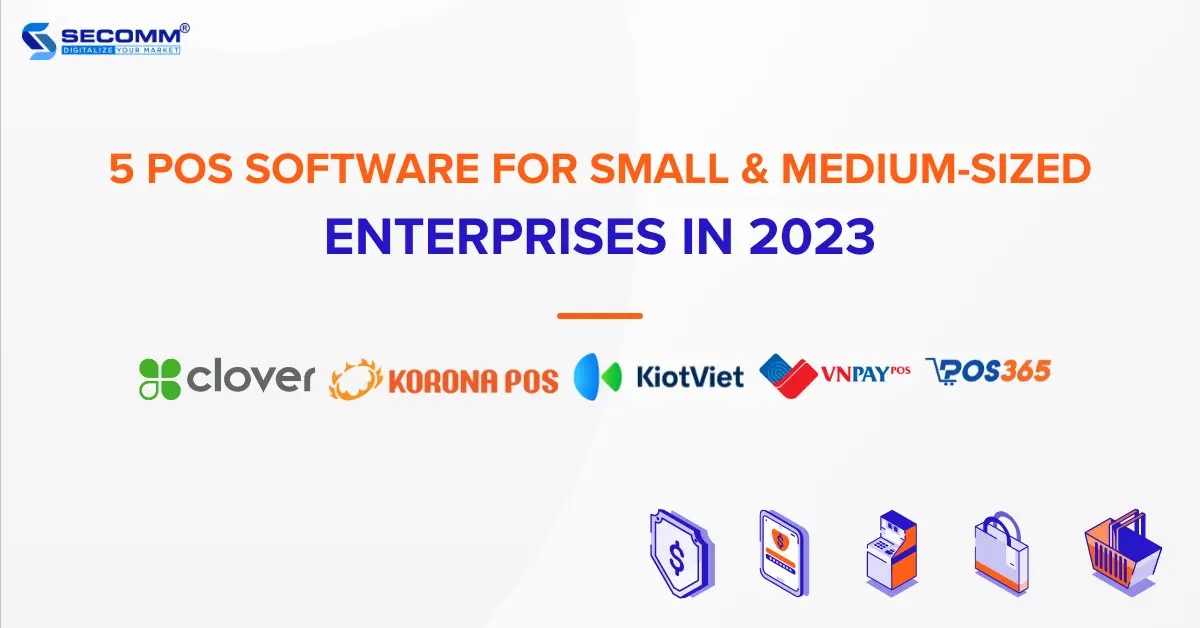
5 POS SOFTWARE FOR SMALL & MEDIUM-SIZED ENTERPRISES IN 2023
Point of Sale (POS) is a system employed by businesses to handle sales transactions, monitor inventory levels, manage customer relationships, generate revenue reports, and conduct business analysis, among other functions. By implementing POS, businesses, particularly SMEs, gain a comprehensive understanding of their operational activities and streamline their management processes.
In this article, SECOMM will evaluate and compare the five most widely-used POS software solutions among small and medium-sized enterprises, including Clover, KORONA POS, KiotViet, and POS365.
Clover
Clover is a POS software developed by Clover Network Inc, aimed at offering an integrated solution for handling sales and payments for both small and medium-sized businesses. Clover provides POS solutions across various industries, including restaurants, services, retail, and more. Specifically, the costs associated with implementing Clover’s POS for retail SMEs are categorized into three primary packages:
- Starter: $799 + $14.95 per month (One-time payment option available) or $60 per month (Monthly payment option) – This package includes an 8″ merchant-facing POS.
- Standard: $1,799 + $49.95 per month (One-time payment option available) or $135 per month (Monthly payment option) – This package includes a 14″ merchant-facing POS
- Advanced: $2,398 + $64.90 per month (One-time payment option available) or $185 per month (Monthly payment option) – This package includes a 14″ merchant-facing and a handheld POS.

Pros
Ease of Use: The Clover interface is intuitive and user-friendly, making it easy to navigate on the touchscreen and access system functions.
Customization: Users have the flexibility to tailor the interface and configure the system to meet their individual needs. This includes modifying screen layouts, customizing function buttons, and setting options to align with specific business operations.
Offline Support: Clover is equipped to function offline, a valuable feature in the event of an internet connection disruption. Transaction data is securely stored and automatically synchronized once connectivity is restored, ensuring uninterrupted business operations.
Cons
High Initial Costs: Clover carries a higher initial price tag compared to alternative POS solutions, particularly for businesses choosing the comprehensive payment package. This may pose a barrier for smaller businesses operating with limited financial resources.
Invoice Formatting Limitations: Clover has some limitations regarding invoice formatting and customization, which can pose challenges for businesses with specific requirements for invoice formats and content. For example, adding special liquor consumption taxes, collecting stamps on invoices for grocery stores, and so on.
Rely on the Clover Ecosystem: Clover POS functions optimally within the Clover ecosystem and may not seamlessly integrate with diverse management systems such as CRM, ERP, etc., offered by different brands.
Korona POS
KORONA POS is a retail system developed by KORONA, intended to assist in sales management, payments, and inventory control for small and medium-sized businesses.
Currently, KORONA POS offers a range of solution packages for businesses to select from:
- Core: $59 per month – Suitable for small businesses or individuals managing a single store.
- Advanced: $69 per month – Geared towards small and medium-sized businesses handling a single store and inventory tracking.
- Plus: $89 per month – Ideal for small and medium-sized businesses managing multiple stores and keeping track of inventory.
- Enterprise: Custom Quote – Tailored for medium-sized businesses with specific customization requirements.
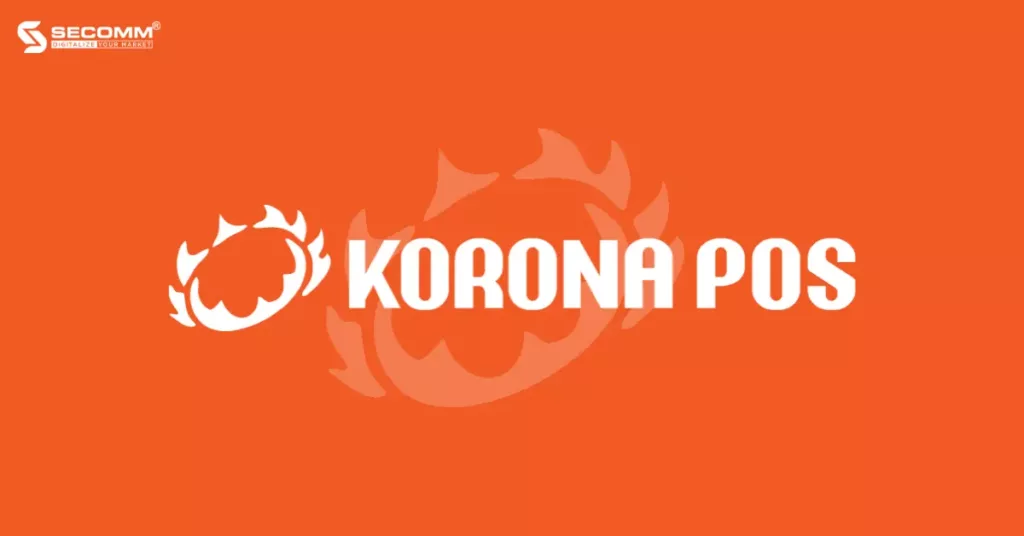
Pros
User-Friendly Interface: KORONA POS boasts a straightforward and user-friendly interface, ensuring ease of use even for employees lacking prior experience with POS systems.
Regular Updates and Upgrades: KORONA POS offers frequent updates and improvements to enhance its features and resolve issues, all while ensuring uninterrupted daily business operations.
Cross-Platform Compatibility: KORONA POS is compatible with multiple platforms, including desktops, laptops, tablets, and smartphones. This flexibility enables sales staff to process transactions and manage sales from virtually any location.
Cons
Internet Required: KORONA POS relies on a continuous internet connection to operate. Disruptions in the network connection can lead to interruptions or even render transactions and management tasks impossible.
Vendor Risk: When businesses adopt KORONA POS, they become reliant on the vendor for system maintenance and upgrades. Any issues or service deviations from the vendor can have an impact on the business’s operations.
POS System Migration Challenges: If a business has been using a different POS system and intends to switch to KORONA POS, the transition process can be intricate and may require a significant investment of time, effort, and resources to migrate all data effectively.
KiotViet
KiotViet is a business management and retail point-of-sale system catering to retail stores and restaurants. KiotViet provides an array of sales management features and tools, encompassing payment processing, inventory control, customer management, order handling, delivery, reporting, and business analysis.
KiotViet offers three options for implementing their POS system:
- Support: 200,000 VND per store per month – Ideal for small businesses, startups, or online retailers.
- Professional: 270,000 VND per store per month – Tailored for professional business models.
- Premium: 370,000 VND per store per month – Suited for businesses with multiple sales channels or a larger staff.
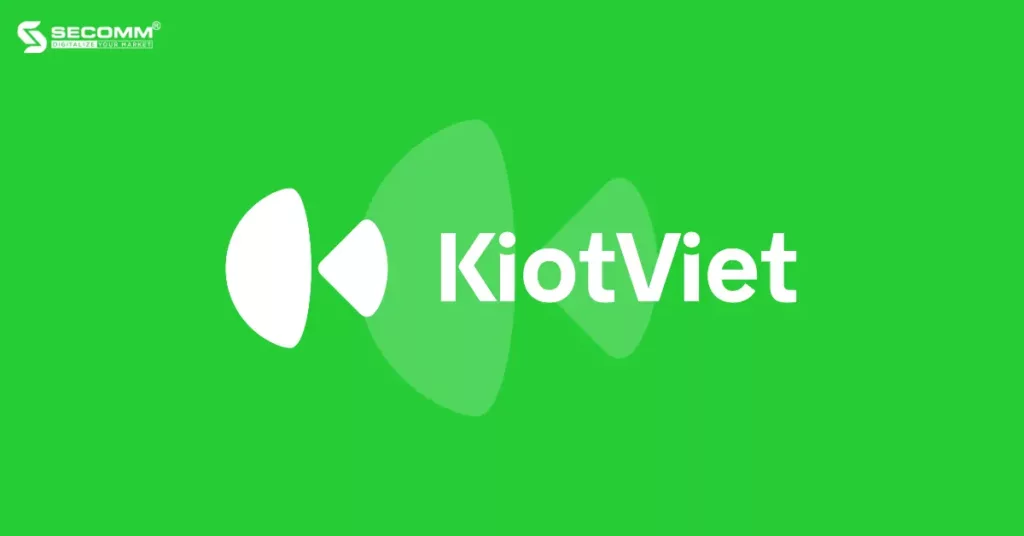
Pros
Ease of Use: KiotViet has a user-friendly interface with tailored support for Vietnamese users, eliminating the need for extensive technical expertise during setup and operation.
Seamless Integration: KiotViet offers flexible integration with various peripherals like printers, barcode scanners, payment devices, and other applications such as inventory management, HR management, and financial systems. This results in a comprehensive POS system for effective business management.
Efficient Inventory Management: KiotViet facilitates efficient inventory management, simplifying the process of updating product information and merchandise categories. Therefore, businesses can maintain control over inventory levels, monitor stock movements, and ensure on-time product availability.
Cons
License fee: KiotViet necessitates monthly or yearly license fee, which may pose challenges for small or recently formed businesses operating with limited funds.
Limited customization: While KiotViet provides some customization options, the capacity for complex customization to cater to individual business requirements may be limited.
Limitations in Niches Industries: KiotViet primarily targets retail and restaurant businesses, which implies that certain features or management procedures may not be well-suited or could be restricted for niche industries such as electronics, pets, agriculture, and others.
VNPAY-POS
VNPAY-POS, an ‘All-in-one’ solution developed by VNPAY, consolidates numerous features into a single device to comprehensively fulfill a business’s sales and payment management requirements.
VNPAY currently extends two primary options to businesses and organization using VNPAY-POS:
- Free service usage for businesses/organizations with payment fees exceeding 275,000 VND/month. For payments lower than this threshold, a flat fee of 275,000 VND/month/machine is applicable.
- Device rental is available at an affordable rate of just 165,000 VND/month. Businesses/organization achieving payment volumes surpassing 30,000,000 VND/month/machine qualify for free device rental.
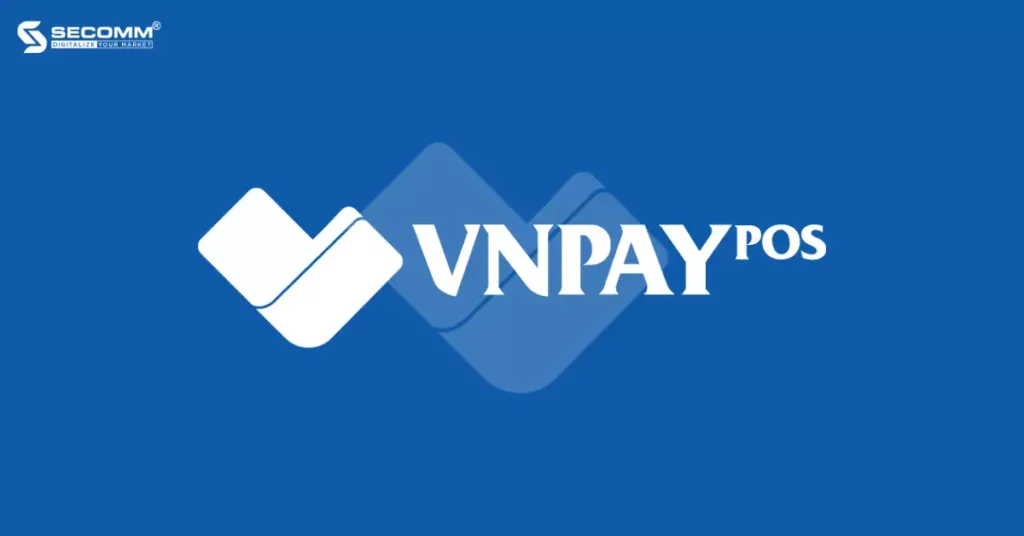
Pros
Diverse Payment Methods: VNPAY-POS allows businesses and individuals to accept payments from customers using a range of electronic payment methods, including e-wallets, bank cards, QR codes, and bank transfers.
Appealing Incentives and Comprehensive Support: In addition to its core features, the solution offers advanced functionalities like support for 0% installment plans, cross-selling services, quick and professional 24/7 registration assistance.
Optimized Sales and Business Management: A VNPAY SmartPOS device goes beyond payment processing, performing various tasks such as digital menu display, item selection, order placement, invoice printing, sales management, data extraction, and more. This streamlines operational costs for businesses.
Cons
Ongoing Costs: VNPAY POS may entail increasing monthly ongoing costs or transaction charges for payment processing, potentially straining businesses with limited financial resources.
Feature Limitations: In comparison to certain other POS systems, VNPAY-POS has limitations in its feature set, particularly in tailoring solutions to meet the specific needs of individual businesses.
Hardware Compatibility: VNPAY-POS mandates specific hardware prerequisites for operation, such as tablets or mobile devices supported by VNPAY. This could necessitate an initial investment for adopting VNPAY-POS.
POS365
POS365 is a cloud-based POS system developed by 365 Technology Corporation. POS365 provides a comprehensive solution for retail businesses, restaurants, cafes, and related industries.
Currently, POS365 offers three packages for businesses:
- Basic: 1,650,000 VND for 12 months – Designed for businesses looking to experience the product.
- Popular: 3,300,000 VND for 2 years with an additional 1-year free – Tailored for SMEs.
- Lifetime: 6,600,000 VND for a lifetime – Intended for businesses already familiar with POS365.
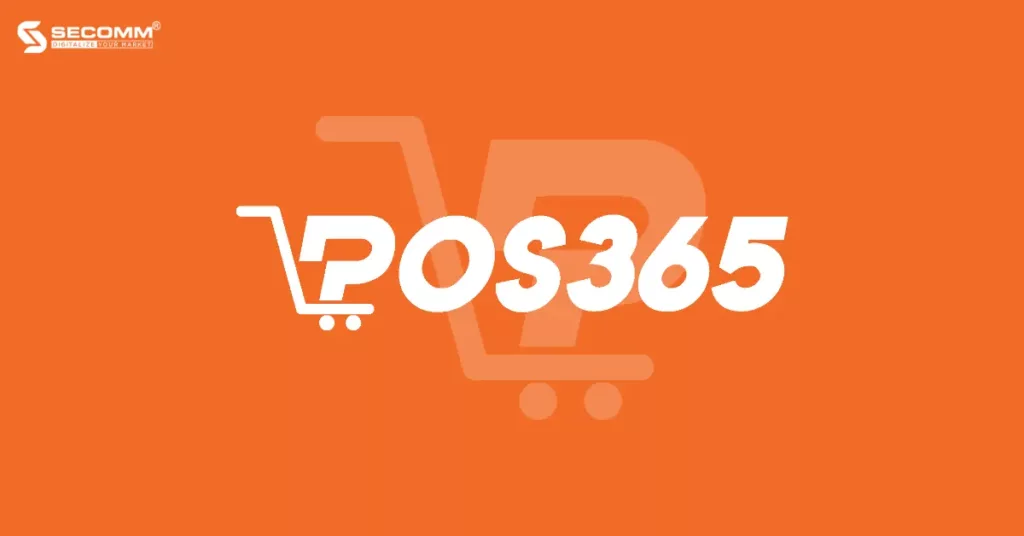
Pros
Vietnamese business-friendly: POS365 has a modern interface that’s easy to navigate, with features thoughtfully tailored to Vietnamese business practices.
Diverse Features: POS365 offers a comprehensive set of sales and business management tools, encompassing inventory control, order processing, warehouse management, customer relations, staff oversight, and business reporting.
Multi-Branch Management: POS365 facilitates the management of multiple branches and sales points through a unified system, simplifying business expansion and operation oversight.
Cons
Limited customization: POS365 comes with certain limitations regarding customization and specific business requirements adjustments. This can pose challenges for businesses with unique needs or customization preferences.
Internet required: POS365 relies on a stable internet connection to function. If there’s an internet disruption, payment processing and business management may experience interruptions.
Limited security: Because POS365 is an online system, there’s a higher risk of cyberattacks or data breaches. Businesses need to implement appropriate security measures to safeguard customer information and business data.
Related content: Top 5 best POS software for large-scale enterprises in 2023
Above is a brief overview of 5 POS software solutions widely used by SMEs to enhance business efficiency. Businesses need to consider various factors to select the most suitable POS system.
 2
2

 9,750
9,750

 0
0

 1
1
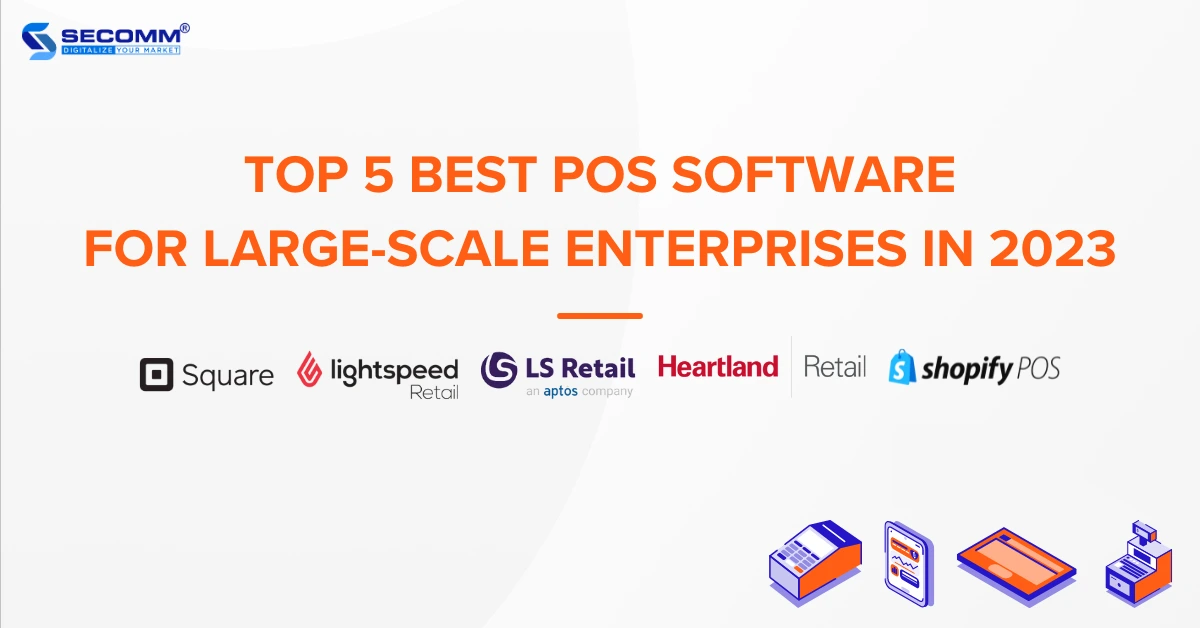
TOP 5 BEST POS SOFTWARE FOR LARGE-SCALE ENTERPRISES
Much like searching for the right eCommerce platform that fits a business model, the quest for a suitable POS system can be equally challenging, especially for large enterprises.
In this article, SECOMM will delve into the top five widely favored POS software solutions by large corporations today, including Square, Lightspeed Retail, LS Retail, Heartland Retail, and Shopify POS.
Square Point of Sale
Square POS, developed by Square, is a highly favored POS system among many international large-scale enterprises due to its cost-free setup. However, Square applies fees for each transaction executed on the POS, amounting to 2.6% and 10 cents for every tap, dip, or swipe. For the ‘Buy Now, Pay Later’ payment scheme, the fees are 6% and 30 cents. Furthermore, Square provides a tailored POS package for businesses generating revenue exceeding $250,000.
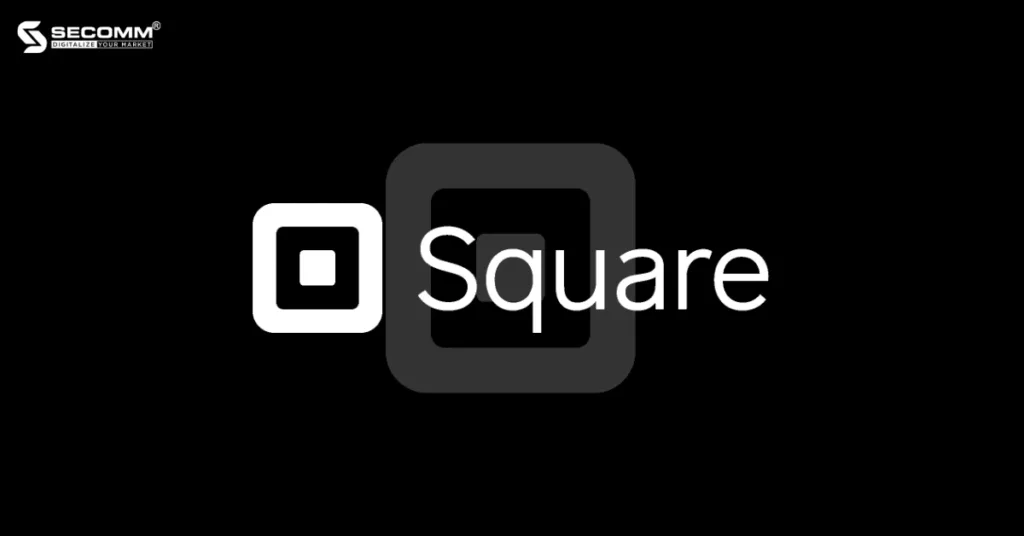
Types of POS system: Tablet-based POS system, Mobile POS system, Cloud-based POS system.
Pros
It’s free: Square software is completely free to use, without any charges for setup or monthly licenses.
It’s User-Friendly: Square offers a straightforward and intuitive user interface, making it easy for users to quickly adapt to and utilize the system effectively.
It’s flexible: Square empowers businesses to execute sales transactions from virtually anywhere using mobile devices like smartphones or tablets. This flexibility enables businesses to reach and serve customers at any time and place.
Cons
Costs Increase with Each Transaction: Square applies transaction fees (2.6% + 10 cents) to every payment processed. While its fee structure is relatively competitive, businesses with substantial sales volumes may find these fees impacting their overall profitability.
Limited Hardware Compatibility: Typically, POS systems are designed to work seamlessly with hardware provided by Square. This means that businesses might encounter challenges when attempting to utilize hardware from alternative suppliers or integrate with existing brand-specific POS systems.
Feature Constraints: Square does have some feature limitations compared to other POS systems. For instance, functionalities like multi-store management, membership card integration, or compatibility with various other business management software may be limited.
Lightspeed Retail
Lightspeed Retail is a tailored POS solution crafted for businesses operating across diverse industries. It earns praise for its wide-ranging features, high level of customization, and its seamless integration capabilities with various applications and services.
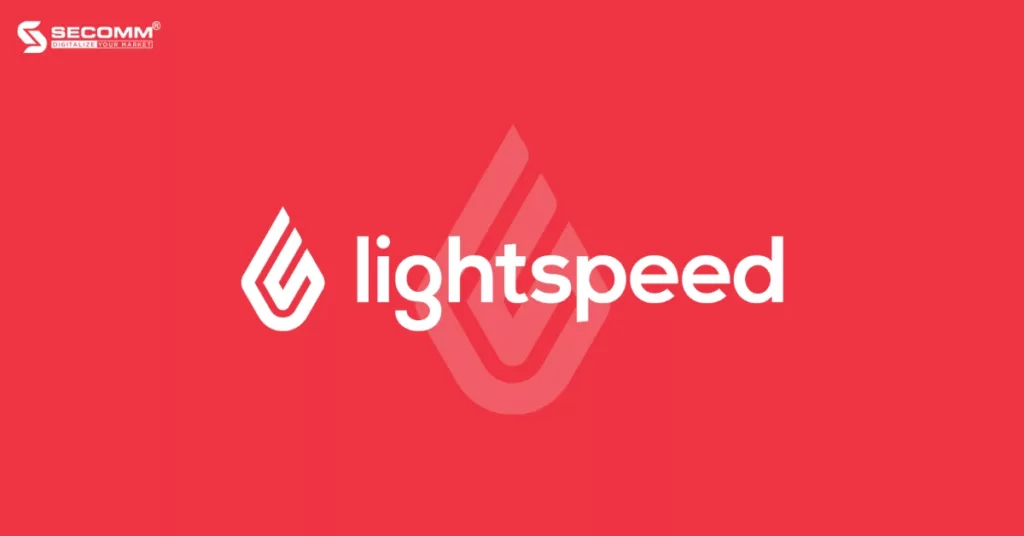
Types of POS system: Tablet-based POS system, Mobile POS system, and Cloud-based POS system.
Pros
Multi-Industry: Lightspeed Retail is specifically crafted to cater to a wide array of industries, including retail, restaurants, coffee shops, spas, salons, and more. This versatility positions Lightspeed as a multifunctional solution across various sectors.
Integration and Scalability: Lightspeed seamlessly integrates with numerous other applications and services, encompassing inventory management systems, online ordering platforms, integration with online sales channels, and much more. This flexibility enables businesses to scale and tailor the system to meet their unique requirements.
Customer Support: Lightspeed earns accolades for its top-notch customer support, offering assistance through phone, email, and online channels. The friendly and professionally trained support team is adept at resolving a multitude of issues.
Cons
High Costs: Lightspeed is associated with a higher price point in comparison to several other available POS solutions in the market.
Complex Initial Setup: The initial setup and configuration of Lightspeed can prove intricate for users lacking prior tech experience. Accurate installation, coupled with appropriate configuration, is essential to guarantee stable operation.
Internet Required: As an online POS system, Lightspeed relies on a consistent internet connection for optimal performance. Any disruptions or instability in the internet connection can lead to transaction processing issues and hinder system access.
LS Retail
LS Retail stands as a top-tier provider of POS and ERP software grounded in the Microsoft Dynamics platform. It is meticulously tailored to oversee the entirety of business operations across diverse sectors, including retail, restaurants, hotels, pharmacies, and gas stations.
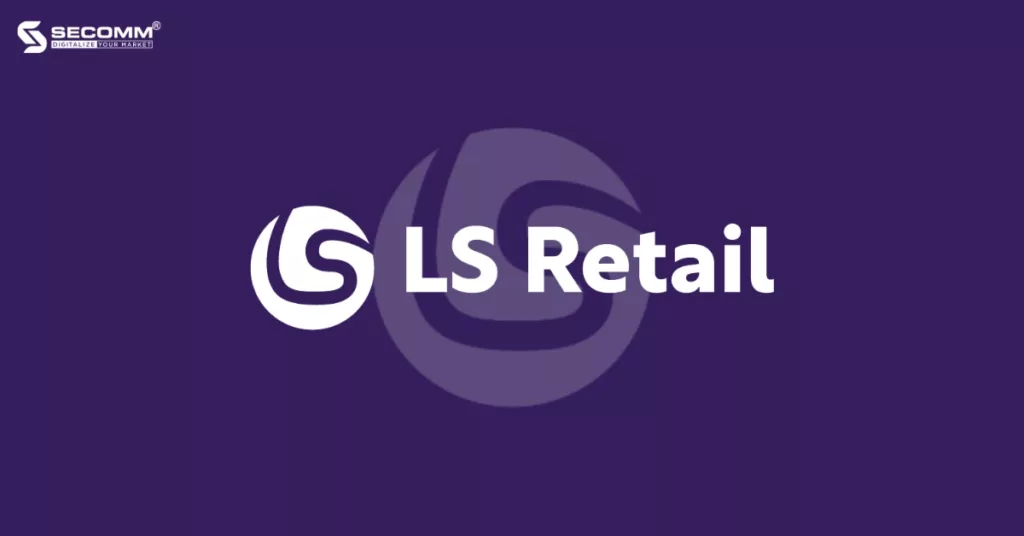
LS Retail extends three solution packages for businesses to select from:
- LS Express: Priced at $99 per month, this solution caters to small-scale businesses.
- LS Central: Offering a comprehensive POS and ERP solution for businesses (Development costs vary based on project complexity).
- LS First: Strategically designed for large corporations, with a particular emphasis on the restaurant industry (Development costs vary based on project complexity).
Types of POS system: Tablet-based POS system, Mobile POS system, and Cloud-based POS system.
Pros
Holistic Management: LS Retail offers an integrated POS and ERP solution, facilitating the synchronization of business data and more efficient management across both systems.
Multi-Channel Sales: LS Retail supports a diverse array of sales channels, encompassing traditional brick-and-mortar stores, eCommerce websites, and mobile point-of-sale (mPOS) kiosks. This broadens business horizons, reaching a larger pool of potential customers.
Efficient Inventory Management: LS Retail delivers real-time inventory management algorithms, empowering businesses to govern stock levels, item locations, and optimize procurement processes. This results in reduced shortages and excess inventory, ultimately enhancing operational efficiency.
Cons
High Costs: As LS Retail is a comprehensive POS and ERP solution, both ownership and maintenance costs may be considerably high for businesses.
Technical Expertise Required: Implementing LS Retail mandates that your business’s workforce possesses specialized technical skills and undergoes dedicated training
Dependency on Microsoft Dynamics: LS Retail is built on the Microsoft Dynamics platform, meaning the implementation and enhancement of the LS Retail system hinge on the evolution of Microsoft Dynamics, influencing bug fixes and the incorporation of the latest updates to some degree.
Heartland Retail
Heartland Retail is a cloud-based point-of-sale (POS) platform tailor-made for retail businesses.
As of now, Heartland levies a fee of $89 per month per point of sale for their POS software. Furthermore, this platform provides payroll services starting at $89 per month for 1-5 employees and payment processing services with a cost of 2.6% per successful transaction, alongside 10 cents for each tap, dip, or swipe.
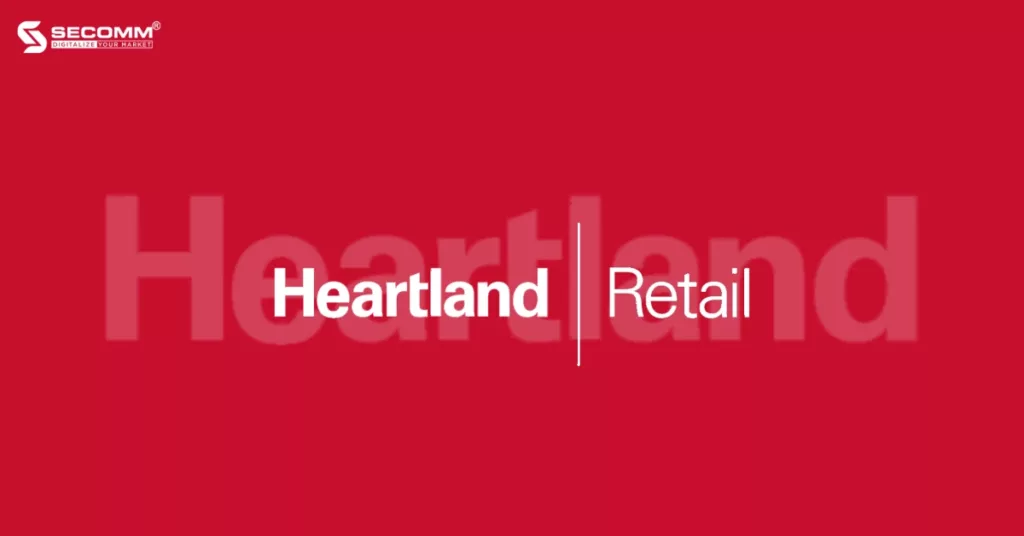
Type of POS system: Cloud-based POS system
Pros
User-Friendly Interface: Heartland Retail boasts a user-friendly and intuitive interface. Sales staff can easily navigate between functions, process payments, and engage with customers effortlessly.
Smart Reporting and Analysis: Heartland Retail offers sophisticated analytical tools and reporting capabilities, empowering businesses to gain a deeper insight into their performance and consumer trends.
Integration with Auxiliary Systems: Heartland Retail is equipped to seamlessly integrate with various auxiliary systems, including accounting, human resources management, and customer relationship management (CRM) systems. This integration facilitates the creation of a comprehensive information system, enhancing the efficiency of different departments within the organization.
Cons
Inefficient Customer Support: Numerous customer feedback reports cite limitations in customer support, with varying response times from Heartland Retail’s support team and inconsistent answers or solutions. This can pose difficulties for businesses requiring swift assistance or specific solutions.
Multi-Store Management Constraints: Heartland Retail lacks robust and flexible multi-store management features for companies operating beyond the U.S., as the company’s primary headquarters is exclusively located in the U.S.
Limited New Features and Updates: Heartland Retail doesn’t frequently introduce new features and updates, unlike some other POS systems. This limitation may hinder the adoption of the latest technologies and trends in the industry.
Shopify POS
Shopify POS is a POS solution designed by Shopify, catering to businesses utilizing their platform and seeking sales management software to effectively manage their business affairs. The usage cost for Shopify POS amounts to $89 per month per location, with a reduced rate of $79 per month per location for businesses opting for an annual subscription.
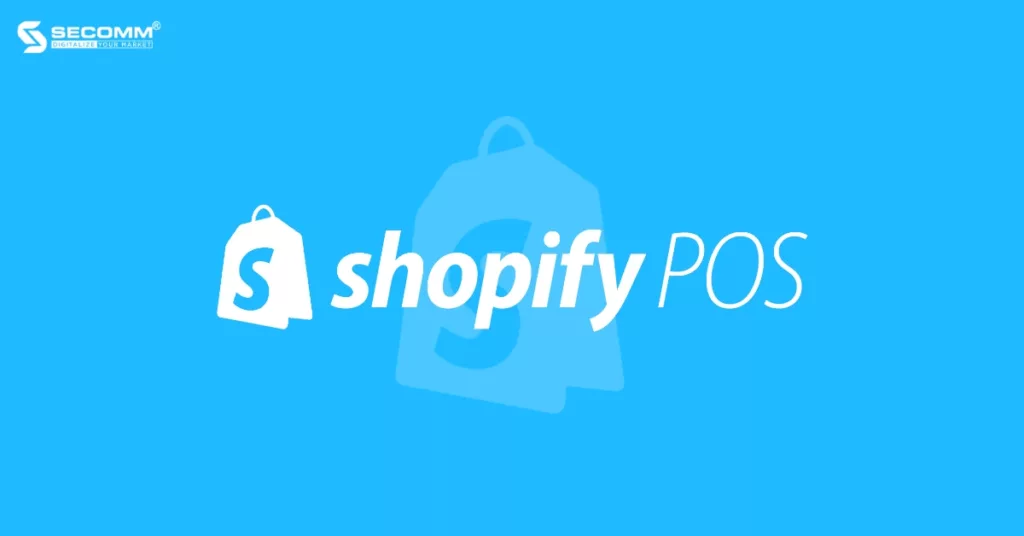
Pros
Ease of Use: Shopify POS boasts a straightforward and friendly admin interface, designed for quick staff adaptation, reducing training time, and minimizing data entry errors.
Seamless Integration with the Shopify Platform: It smoothly integrates with eCommerce websites built on the Shopify platform, enabling businesses to efficiently manage both physical and online stores from one centralized platform, resulting in time and resource savings.
Customization: Shopify POS enables businesses to customize the interface, product labels, invoices, and create brand introduction pages for brick-and-mortar stores, among other features.
Types of POS system: Tablet-based POS system, Mobile POS system, Cloud-based POS system
Cons
Exclusive to the Shopify System: Since this software is built by Shopify, it can only be integrated with this platform.
Complexity with Multiple Stores: While Shopify POS offers multi-store management capabilities, handling and configuring various stores can become intricate as the number of stores grows. Businesses must invest sufficient time in meticulous management, maintenance, and information updates for each individual store.
High Transaction Fees: When using Shopify POS, businesses are required to pay transaction fees (ranging from 2.4% to 2.6%) for each transaction. These fees can add up, especially for businesses with a large volume of transactions.
Above is a brief comparison of five POS software systems widely used by many large businesses to enhance the efficiency of their operations. Businesses need to consider various factors to select the most suitable POS system.
 2
2

 15,207
15,207

 1
1

 2
2
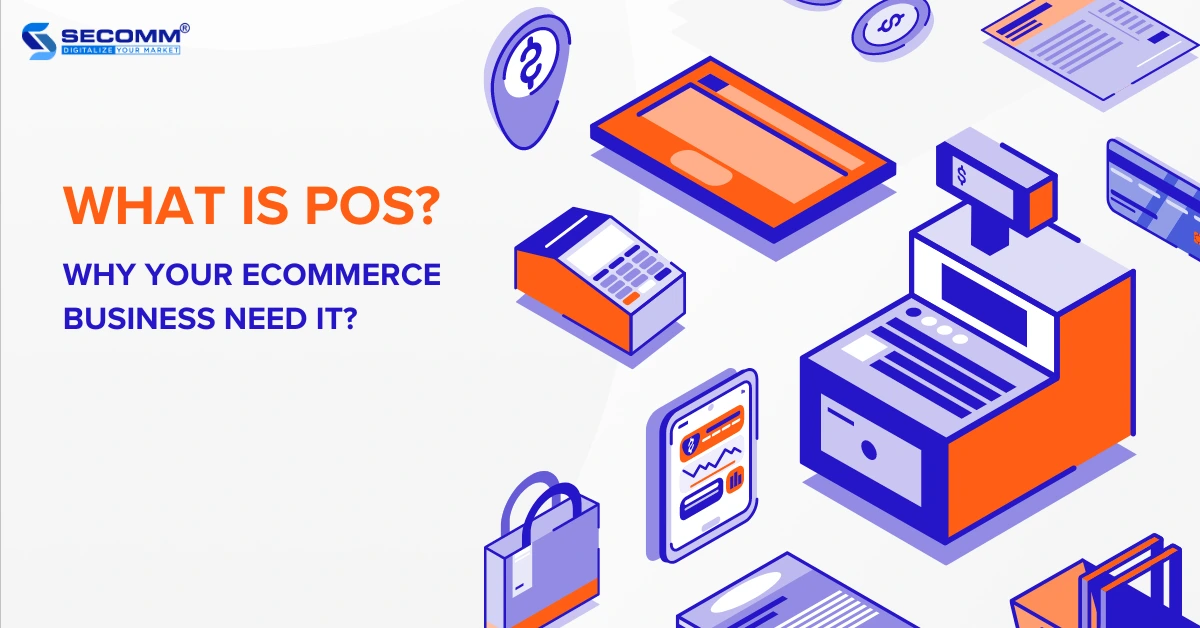
WHAT IS POS? WHY YOUR ECOMMERCE BUSINESS NEED IT?
The Point of Sale (POS) software system stands as a crucial management system for all types of enterprises, be it online, offline, or O2O (online to offline) businesses.
What is POS?
POS or Point of Sales is sales management software that empowers businesses to efficiently monitor all their business activities, anytime and anywhere. In essence, POS is a complete system comprising both hardware and software components, or it can be as straightforward as a point-of-sale device, such as a computer, tablet, smartphone, receipt printer, and so on.
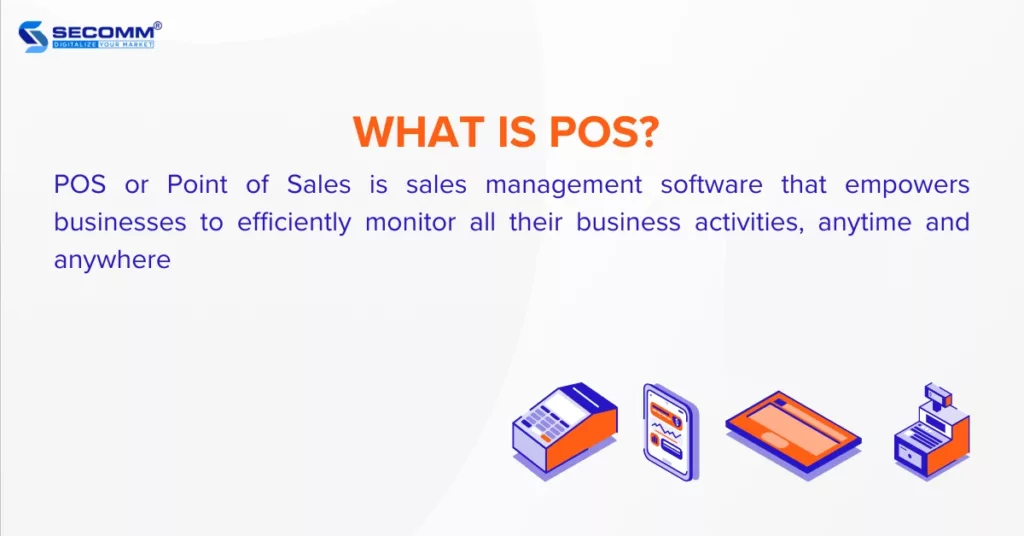
With its robust management capabilities, POS helps businesses oversee and process sales transactions, calculate payments, generate invoices, manage inventory, handle customer relationships, and deliver crucial insights regarding sales performance.
Types of POS system
There are four main types of POS systems that businesses commonly use today, including Legacy POS system, Tablet-based POS system, Mobile POS system and Cloud-based POS system.
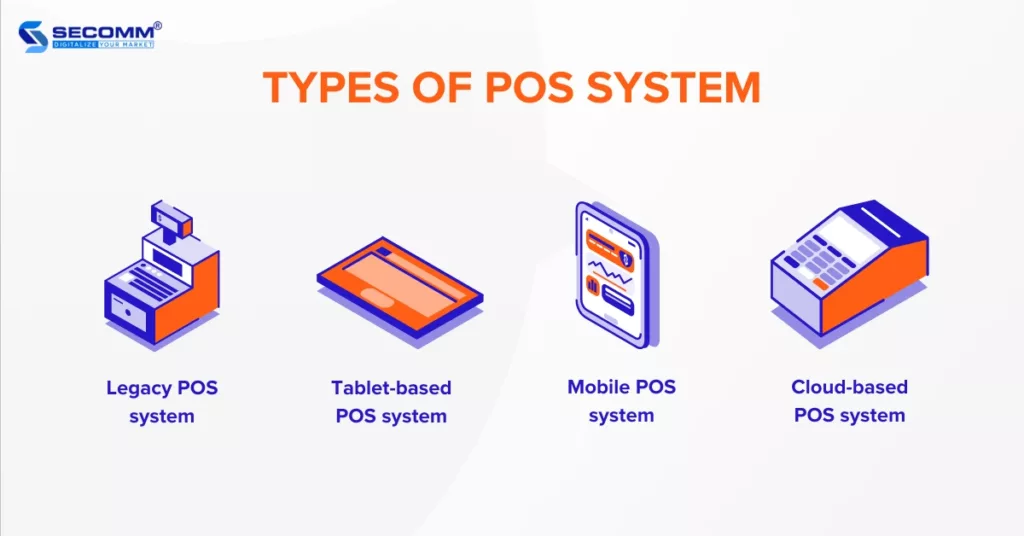
Legacy POS system
The Legacy POS system, also known as on-premise POS, is a type of point-of-sale system that relies on conventional hardware and software to handle sales transactions and manage local data. This means that all transactions and information are stored on a single device, with businesses only able to access the data from that specific device.
As a result, traditional POS systems often require installation and configuration at each individual point of sale, and they typically lack remote accessibility. This can slow down the integration process with eCommerce systems.
For example, some legacy POS systems include Aloha, Oracle MICROS, Squirrel Systems, and more.
Tablet-based POS system
A Tablet-based POS system is a type of POS system that employs tablets as the main devices for processing sales transactions, rather than relying on conventional computers or standalone POS equipment.
Due to its reliance on hardware that is familiar to many, integrating this POS system with eCommerce platforms and training staff tends to be more straightforward compared to legacyPOS systems.
Examples of well-known Tablet-based POS systems include Lightspeed POS, Square, Shopify POS, and others.
Mobile POS system
A Mobile POS system is a type of POS that employs mobile devices like smartphones, tablets, or wearable devices for handling sales transactions. This allows sales staff to move freely within the store or conduct transactions directly at the customer’s location.
This functionality enables sales associates to access product details and customer records via the Mobile POS system, facilitating inventory checks and offering personalized recommendations to customers. Just like Tablet-based POS systems, integrating and training staff to use Mobile POS systems is generally uncomplicated.
Some widely used Mobile POS systems include Lightspeed POS, Clover, Square, and others.
Cloud-based POS system
A Cloud-based POS system leverages cloud computing technology to store and process sales data. Instead of keeping data on local computers or in-house servers, this system adopts an online approach to manage and access data from any device with an internet connection.
The majority of modern POS systems are cloud-based because they offer various advantages, including remote accessibility, flexibility, easy integration, and scalability. They enable businesses to oversee multiple points of sale from a unified platform, providing real-time data and insights for informed decision-making. Furthermore, Cloud-based POS systems reduce hardware demands and installation costs when compared to other POS solutions.
Some prominent examples of top Cloud-based POS systems for businesses include Lightspeed POS, Square, Clover, and others.
Benefits of using POS software
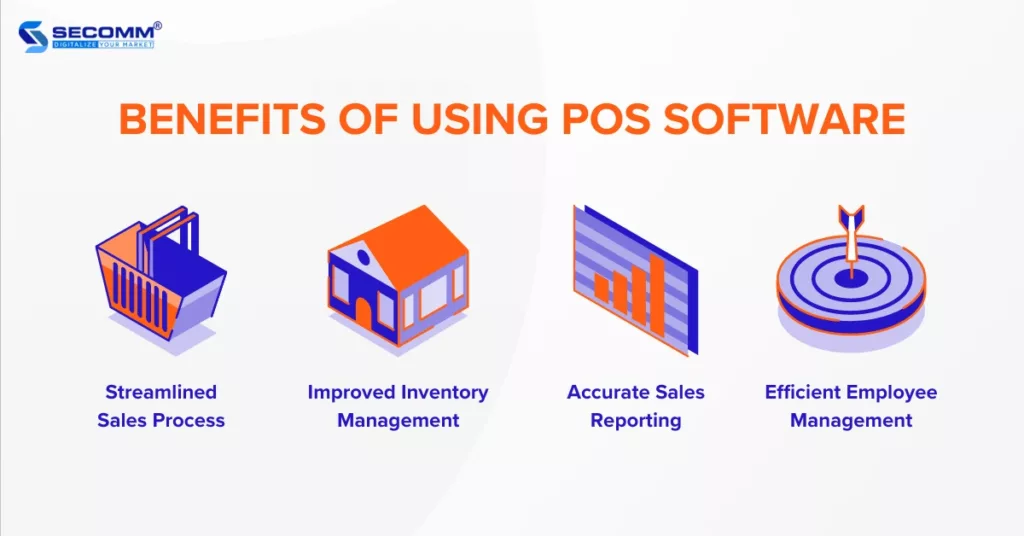
Streamlined Sales Process
The POS system streamlines and automates the sales process, ensuring faster and efficient transactions. Businesses can swiftly process payments, precisely calculate totals, and produce invoices or receipts within mere seconds.
Improved Inventory Management
The POS system empowers businesses to actively monitor and manage their inventory in real-time, receiving alerts when products are running low and automatically initiating reorder processes. This helps prevent stock shortages or excess inventory, ultimately optimizing inventory levels and reducing storage expenses.
Accurate Sales Reporting
The POS system offers the ability to analyze and report detailed revenue data, empowering businesses to monitor their performance, understand consumer trends, identify favored products, and so forth. Consequently, this data forms the basis for businesses to strategize for the future.
Efficient Employee Management
The POS system simplifies the process of monitoring each employee’s sales volume, work hours, and performance indicators. Consequently, businesses can obtain precise data for calculating individual commissions, streamline payroll processing, and identify high-performing team members or those requiring further training.
Overall, POS stands as a vital management software within any eCommerce business framework. Businesses should conduct thorough research on different POS system types to choose the most fitting and effective management software in line with their business model and strategy.
Contact SECOMM or dial our Hotline at (02871089908) for consultation and the implementation of your POS system
 2
2

 9,300
9,300

 0
0

 1
1
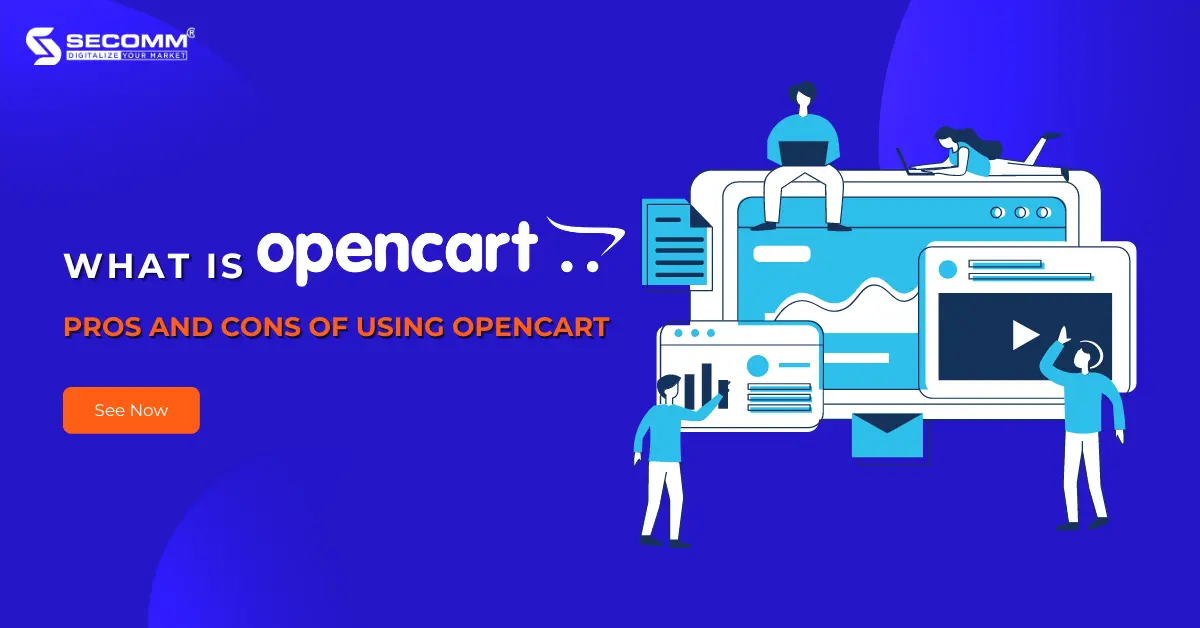
WHAT IS OPENCART? 7 KEY PROS AND CONS OF USING OPENCART
The eCommerce platforms are often considered the “backbone” of any experienced business in the market. To embark on the eCommerce journey, your business needs to choose the right eCommerce platform to build your website.
In addition to Magento, WooCommerce, Shopify, Squarespace, PrestaShop, etcOpenCart become a popular choice for many international SMEs.
What is OpenCart?
OpenCart is an open-source eCommerce platform based on the PHP programming language, developed by Daniel Kerr in 1998. Currently, OpenCart offers two versions: Free and Cloud Store (Paid).
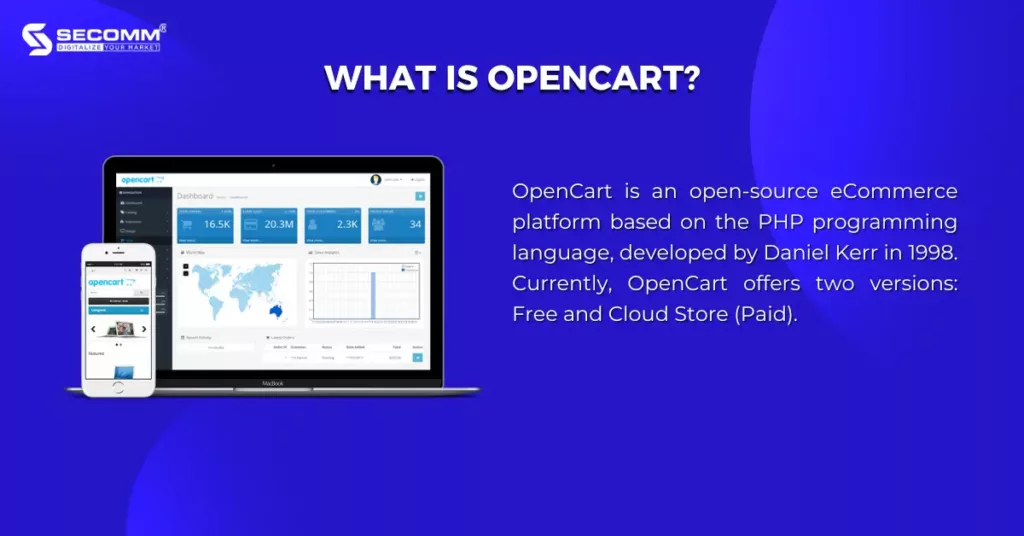
For the Cloud Store version, you have three solution options to build your eCommerce website:
- Bronze: €59/month, for small businesses (1 CPU 2GB)
- Silver: €99/month, for medium-sized businesses (2 CPU 4GB)
- Gold: €199/month, for enterprise-level businesses (4 CPU 8GB)
According to BuiltWith, there are over 2,500 websites built on this platform. Some famous brands using OpenCart include WeLoveFine, GT Omega, Arrowfile, and Kleshna.
The Pros of Using OpenCart
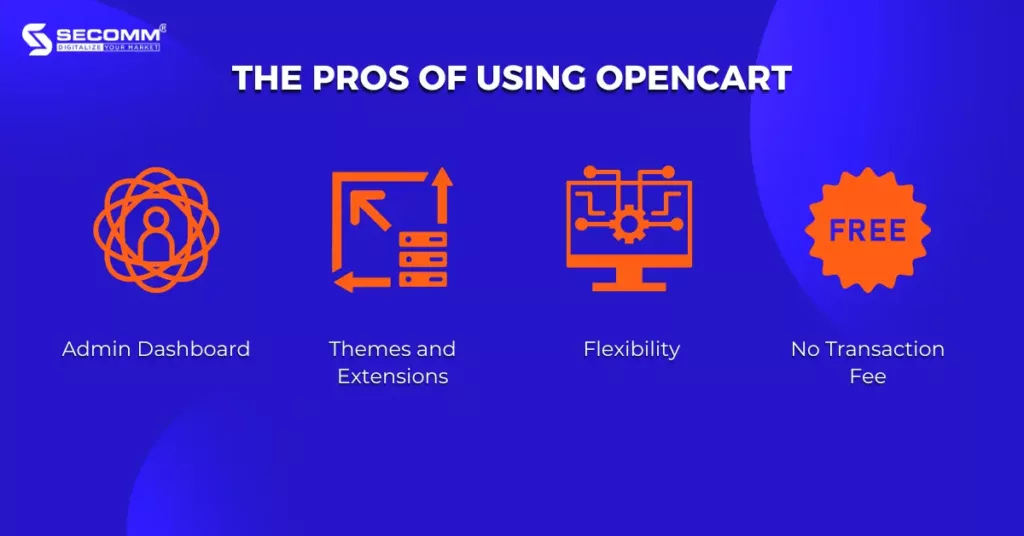
Admin Dashboard
OpenCart is a user-friendly platform, even for those without technical experience. You don’t need to invest much time in training staff to manage products, orders, customer information, or other features on the website.
Themes and Extensions
Over the years, OpenCart’s marketplace has offered more than 13,000 functional modules and ready-to-use themes. You can find suitable themes for any industry along with 3rd-party extensions, payment gateways, shipping providers, marketing tools, analytics, and reporting, which enrich your journey of building an eCommerce system.
Flexibility
With its nature as an open-source eCommerce platform, OpenCart has the ability to be flexibly customized. Also, you can own and control the entire source code. That said, you’ll customize code components, create updates, or even develop new features within the system based on your needs.
In addition, OpenCart also has good scalability, enabling you to upgrade to multiple languages and currencies for your global expansion goals.
No Transaction Fee
For eCommerce platforms like Shopify, and BigCommerce, operating on a licensing model. This means they charge fees for platform usage on a monthly/yearly basis. These platforms typically charge an average transaction fee of 1.5% to 2% per transaction. On the contrary, OpenCart’s Cloud Store version charges no fees.
The Cons of Using OpenCart
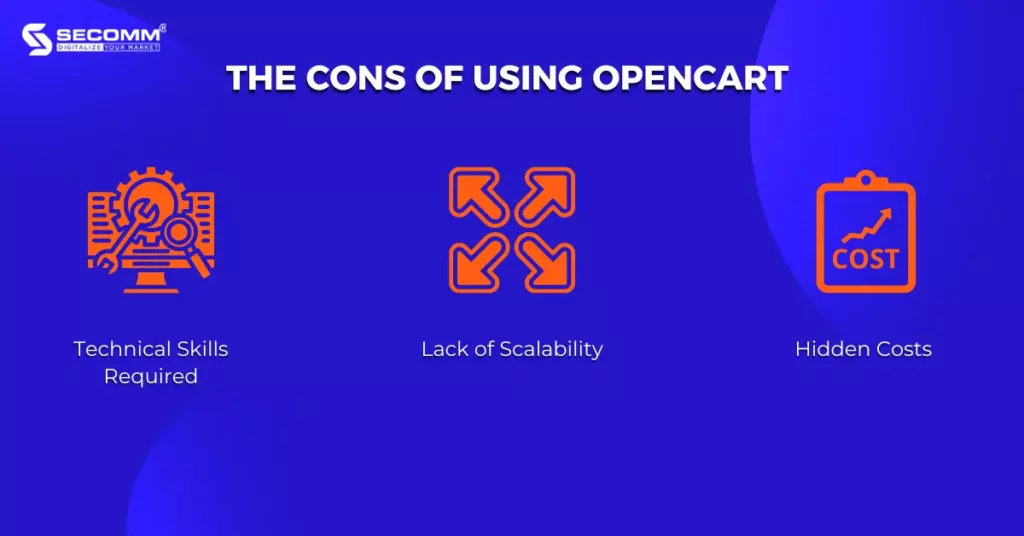
Technical Skills Required
OpenCart is an open-source platform built with one of the most complex programming languages — PHP. That means, to successfully develop your own eCommerce website, you should build a skilled in-house team or collaborate with an experienced agency.
Lack of Scalability
Although OpenCart offers many features, it may not be sufficient for you to manage and operate your complex eCommerce website. It’s different when compared to another PHP-based open-source eCommerce platform like Adobe Commerce (also known as Magento). Adobe Commerce allows you to expand from one website to multiple websites while managing them under the same system effectively.
Hidden Costs
It’s worth noting that OpenCart doesn’t charge transaction fees and it’s affordable cost of using OpencCart’s Cloud Store compared to other platforms. However, you need to add up the expenses for integrating various extensions. Each extension typically costs a minimum of $20 per month.
But if you want to create a comprehensive eCommerce website system, you may need at least 10 extensions. As a result, when opting for OpenCart, you should be aware of the potential hidden costs associated with these extensions.
OpenCart, with its own set of pros and cons, is generally a suitable eCommerce platform for small and medium-sized enterprises (SMEs). However, large-sized businesses looking for open-source eCommerce solutions may find platforms like Magento or Shopify Plus more fitting.
Having in-depth expertise and a track record of successfully developing complex eCommerce systems on Magento, such as Laybyland (Australia, US, New Zealand), Jasnor (Australia, New Zealand), and An Nam Group (Vietnam), SECOMM understands the challenges that businesses encounter when selecting and implementing an open-source eCommerce platform.
Get in touch with SECOMM today or call directly to the hotline at 02871089908 for a free consultation on tailored solutions for your eCommerce system development needs!
 2
2

 8,190
8,190

 0
0

 1
1
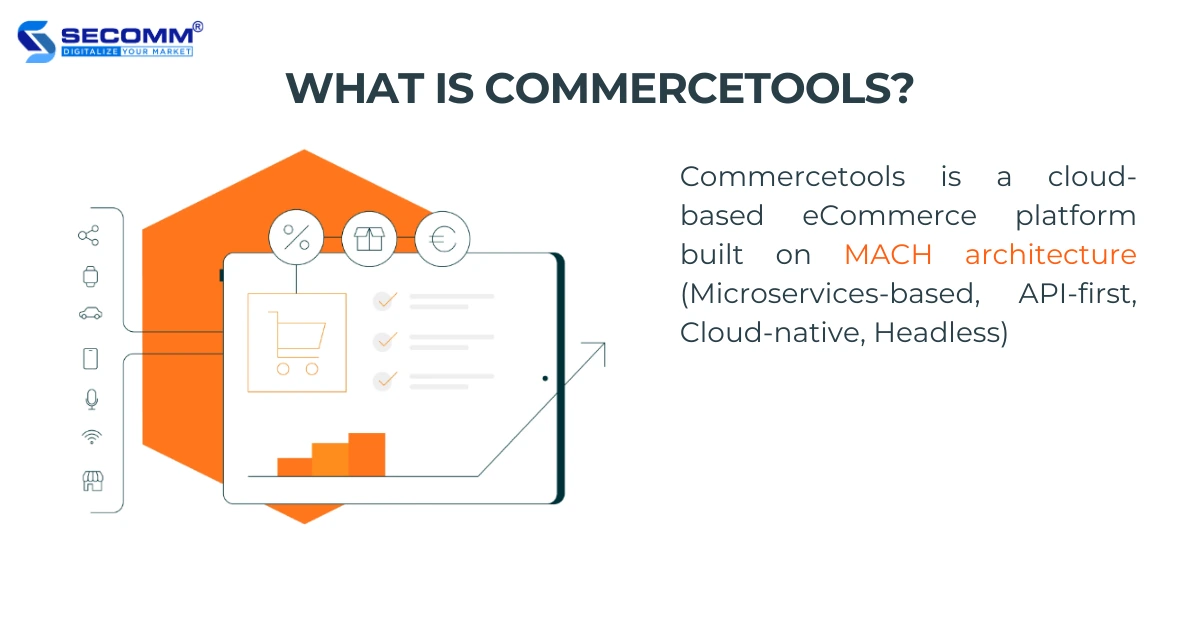
WHAT IS COMMERCETOOLS? 6 IMPORTANT PROS AND CONS OF COMMERCETOOLS
Selecting the right platform to build an eCommerce website is always the first and foremost step in entering the billion-dollar market of online business.
According to Builtwith, there are more than 200 eCommerce platforms for building websites, with popular ones like Magento, WooCommerce, Shopify, and Wix leading the pack. Among them, there is one platform that many enterprise-level businesses favor, and that is Commercetools.
Since September 2021, Commercetools has raised a total of $308.1 million through six rounds of funding. In 2022, the platform achieved a net revenue milestone of $39.1 million, demonstrating its growth potential in the eCommerce industry.
What is Commercetools?
This is a cloud-based eCommerce platform built on MACH architecture (Microservices-based, API-first, Cloud-native, Headless), allowing you to tailor your eCommerce experience to fit the exact needs of your business and customers.
Beyond this, Commercetools is the creator of Headless Commerce solution, which enables you to customize and intercharge the backend and frontend without affecting each other.
Due to years of investment in eCommerce technology, it has been recognized as a ‘Leading platform’ by reputable consulting firms such as Gartner Magic Quadrant, Forrester B2C Commerce Solutions Wave™, and IDC MarketScape: Headless Digital Commerce.
Some well-known brands that are using the platform include Audi, BMW, Volkswagen, Qantas, and more
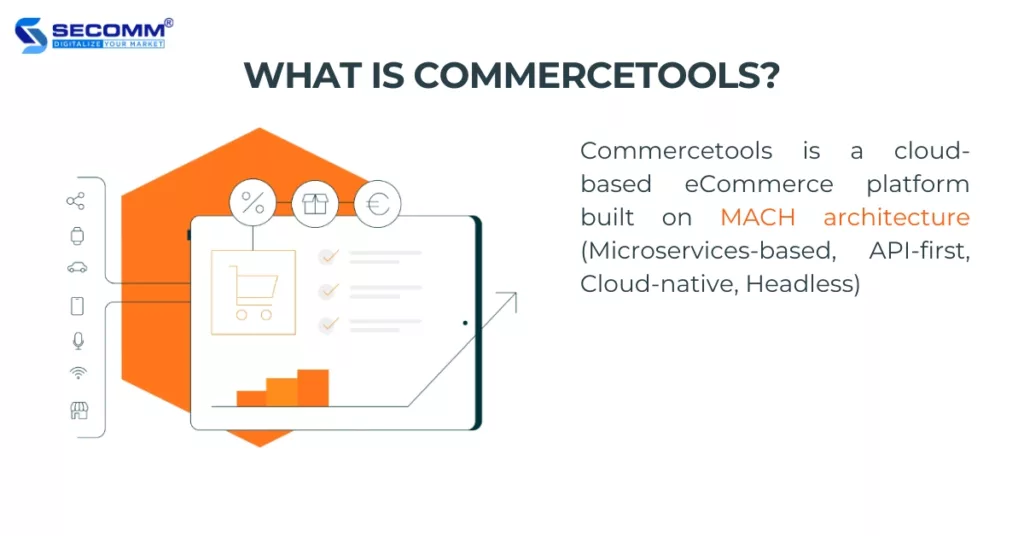
How does Commercetools work?
Microservices-based
Microservices-based is a software development architecture where applications are divided into smaller and independent components. In an eCommerce system, each microservice takes responsibility for a specific function and can undergo independent development, deployment, and management, separate from other microservices.
The Microservices-based architecture enhances flexibility and scalability, enabling developers and admins to easily maintain and update system components without affecting other parts.
This approach allows Commercetools to deploy frontend and backend components independently, resulting in faster, more reliable, and responsive performance compared to traditional approaches.
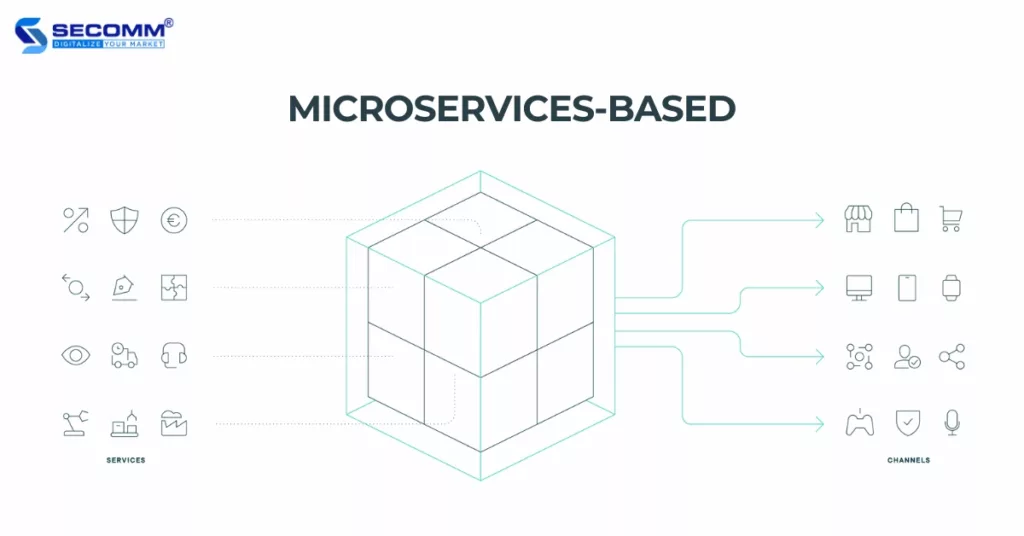
API-first
API-first is a software design approach that focuses on building Application Programming Interfaces (APIs) before developing an eCommerce system. Instead of developing the system first and then building corresponding APIs, API-first requires developers to define the necessary APIs upfront and then use these APIs to develop the entire eCommerce system.
This approach enhances system flexibility and scalability, reduces development time and ensures the compatibility and interaction between various functionalities.
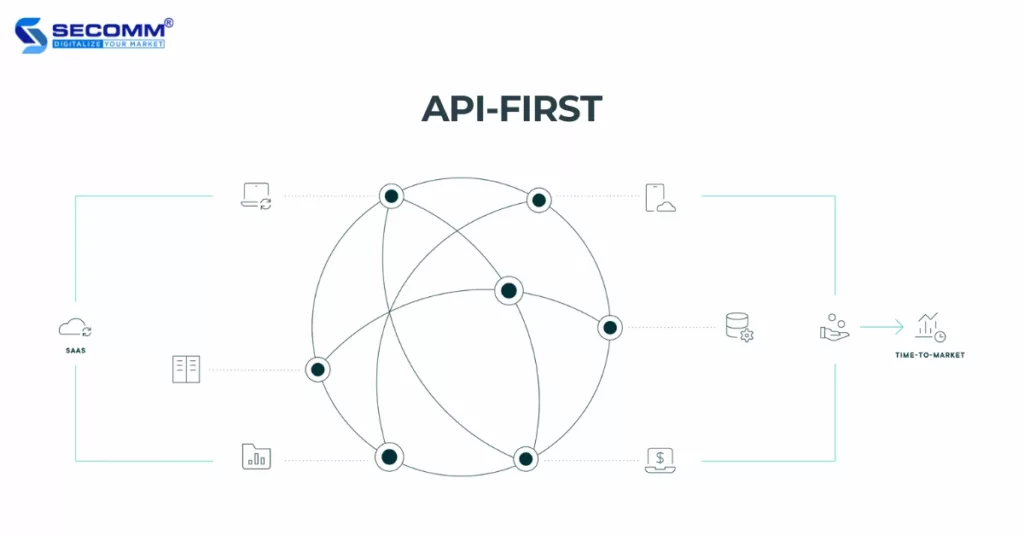
Currently, Commercetools provides over 300 separate APIs that you can use to build your eCommerce website.
Cloud-native
Cloud-native is a development and deployment architecture designed to leverage the cloud features such as flexibility, availability, security, and automation.
This architecture typically involves using distributed applications, microservices, automation and integrating extensions to achieve high readiness and scalability.
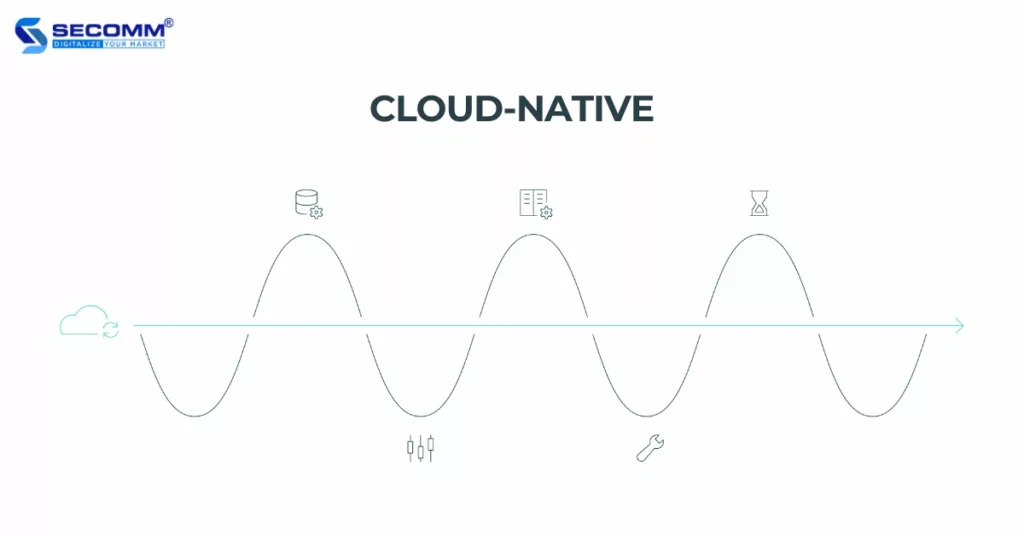
Commercetools leverage a cloud-native approach hosted on Google Cloud and Amazon Web Services (AWS), both well-known brands are widely used in certified data centers across Europe, the US, and APAC (Asia-Pacific).
Headless
Headless Commerce is an architecture where the user interface (UI) and the backend are decoupled and operate independently. In headless architecture, the UI is designed solely to focus on displaying content and interacting with users, while the backend is responsible for handling business logic, data storage, and providing APIs to interact with other applications.
The architecture provides high flexibility and scalability, allowing developers and admins to focus on a specific part of the system without having to change the entire architecture. It also enhances the application diversity and compatibility, as different UI software can be used to display content for users.
As a pioneer in Headless Commerce technology, Commercetools offers an open and decoupled environment that enables unlimited customization across all eCommerce channels.
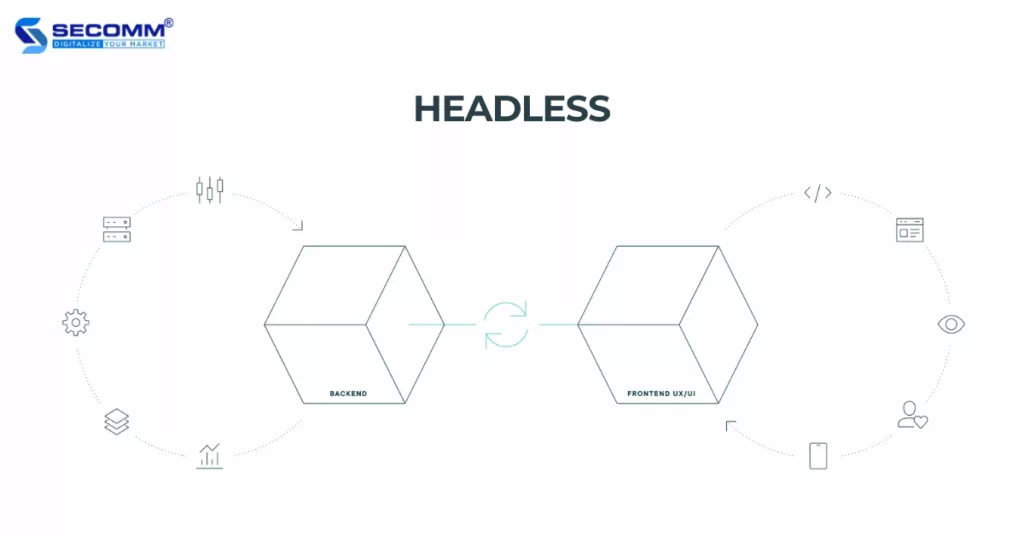
The pros of Commercetools
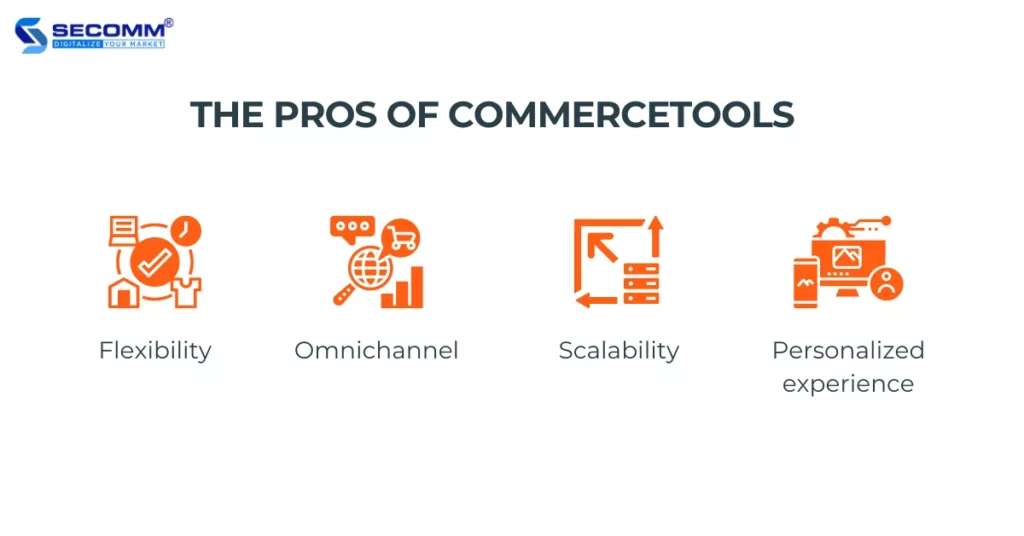
Flexibility
Commercetools has its ability to be flexible with the API architecture, making it compatible with any system and app. This allows you to easily integrate and expand your eCommerce system according to your specific needs.
Omnichannel
Commercetools supports Omnichannel including eCommerce websites, mobile apps, eCommerce marketplaces, social platforms, brick-and-mortar stores and more. This enables you to reach customers across multiple channels, boosting your conversion rates and revenue.
Scalability
Because Commercetools is built on MACH architecture, it has an ability to flexibly scale by adding or removing distinct functions as needed. This facilitates easy adaptation to the ever-changing market trends.
Personalized experience
Commercetools provides you with a personalization feature to improve your customer experience. This way, you can segment your customers based on their behaviors and preference, then offer them personalized promotions or product recommendations.
The cons of Commercetools
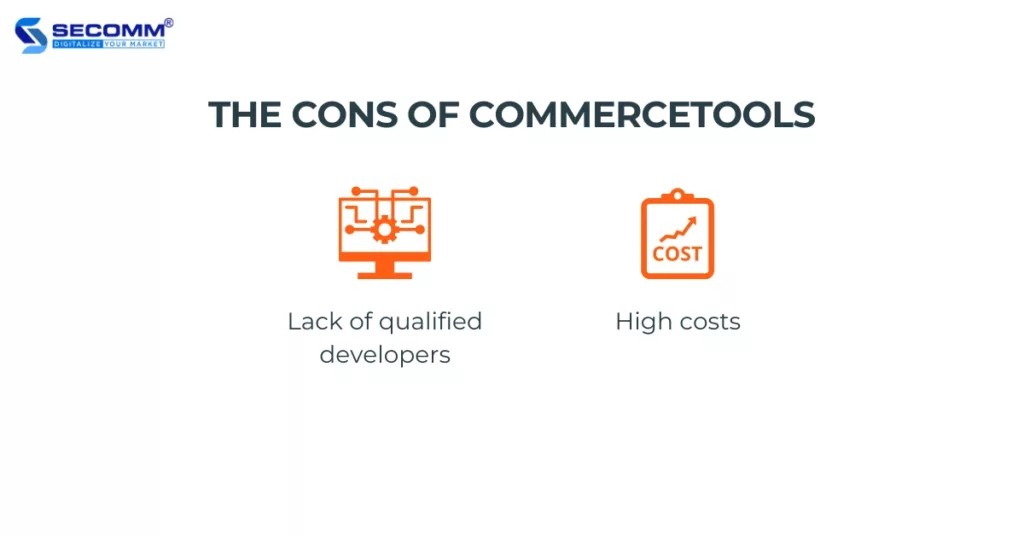
Lack of qualified developers
Commercetools is a highly customizable eCommerce platform, which requires a team of technical-skilled developers to deploy and maintain the eCommerce system.
Moreover, Commercetools is a relatively new platform compared to other popular ones like Shopify, Magento, WooCommerce, and more, so there may be fewer experienced agencies and developers available for you to choose from.
High costs
The cost of using Commercetools is quite high and will depend on your business’s total revenue, along with the development cost and the cost of integrating third-party plugins or apps.
If your business has a maximum annual revenue of around 100,000,000 USD, you would have to pay approximately 120,000 USD as an annual licensing fee for using Commercetools.
Commercetools is a platform that extensively applies advanced technologies to help businesses build highly complex eCommerce websites. However, it is primarily suitable for enterprise-level businesses, with substantial budgets to implement their specialized systems.
Related article: Top 10 eCommerce Websites Using Commercetools Platform
With years of experience implementing eCommerce solutions for various businesses around the world such as Changi Airport Group (Singapore), Laybyland (Australia), Vinamilk (Vietnam), Jasnor (Australia), My Market (Hong Kong), and more. SECOMM understands the potential of Commercetools for improving business operations, as well as the impediment involved in the development process.
Contact or call directly our hotline (+842871089908) to the SECOMM hotline for a free consultation.
 2
2

 7,923
7,923

 0
0

 1
1
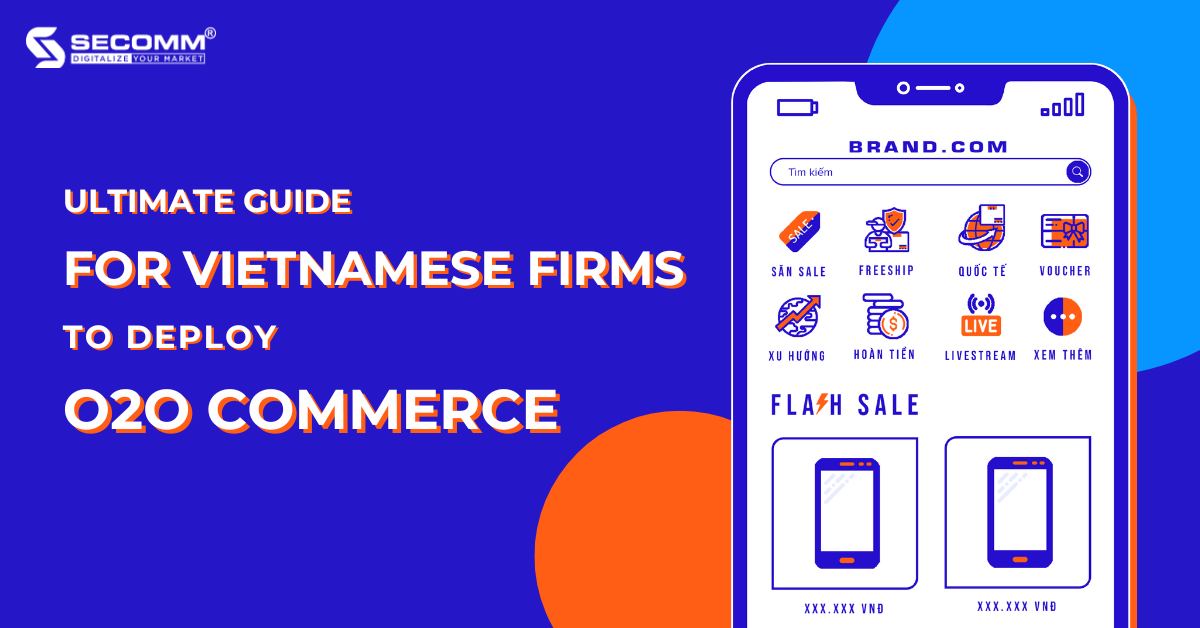
THE COMPLETE GUIDE FOR O2O COMMERCE DEPLOYMENT
According to data compiled by Statista, over 82% of retail sales take place in brick-and-mortar stores. Within that, more than 81% of customers have spent time researching products online before deciding. This demonstrates both online and offline business activities must be aligned for the optimized overall operation. That means you, as a business, need to consider implementing an O2O commerce strategy in line with your business goals and capabilities.
Define objectives
To establish objectives, it’s important to determine your vision for O2O commerce implementation. It represents the future look that you aim to achieve, and then you will set specific and measurable goals. You can also use SWOT to make sure you understand your strength, weakness, opportunity, and threats.
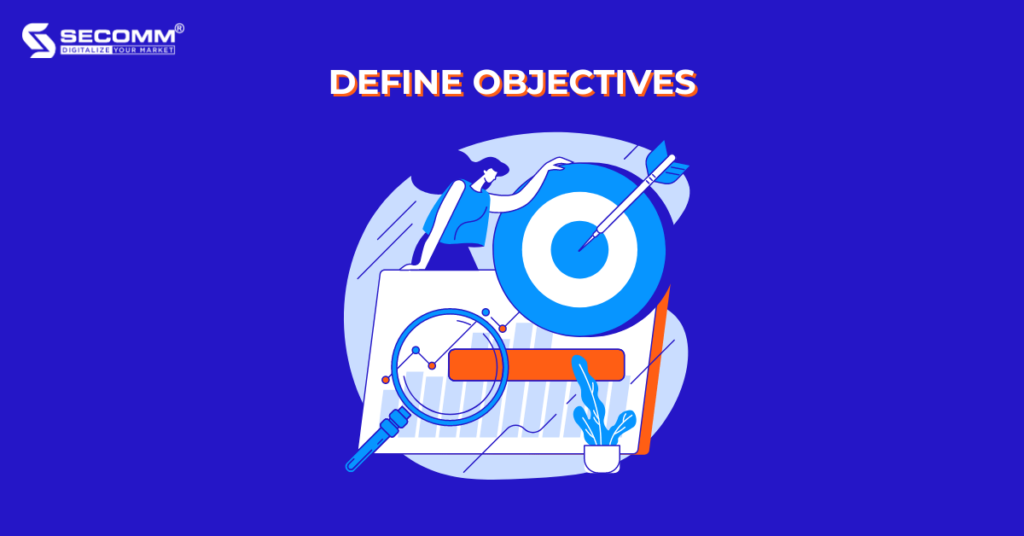
Clear objectives will keep you focused on what is important, minimize risks, and achieve O2O commerce success.
Plan the strategy
Next is to work with your team to develop O2O strategies to achieve the established objectives.
You can use performance analysis software to measure and analyze, identifying pain points and touchpoints throughout the purchasing journey. This way, you can determine which O2O model to implement and which channels are suited for the chosen model.
After choosing your business model, you will select resources to facilitate O2O commerce.
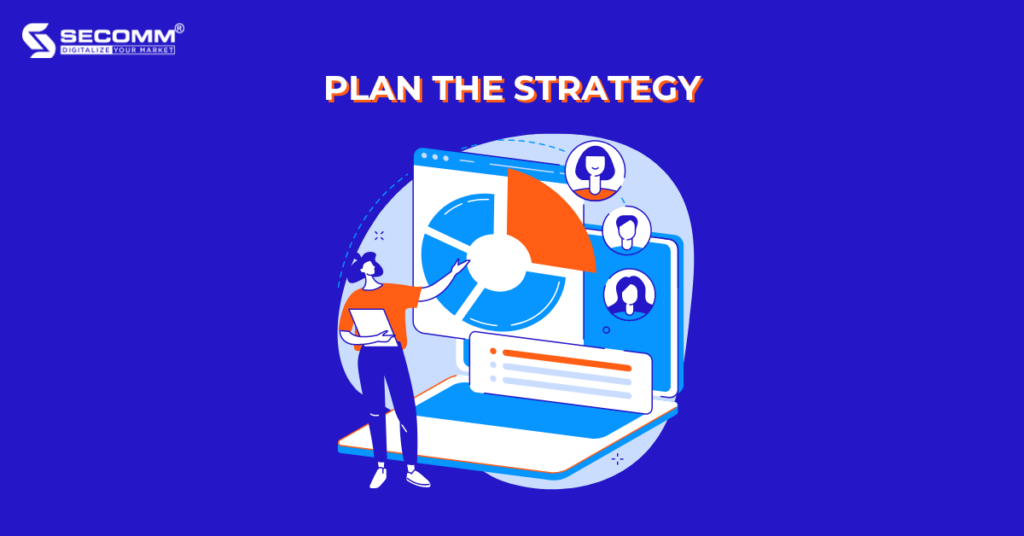
Here are 3 great ways to pool resources:
Number 1. Plan to build your in-house team for both online and offline sales channels
Pros: You can manage and shape your team to develop the business the way you want
Cons: It requires significant costs and time to recruit and train your in-house team, making your market entry to be slower than the competition.
Number 2. Collaborate with an O2O-experienced developer
Pros: You can learn a lot from your partner
Cons: It’s not easy to find trustworthy and professional partners with expertise that suits your needs.
Number 3. Facilitate the O2O commerce with an expert developer along with building the in-house team to maintain it.
Pros: You can quickly develop the O2O system and control it in the long run
Cons: It takes time to find a trustworthy vendor, as well as the costs to recruit and train your in-house team.
Those approaches can help you in effectively outlining your O2O commerce plan, encompassing aspects such as budget allocation and implementation timeline.
Optimize the offline commerce system
Typically, businesses that implement O2O strategies are those that already have an existing offline business system. However, to effectively fulfill O2O orders you must optimize your offline commerce capabilities. The optimized offline system will strengthen your O2O operations with some management software such as POS, CRM, ERP, and PIM instead of using manual management processes relying on paperwork or Microsoft Office tools (Word, Excel, OneNote, Access, etc).
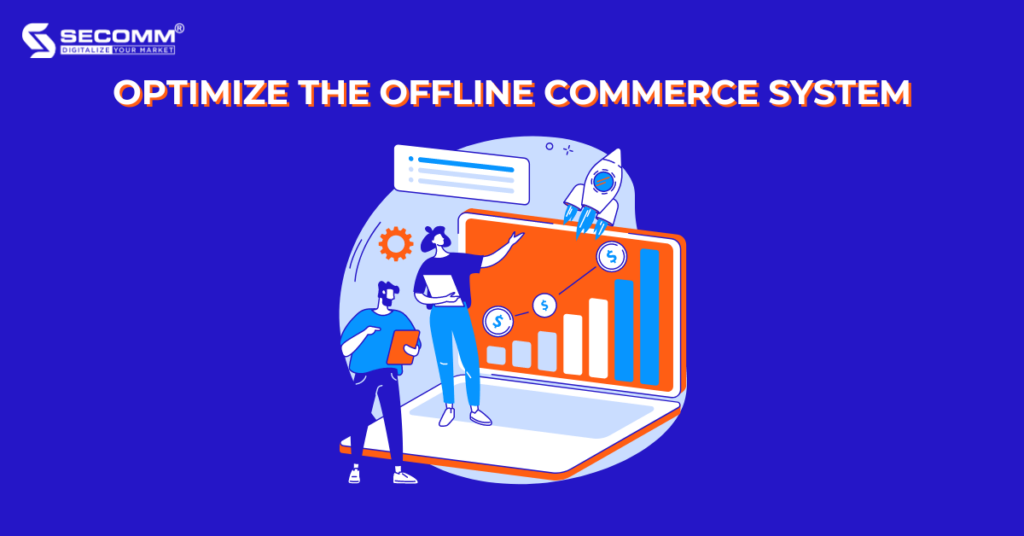
POS (Point of Sale) is where the buying and selling transactions take place. A POS system combines hardware and software to create a complete transaction process. Some popular POS systems include Magestore, mPOS, VNPAY, and KiotViet.
ERP (Enterprise Resource Planning) is software that helps plan and manage all operations of a business. Some world-renowned ERPs include Odoo, Sage, TomERP, Oracle, and SAP.
CRM (Customer Relationship Management) is a software that allows you to manage information and interaction of your existing and prospective customers. CRM helps you to collect, store, and analyze customer data to improve customer interactions and enhance sales capabilities. You can use CRM tools like Salesforce, HubSpot, Zendesk, Zoho, and Pipedrive.
PIM (Product Information Management) is a system used to store and manage your business’s product information in a centralized manner. Product information includes technical specifications, descriptions, images, videos, size and color information, multilingual product descriptions, and other relevant information needed by marketers or sales staff. There are some popular PIM solutions including Pimworks, Salsify, Akeneo, and Inriver.
Depending on the current level of digitization in your offline operations, you can consider upgrading existing systems, transitioning to different platforms, or implementing additional suitable software solutions.
Develop the online commerce system
Select platforms
Typically, building the online commerce system including websites, and apps, you can choose between 2 types of platforms: SaaS and Open Source.
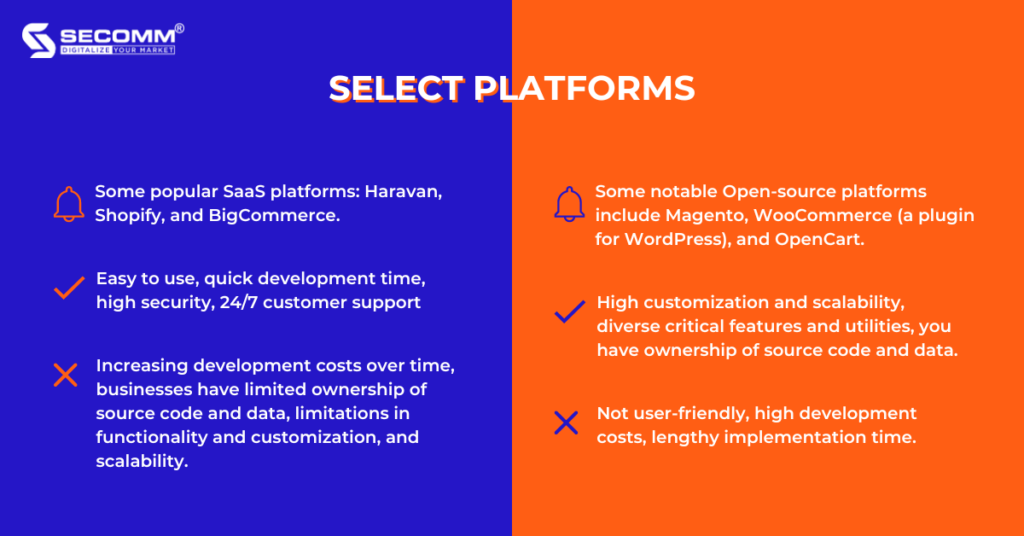
SaaS (Software as a Service) platform is a service delivery model where the website system is provided as software. In this model, data is stored on the provider’s server, and the platform is responsible for handling technical issues for the business.
Some popular SaaS platforms: Haravan, Shopify, and BigCommerce.
- Pros: Easy to use, quick development time, high security, 24/7 customer support
- Cons: Increasing development costs over time, businesses have limited ownership of source code and data, limitations in functionality and customization, and scalability.
The SaaS platform is often a popular choice for startups or SMEs (Small and Medium-sized Enterprises) due to its reasonable cost and implementation time.
The Open Source platform refers to software with publicly available source code that can be used by anyone free of charge. Open-source platforms are the optimal choice for businesses to develop comprehensive websites and apps.
Some notable Open-source platforms include Magento, WooCommerce (a plugin for WordPress), and OpenCart.
- Pros: High customization and scalability, diverse critical features and utilities, you have ownership of source code and data.
- Cons: Not user-friendly, high development costs, lengthy implementation time.
The Open-source platform is the perfect choice for enterprise-level businesses requiring complex customization due to its high flexibility and scalability.
In addition, you can also build your store on popular eCommerce marketplaces such as Shopee, Lazada, Tiki, Sendo, and Amazon. Marketplaces give you a great opportunity to reach out to a wide pool of potential customers and increase sales. Moreover, using eCommerce marketplaces helps you save costs on ads, shipping, and customer relationship management (CRM).
To succeed on marketplaces, you will need optimized store pages and an effective strategy. It’s easier said than done, however, relying on eCommerce marketplaces in the long run may result in a loss of control over customers and their data. Marketplaces will have their own policies regarding customer data management and contact information making it difficult for you to directly access their customers and may lose these potential customers to your competition.
Overall, to effectively implement O2O commerce, you can choose to develop an online system alongside your offline system or proceed with it after getting the offline system done.
Create UI/UX design
After choosing the platform to build the O2O e-commerce website and app, you will create the UI/UX design that aligns with your brand’s characteristics.

There are 3 recommended approaches:
- Using pre-built themes: This helps you save theme costs. Both SaaS and Open-source platforms offer a variety of themes ranging from $300 to $500.
- Customizing based on pre-built themes: This approach allows you to customize the theme to suit your development needs.
- Create the UI/UX design from scratch: This helps you to develop your brand image uniquely and creatively compared to the majority of competitors. It may incur higher costs compared to using pre-built themes but the “tailored” design will meet the market needs and your business’s requirements.
Develop critical functions for the digital system
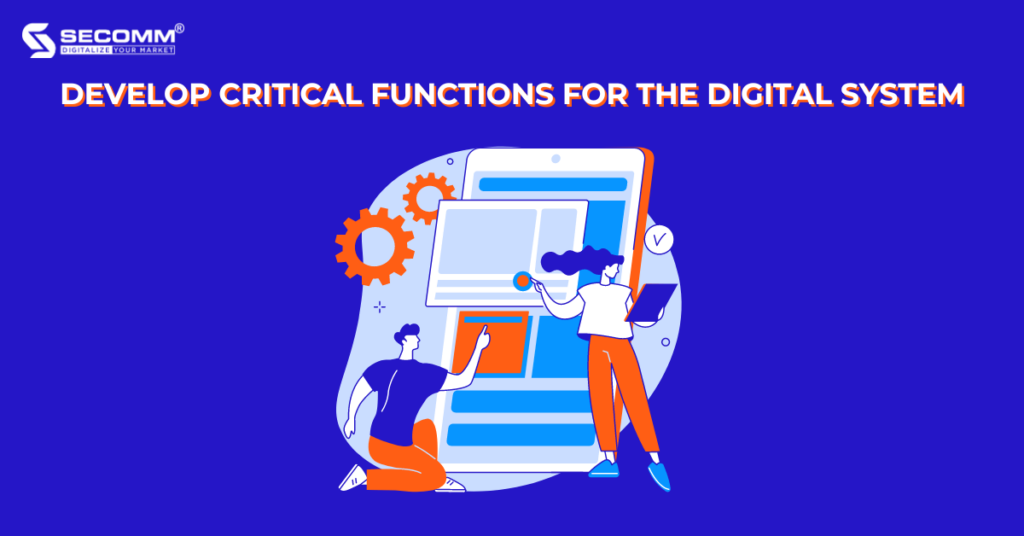
After you’ve done with your design, it’s time to develop some critical functions for both eCommerce website and app implementation. Below are a few suggestions:
- Catalog Management: involves managing categories, functions, prices, and product images/videos to optimize your operations.
- Sales Management: focus on managing order information, and being aware of customer shopping behavior.
- Marketing Management: integrating features such as URLs, meta tags, and internal links to optimize SEO, and combine with other effective marketing campaigns to boost sales.
- Content Management: All about generating and optimizing engaging content for CMS, including text, images, banners, widgets, templates as well as blogs, and branded content, v.v
- Customer Management: All about storing, managing, and analyzing customer data and segmentation to boost your marketing strategy and optimize the customer online experience.
- System Management: All about managing and assigning permissions to administrators to operate, secure, and maintain the eCommerce system.
- Store Management: All about using inventory management tools at main stores, branches, and warehouses to ensure an efficient supply chain.
- Cart and Checkout Management: All about the shopping cart and payment information.
- Analysis and Reporting: All about analyzing and measuring the performance of the eCommerce system to help you make decisions based on data.
Testing
Testing serves as a vital undertaking to help you uncover any lurking bugs that may emerge within a website and app, all in the pursuit of aligning the entire system seamlessly with the precise demands of your business. By doing testing, you will not only grant a comprehensive overview of your project but also provide the means to evaluate targets and even proactively manage risks as you navigate the realm of eCommerce.
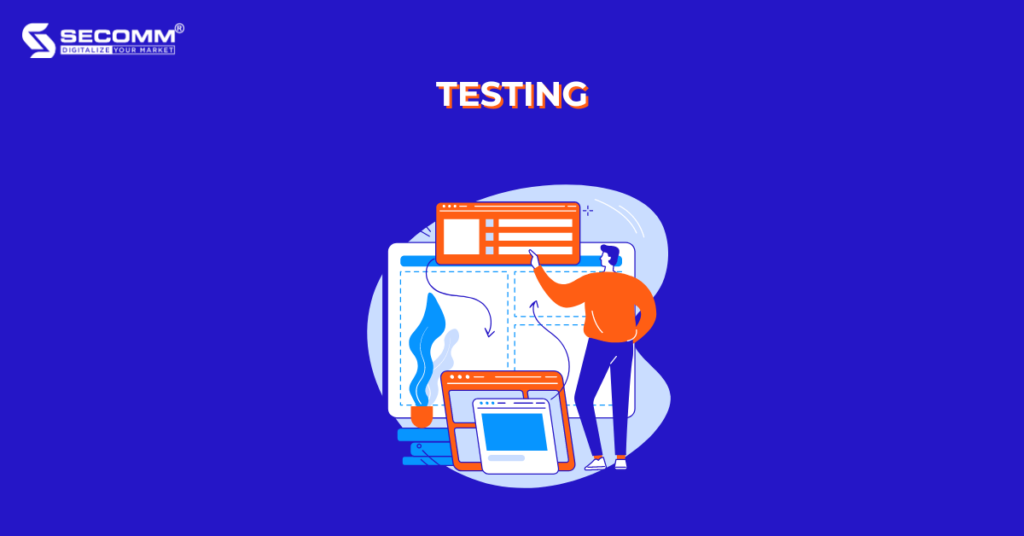
There are several testing methods:
- White-box testing: In white-box testing, the code and algorithms are examined. Testers access the source code to perform the tests.
- Black-box testing: This method tests the system’s functionality based on specific requirements.
- Gray-box testing: It combines black-box and white-box testing.
In general, conducting testing based on test scenarios is an important step that helps you ensure quality and provides a solid foundation for a smooth operation.
Legal Registration and Launch the app
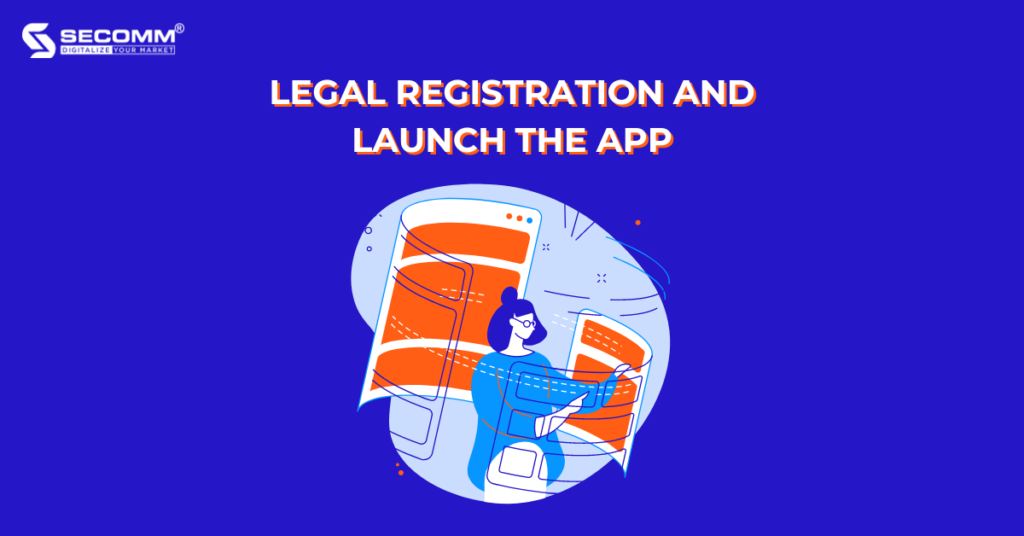
Declare with the Vietnamese Ministry of Industry and Trade
The final step to developing the online capabilities is to complete the legal procedures to make sure your eCommerce operation is legit. You can follow the step-by-step guide in the eCommerce Management Portal.
This is a mandatory requirement set by the Vietnamese Ministry of Industry and Trade for individuals or organizations having online businesses to fulfill their obligation to register/notify within the specified timeframe.
Publish the app on Google Play and App Store
To publish the applications on these platforms, you need to follow these steps:
- Register a developer account on the App Store and Google Play
- Create your developer profile and register the app
- Create and submit the app, including necessary information such as name, description, images, videos, and other features. You must ensure the app complies with the regulations and requirements of these platforms.
- Check and confirm the app registration. When the app is approved, you can start promoting and managing it on the platforms.
By pushing the app to Google Play and the App Store, you take one closer step to mobile users.
Measure performance
After facilitating your O2O commerce system, it’s time to take a look at the collected data to measure its performance for further critical decisions. Several tools can be integrated into your business system such as Google Search Console, Google Analytics, Facebook Pixel, TikTok Tracking Pixel, and more.
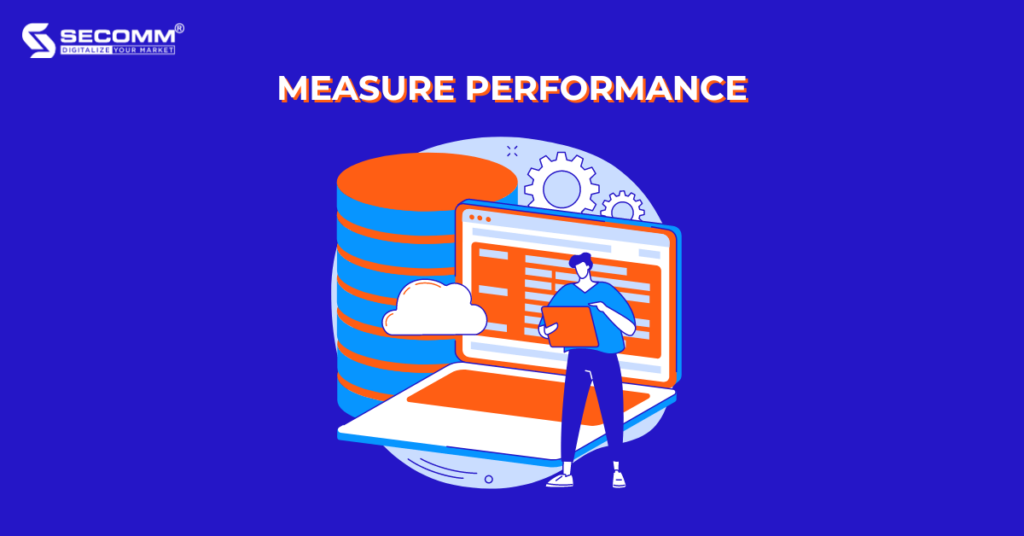
Moreover, you can integrate BI (Business Intelligence) tools, which are intelligent management reporting systems, to gather large amounts of data from various sources and use them to make predictions. Some popular BI tools include Magento Business Intelligence, Tableau, Power BI, and Looker.
Optimize customer experience
Having the analysis and reports in place, you can now develop appropriate strategies to optimize customer experience. Some popular strategies include Loyalty Program and Omnichannel.
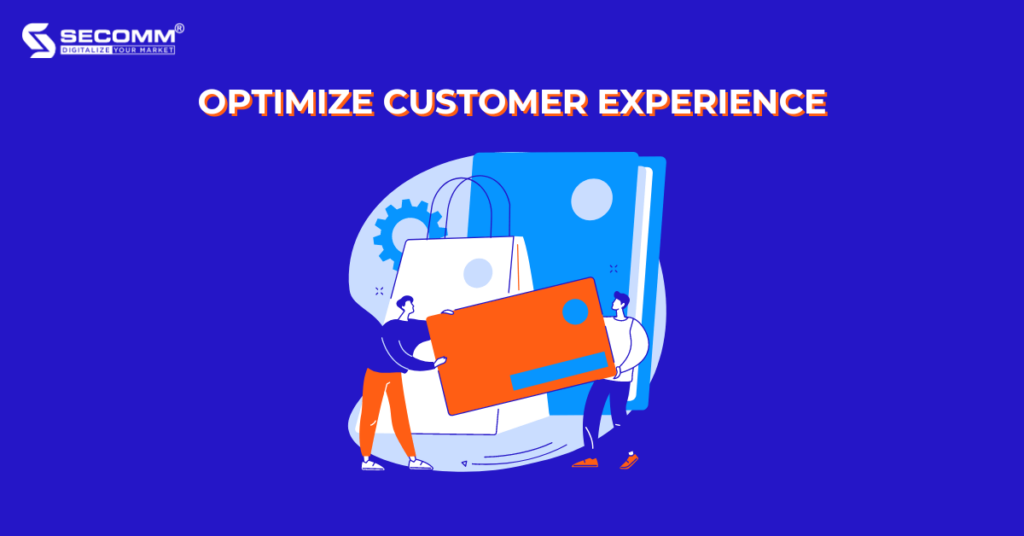
The Loyalty Program is a marketing strategy designed to encourage customers to continue to shop associated with the program. This enriches customer shopping experience and keeps them engaged with your brand.
Omnichannel is a multichannel sales approach that focuses on providing a seamless shopping experience by marketing and selling on all channels where potential customers are present, from mobile devices, social media, and eCommerce websites to brick-and-mortar stores.
O2O Commerce Solution at SECOMM
Established in 2014, SECOMM is a company specializing in providing O2O commerce solutions. Over the years, SECOMM has accumulated a vast portfolio of O2O commerce projects with large domestic and international clients such as Annam Gourmet, Trentham Estate, and much more.
Regarding O2O commerce solutions, SECOMM offers a diverse range of services to help businesses enhance their competitive capabilities and dominate the retail market in the digital age. These services include Solution Consulting, Team Development, and O2O System Development including:
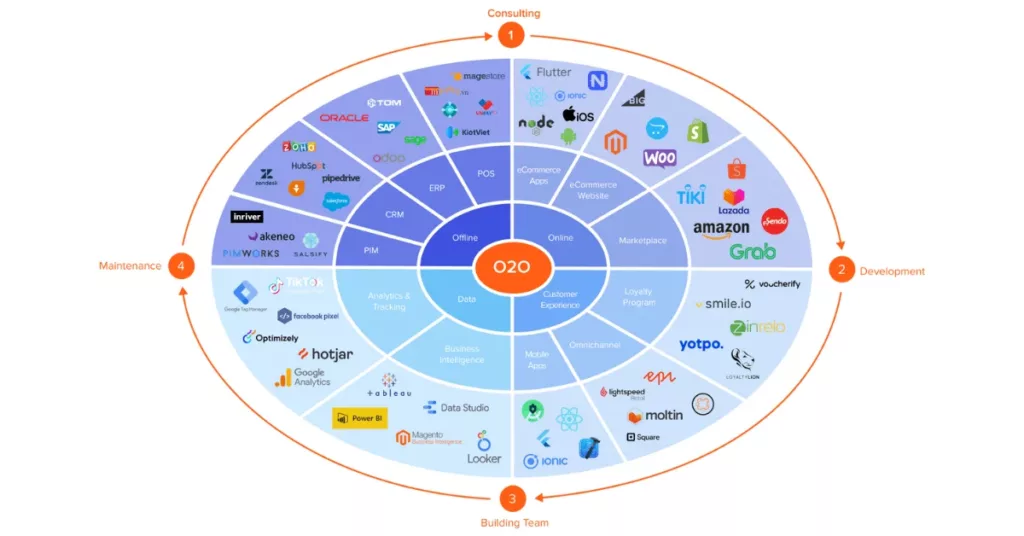
eCommerce System
Developing an O2O commerce system to provide a comprehensive experience for customers:
- Deploying eCommerce websites on platforms such as Shopify, WooCommerce, and Magento, etc
- Building eCommerce Apps using platforms, technologies, and frameworks such as Flutter, NodeJS, ReactJS, Ionic.
- Building and managing online stores on popular eCommerce marketplaces such as Shopee, Lazada, Tiki, Sendo, and Amazon.
Management system
Deploying and integrating management tools and software to efficiently operate business activities for the enterprise.
- ERP: Odoo, Sage, TomERP, Oracle, SAP, etc.
- CRM: Salesforce, Hubspot, Zendesk, Zoho, etc.
- POS: Magestore, mPOS, VNPAY, KiotViet, etc.
- PIM: Pimworks, Salsify, Akeneo, Inriver, etc.
Customer Experience System
Building and integrating platforms to support businesses in enhancing customer experience.
- Mobile Applications: Flutter, NodeJS, ReactJS, Ionic, etc.
- Loyalty Programs
- Omnichannel Commerce
Data System
Integrating tools to support the analysis and reporting for the business operations.
- Data analysis and reporting: Google Search Console, Google Analytics, Facebook Pixel, Tiktok Tracking Pixel, etc.
- Business Intelligence: Magento Business Intelligence, Tableau, Power BI, Looker, etc.
To learn more about the O2O commerce model as well as the best solutions to conquer the retail market, please contact SECOMM today for a free consultation.
 2
2

 6,897
6,897

 0
0

 1
1
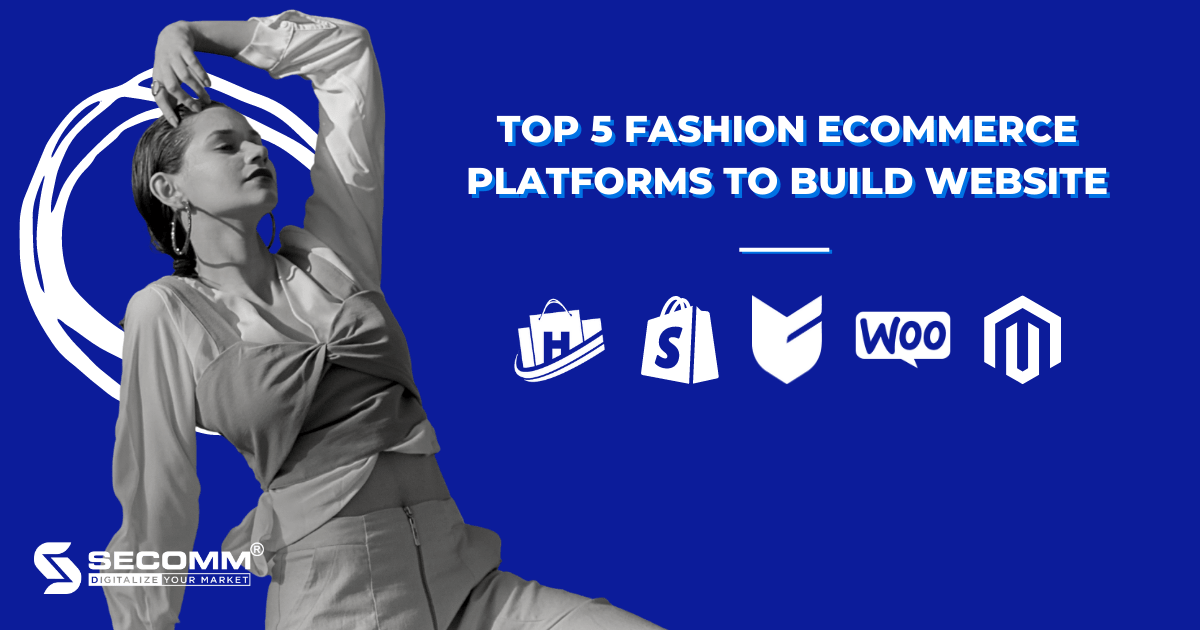
TOP 5 FASHION ECOMMERCE PLATFORMS TO BUILD WEBSITE
Despite the significant impact of Covid-19, the fashion industry is still on a roll, with the potential to reach $1 trillion globally by 2025 (according to Statista) thanks to eCommerce.
According to the IDEA 2022 research, the fashion eCommerce business in Vietnam is a highly competitive area, with up to 69 consumers using the eCommerce channel for every 100 fashion shoppers.
With the high potential of this commerce business, developing an eCommerce website is a must for success, necessitating the search for a platform on which to build a specialised eCommerce website for the fashion industry.
Businesses can use the following platforms to deploy fashion websites: Big Cartel, Haravan, Shopify, Woocommerce, and Magento.
Characteristics of fashion eCommerce
Eye-catching UI/UX design
UI/UX is a criterion that businesses frequently establish when creating an eCommerce website in order to develop a comfortable interface for a group of users who are passionate about fashion and maximise the capacity to engage with customers.

Comprehensive functional system
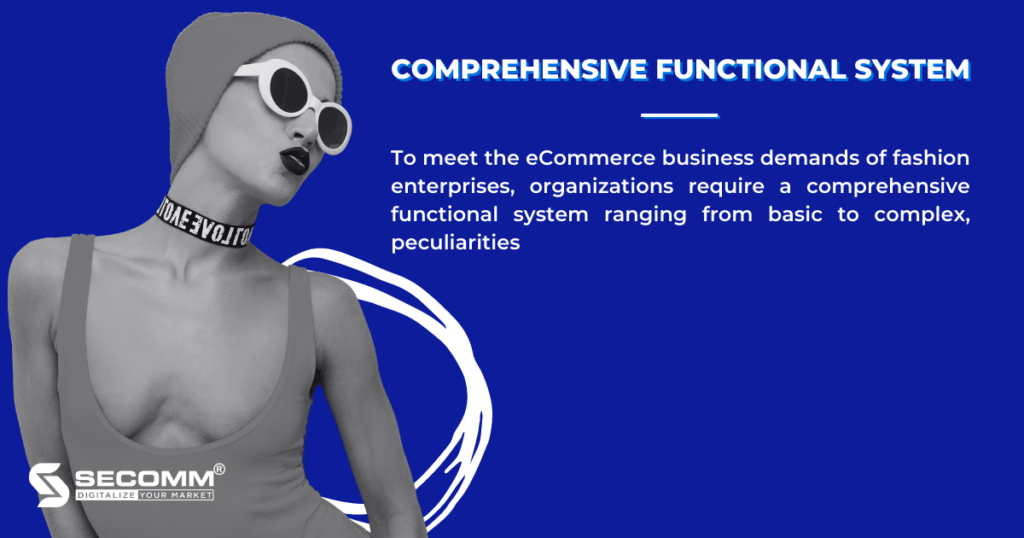
To meet the eCommerce business demands of fashion enterprises, organizations require a comprehensive functional system ranging from basic to complex, which includes:
- Catalog Management: Manage properties, pricing systems, inventory, photos, and videos to keep them running
- Content Management: Content development for CMS pages, image hosting, theme customization, and website design
- Customer Management: Control information, behavior, and consumption habits to build strategies for each specific customer group
- Sales Management: Set up and operate sales, order, payment, and shipping processes
- Marketing Management: Implement and optimize programs to attract potential customers with built-in support tools
- System Management: Seamless supply chain response with shipping navigation and automation management tools
- Store Management: Navigate and maintain your eCommerce business from online to offline
- Cart & Checkout: Manage shopping carts and process the next payment steps for customers
- Analytics and Reports: Monitor and measure eCommerce performance to give detailed reports to improve business efficiency
- Omnichannel sales allows business to follow customers across all channels, including eCommerce platforms, social networks, and social commerce websites.
- Multi-layer menu displaying a range of product categories
- Experiment using a variety of marketing strategies: Loyalty programmes, livestreaming, shopper entertainment, and affiliate marketing all assist to broaden methods of reaching out to potential consumers.
- Huge traffic to deal with enormous traffic volumes during “selling seasons”
Integration with a range of third-party services
To provide clients with a comprehensive shopping experience, fashion enterprises may frequently combine a number of payment options, shipping services, management software, and business analysis tools to enhance the e-commerce business system.
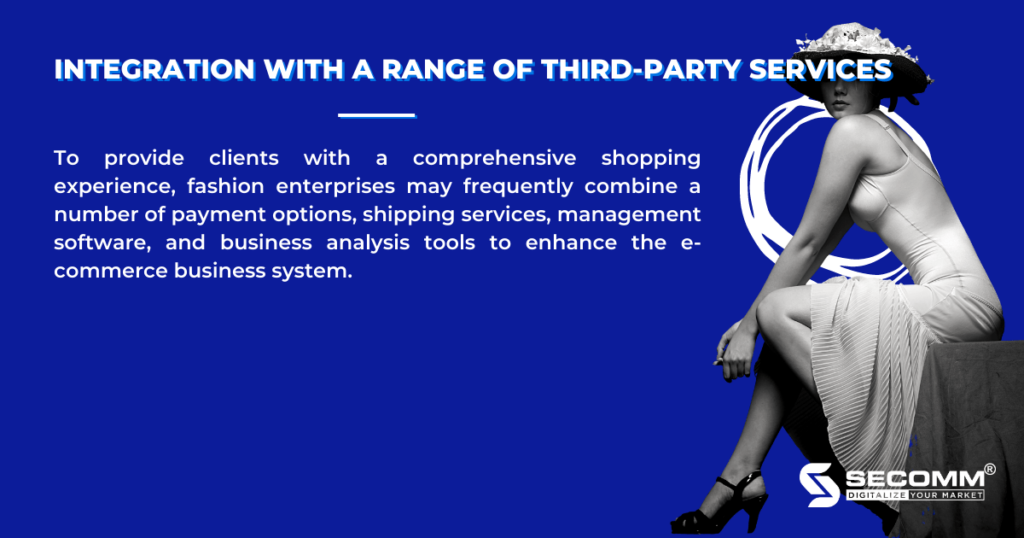
Numerous common payment options available today must be integrated into the website, including:
- Card payment: Domestic card, VISA, Mastercard, etc
E-wallets: MOMO, Zalopay, etc
Payment gateway: OnePay, VNPay, PayPal, etc
COD (Cash on Delivery)
Possibility to expand in the future
Often, firms at the start of a fashion business will not focus on the capacity to develop eCommerce websites in the future since platforms that enable this function are typically scarce. But, in terms of strategy, investing in a platform that supports this function can help organisations gain a competitive advantage over competitors in the market.
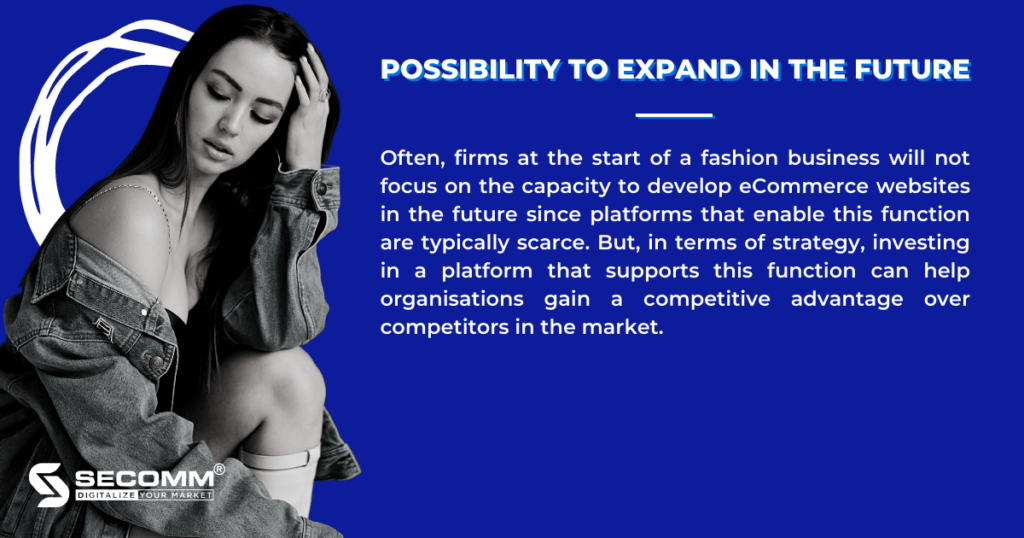
Top 5 fashion eCommerce platforms to build website
Haravan
Haravan is a well-known SaaS eCommerce platform in the Vietnamese industry, offering a variety of options for both enterprises and individuals. Haravan is used by a variety of websites, including Juno, Biti’s, Maison, and others.
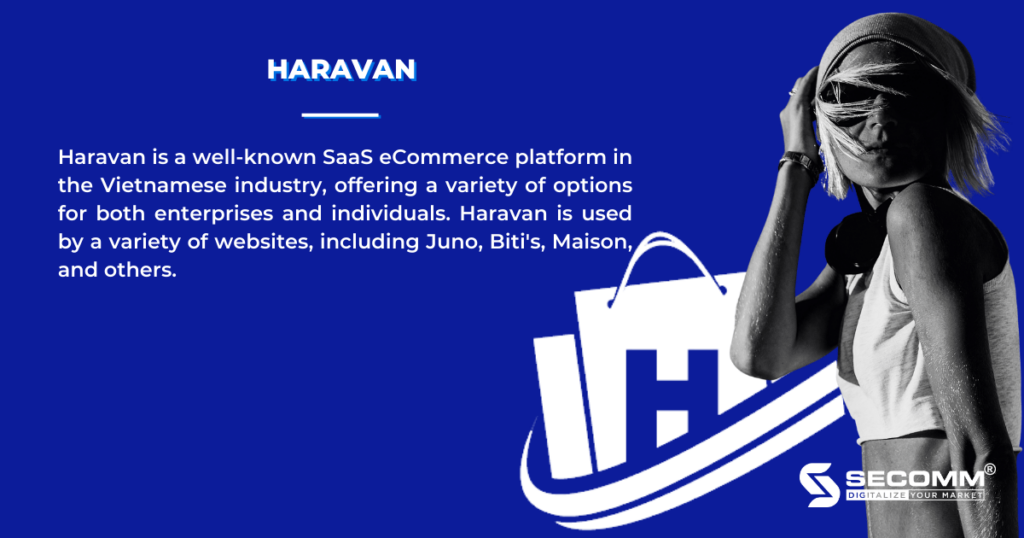
Platform review
Pro:
- A repository of readily available and diversified interfaces for the fashion industry
- A diverse feature, ranging from basic to complex, for starting an e-commerce business
Cons:
- The layout of existing templates causes duplicating, and it’s challenging to alter themes or create your own interface because doing so will have an adverse effect on the entire system
- The system of specific functions for the fashion sector is still limited
- Only integrated with services/utilities located in Haravan’s ecosystem
- Because it is a SaaS platform, it will be difficult for Haravan to expand the website in the future
→ Rating: 2/4
Haravan is suitable for start-up furniture businesses or SMEs (small and medium-sized enterprises) with operations mainly in Vietnam.
Pricing
Haravan is considered to have a reasonably low and diverse eCommerce website implementation cost for various businesses:
- Standard: 200.000 VND/month for personal sellers
- Pro: 600.000 VND/month for businesses that want to deploy Omnichannel
- Grow: 1.500.000 VND/month with the advantage of automating programs to take care and resell customers
- Scale: 3.000.000 VND/month for building loyal customers
Tuy nhiên, doanh nghiệp nên suy xét khi sử dụng Haravan trong dài hạn vì chi phí giấy phép sử dụng và các tiện ích mở rộng sẽ ngày càng tăng theo thời gian sử dụng.
Deployment time
However, businesses should consider when using Haravan in the long term because the cost of licenses and extensions will increase over time.
Shopify
Shopify is a SaaS ecommerce platform favored by the international ecommerce business community because of its fast implementation time and reasonable starting cost.
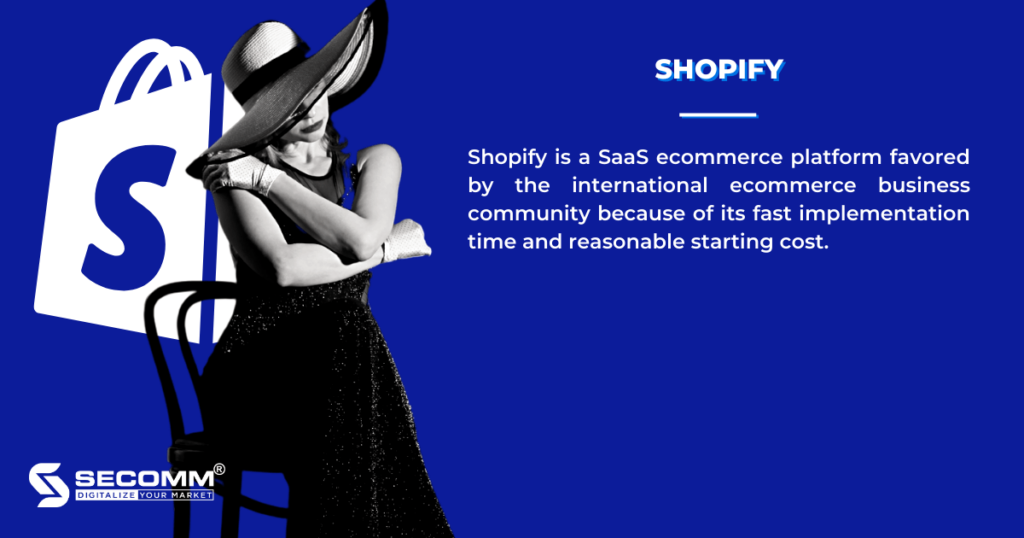
Platform review
Pro:
- Having a large selection of templates ideal for the fashion industry
- Functional system from basic to advanced, supporting eCommerce business
Cons:
- The layout of existing templates causes duplicating, and it’s challenging to alter themes or create your own interface because doing so will have an adverse effect on the entire system.
- The system of specific functions for the fashion sector is still limited.
- More third-party services than Haravan, although still only integrated with services available in Shopify’s app store.
- Because it is a SaaS platform, it will be difficult for Shopify to expand the website in the future
→ Rating: 2/4
Shopify is considered suitable for start-ups or SMEs with global operations.
Pricing
Starting an eCommerce business using Shopify is quite inexpensive at beginning, with several options:
- Basic Shopify: $29/month appropriate for start-ups with limited sales volume
- Shopify: $79/month suitable for growing internet companies
- Advanced Shopify: $299/month ideal for growing enterprises that require comprehensive reporting and analytical capabilities
- Shopify Lite: $9/month perfect for companies who wish to add sales and payment buttons to their current website or blog.
- Shopify Plus: $2000/month provides advanced eCommerce solutions for large businesses that need to process large volumes of orders
Nevertheless, the long-term cost of utilising Shopify will rise owing to rising costs for extensions, yearly usage fees, and % per transaction on the system.
Deployment time
The typical time to develop an e-commerce website is 1-7 days or more, depending on the system’s complexity.
Big Cartel
Big Cartel is a platform that assists in the creation of specialised eCommerce websites for the fashion industry or for art goods such as ceramics, paintings, and photographs. Big Cartel is used by several websites such as Atakontu, Indikidual, and others.
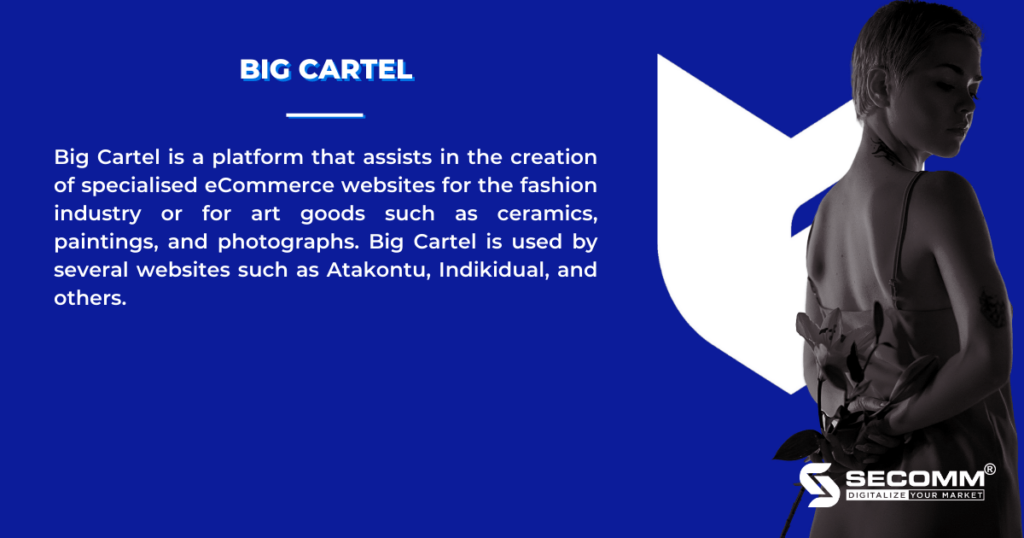
Platform review
Pro:
- Wide variety of themes for the arts, including the fashion industry
- Comprehensive functional system: basic, advanced, specific
Cons:
- Only services accessible in Big Cartel’s app store are incorporated.
- Because it is a SaaS platform, future expansion of the website will be tough to plan.
→ Rating: 2.5/4
Big Cartel will be appropriate for startups, SMEs, or new e-commerce participants that need to handle the complicated “issue” of fashion eCommerce.
Pricing
Website setup expenses are modest, with few possibilities for solution packages such as Haravan or Shopify:
- Package 1: Free for businesses that need to experience
- Package 2: $9.99/month suitable for businesses with a limit of 50 products
- Package 3: $19.99/month suitable for businesses with a limit of 500 products
Deployment time
Big Cartel allows you to develop a fashion e-commerce website in as little as 1-2 weeks, depending on the system’s complexity.
WooCommerce
WooCommerce is an open source platform, as a WordPress plug-in introduced in 2011 and allows businesses to use completely free. Popular websites using WooCommerce in Vietnam include Hai Trieu, Orchard, etc.
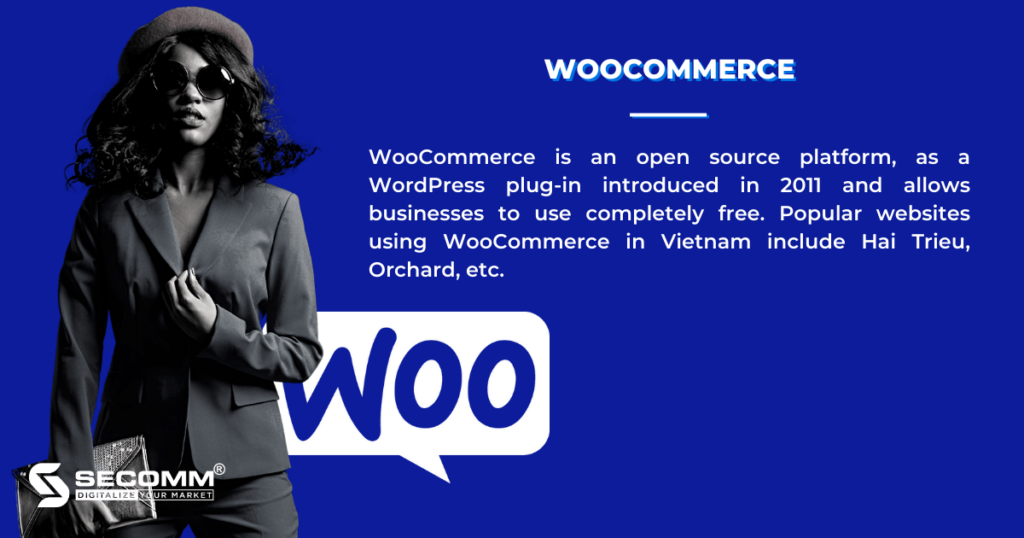
Platform review
Pro:
- There are several free and paid themes for the fashion industry available from the WordPress and WooCommerce community that are simple to adapt or develop.
- eCommerce functional system ranging from basic to sophisticated
- Simple connection with a wide range of third-party services
- Businesses may plan to extend their website in the future because it is a source code platform
Cons:
- The functional system is still restricted in terms of fashion-specific elements.
- Scalability is not very great in comparison to other open source systems like as Open Cart, Magento, and others.
→ Rating: 3/4
WooCommerce is suitable for fashion businesses who are used to WordPress before and are in need of developing an eCommerce system.
Pricing
Because it is an open source platform, fashion firms can use it for free; nevertheless, businesses must pay development costs while utilising the platform, such as:
- Domain: $15/year
- Hosting: $120/year
- SSL Certificate: $50 – $300/year
- Website development: $1,000 – $3,000 depending on the complexity of the system
- Extensions: $10/utilities
- Website maintenance and upgrade costs: $200/year, depending on the cooperation unit
Deployment time
An eCommerce website will take longer to create than the previous three platforms since it must be constructed from the ground up, which will take at least 1-3 months.
Magento
Magento is an open source platform with 2 versions: Magento Open Source (free) and Magento Commerce (paid). Some websites are using Magento such as Canifa, Hoang Phuc International, OnOff, etc.
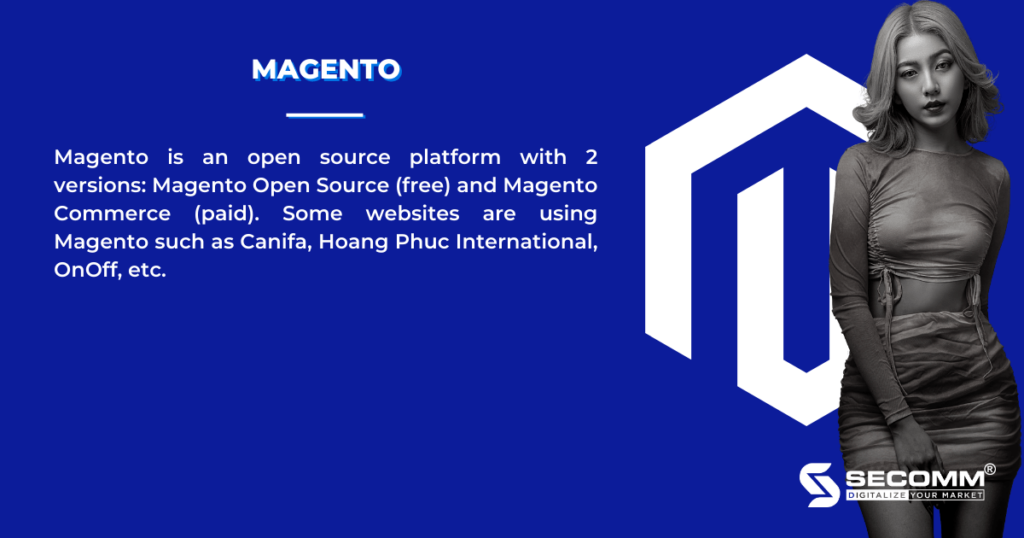
Platform review
Pro:
- Numerous fashion-specific themes are available from the worldwide developer community, marketplace, and Magento website developers, allowing businesses to use current themes or quickly alter them to meet their unique needs. Create your own user interface.
- Complete functional system: fundamental, advanced, and specific
- Simple connection with a wide range of third-party services
- Excellent scalability: multi-language, currency, and easy feature development in the future
Cons:
- There is no theme repository from Magento to support businesses
→ Rating: 4/4
Magento is appropriate for a wide range of fashion business types, including B2B, B2C, and B2B2C, as well as a wide range of business sizes, including startups, SMEs, and huge corporations. Nevertheless, because the cost of deploying Magento is sometimes very high, Magento is favoured by major organisations.
Pricing
Magento Open Source, like WooCommerce, is an open source platform, therefore it is free to use; nonetheless, businesses must consider the following costs:
- Domain: $15/year
- Hosting: $120/year
- SSL Certificate: $50 – $300/year
- Website development: $1.800 – $10.000 depending on the complexity of the system
- Extensions: $60 – $600/utilities
- Website maintenance and upgrade costs: $200/year, depending on the partner
Businesses will be working directly with Magento’s development team for Magento Commerce, thus they will have to pay licence fees as well as certain additional charges such as:
- Licenses: $22.000 – $125.000/year
- Domain: $15 – $400/year
- Hosting: $500 – $6.500/year
- SSL Certificate: $50 – $300/year
- Website development: $10.000+
- Extensions: $60 – $600/utilities
Deployment time
A complete Magento project typically requires 3 to 6 months of deployment time, with some projects requiring up to a year. The reason for this is the complicated functioning structure and the lack of Magento experts.
Summary
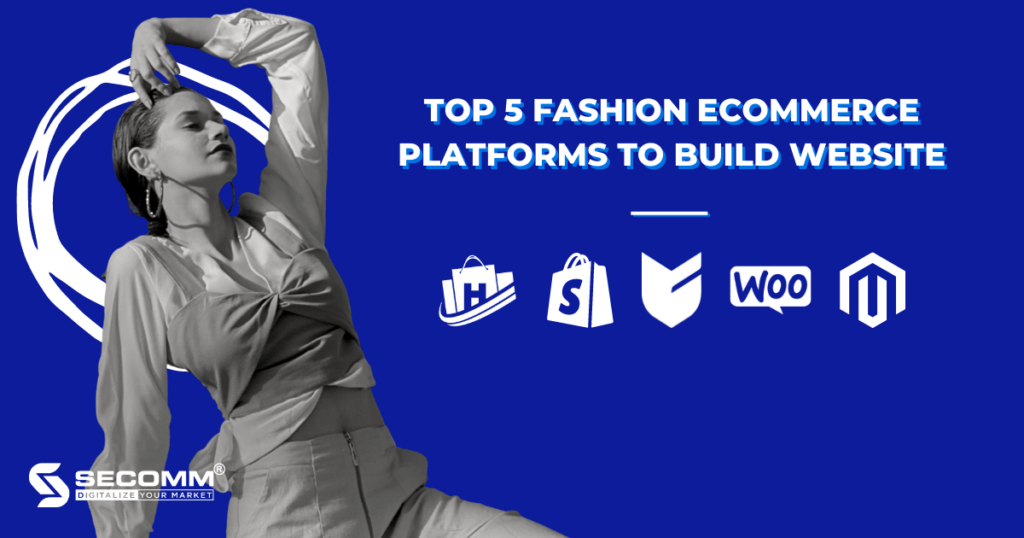
 2
2

 1,838
1,838

 0
0

 1
1
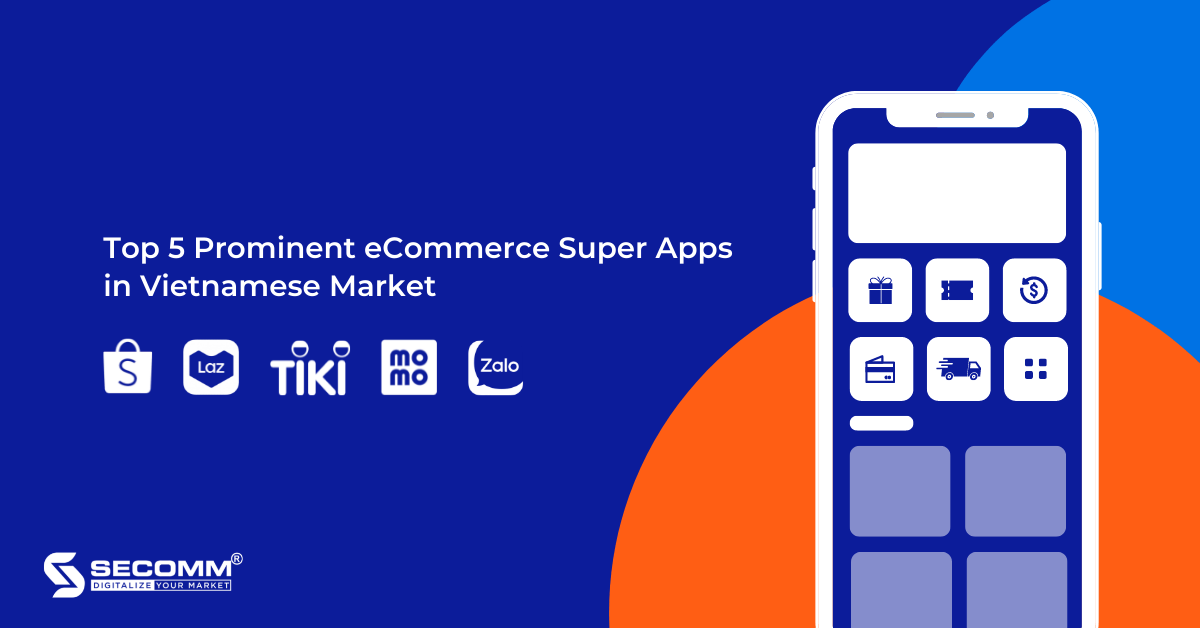
TOP 5 PROMINENT ECOMMERCE SUPER APPS IN VIETNAMESE MARKET
According to the latest of Ministry of Industry and Trade of the Socialist Republic of Vietnam in 2022, the eCommerce industry’s revenue is estimated at 13.7 billion USD, increase 16% compared to 2020 and accounting for 6.5% of the total retail revenue of Vietnam. Due to e-Commerce SEA, Vietnam’s eCommerce will grow by an average of 25% per year from 2022 – 2025, possibly reaching 35 billion USD in 2025.
The impact of the Covid-19 epidemic and social distancing orders, as well as changes in consumer behaviour, are driving the growth of this industry.
Thanks to super apps, such as Shopee, Lazada, Tiki, MoMo, and Zalo, it’s easier to deploy mini apps, creating a premise for inexperienced brands to build eCommerce systems to enter this billion-dollar market.
Shopee
Shopee is the most popular eCommerce market in Southeast Asia and Taiwan. Shopee was founded in 2015 to provide people with an easy, safe, and quick online buying experience.
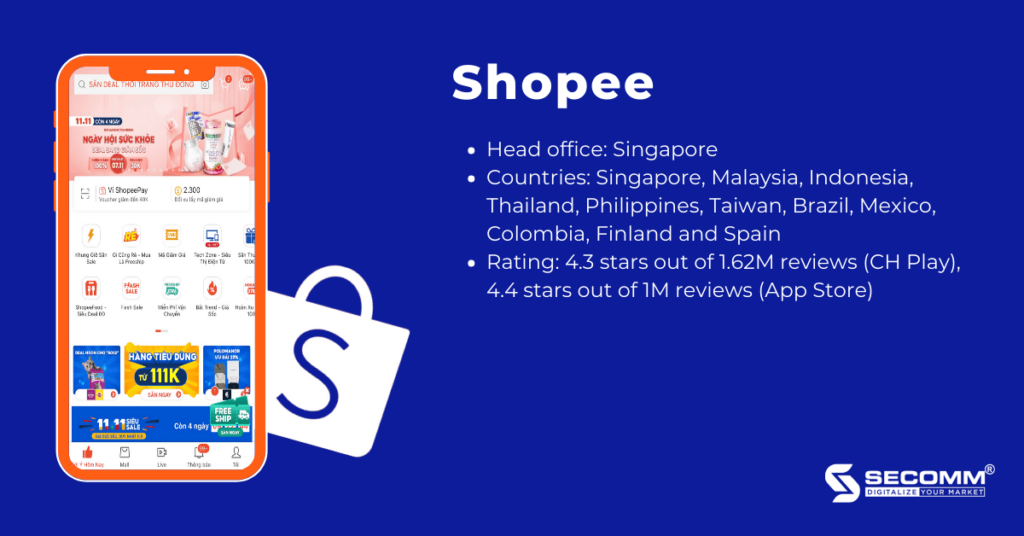
Shopee is gradually becoming an eCommerce super app, not only offering online shopping services but also owning various mini-apps such as Shopee Food, Shopee Mart, Shopee Wallet, insurance services from banks, booking flights, hotels and so on.
- Head office: Singapore
- Countries: Singapore, Malaysia, Indonesia, Thailand, Philippines, Taiwan, Brazil, Mexico, Colombia, Finland and Spain
- Rating: 4.3 stars out of 1.62M reviews (CH Play), 4.4 stars out of 1M reviews (App Store)
Lazada
Lazada, founded in 2012, is one of Southeast Asia’s biggest eCommerce marketplaces. This brand has always been a pioneer in fostering regional development via commerce and technology, intending to service 300 million consumers across Southeast Asia by 2030.
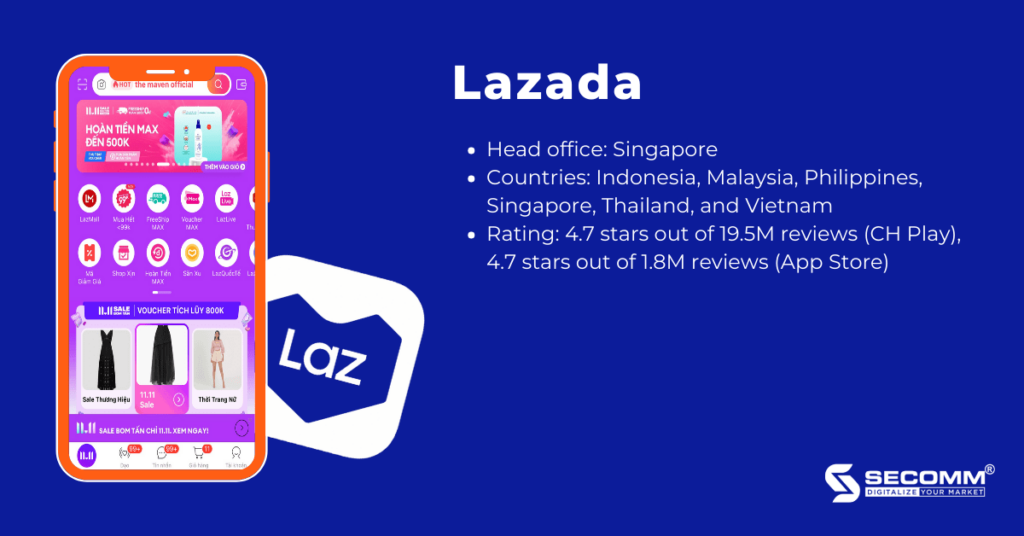
Like Shopee, Lazada has many mini apps and utilities for its own e-commerce business strategies, such as eM wallet, card and eVoucher recharge, online shopping, etc.
- Head office: Singapore
- Countries: Indonesia, Malaysia, Philippines, Singapore, Thailand, and Vietnam
- Rating: 4.7 stars out of 19.5M reviews (CH Play), 4.7 stars out of 1.8M reviews (App Store)
Tiki
Tiki is one of Vietnam’s most successful eCommerce marketplaces. Tiki was founded in March 2010 as an online English book-selling site. Since then, Tiki has evolved into an eCommerce super app, focusing on delivering hundreds of thousands of goods from a variety of product categories.
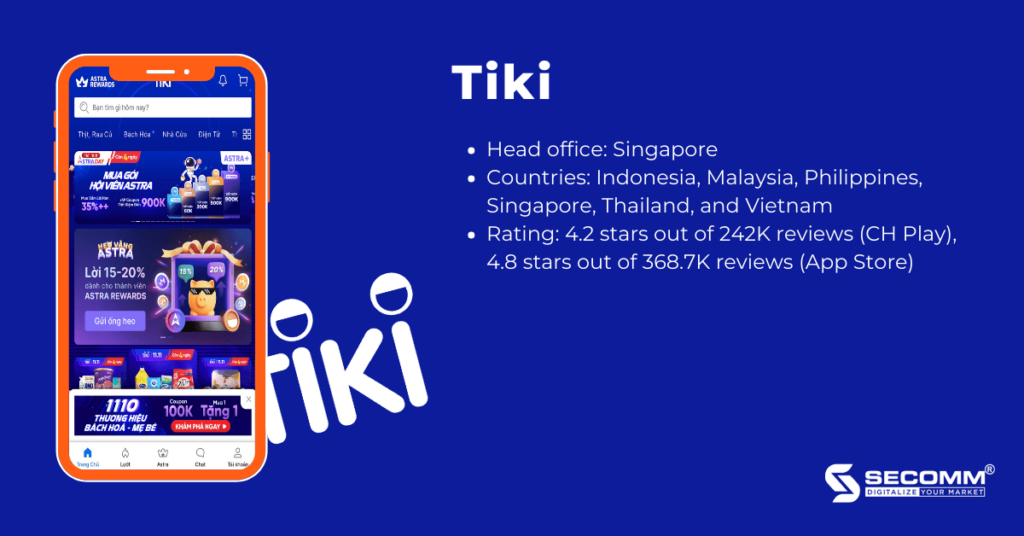
Tiki has been a pioneering marketplace in applying digital currency to business concepts, as proven by the launch of Astra, to boost up eCommerce. At the same time, Tiki refined its ecosystem by creating a series of extensions with mini apps from brands in various industries, including finance, gaming, food, shopping, health, insurance, entertainment, lifestyle, tourism, and community.
- Head office: Singapore
- Countries: Indonesia, Malaysia, Philippines, Singapore, Thailand, and Vietnam
- Rating: 4.2 stars out of 242K reviews (CH Play), 4.8 stars out of 368.7K reviews (App Store)
MoMo
MoMo is an e-wallet created by Online Mobile Services Joint Stock Company (M Service) that allows users to make mobile payments and transactions. Through partnerships with more than 90% of Vietnam’s banks and 10,000 local businesses, the company dominates more than 80% of the market for digital payments. As of 2022, MoMo e-wallet has more than 31 million users.
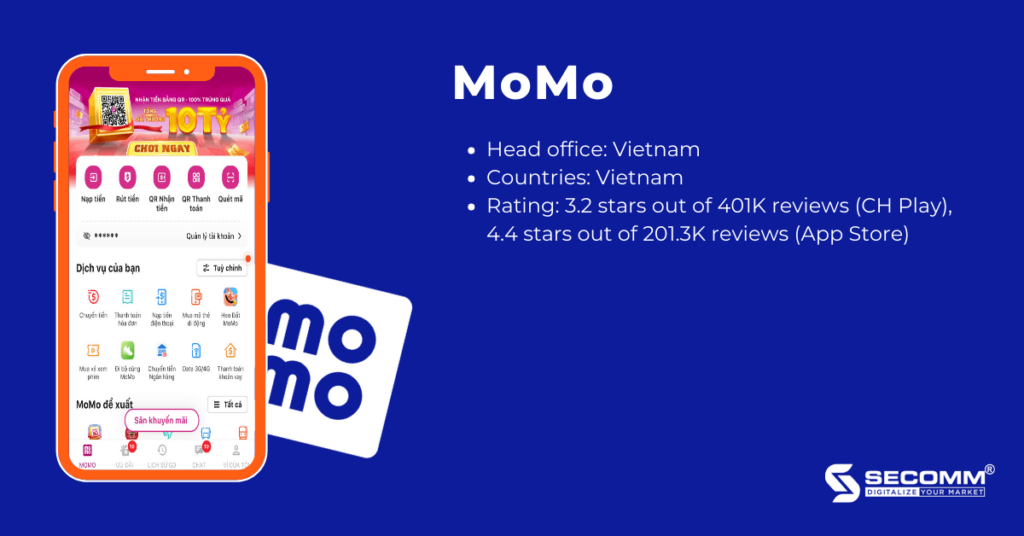
Since 2022, MoMo has developed a mini app technology, formally identifying itself as a super-payment app, helping small and medium companies to “climb on the shoulders of giants,” and construct an ecosystem for MoMo. In particular, utilities from businesses such as online shopping, restaurants, transportation services, tourism and hotels, investing and banking, medical services and so on.
- Head office: Vietnam
- Countries: Vietnam
- Rating: 3.2 stars out of 401K reviews (CH Play), 4.4 stars out of 201.3K reviews (App Store)
Zalo
Zalo was formally launched in December 2012, with the essence of a cross-platform instant messaging software built by the Vietnamese startup VNG. Zalo is a blend of Zing (a VNG-created social network) and alo (a phrase used to pick up a phone in Vietnam). Zalo has progressed to become a multi-functional, multi-platform social networking super app.
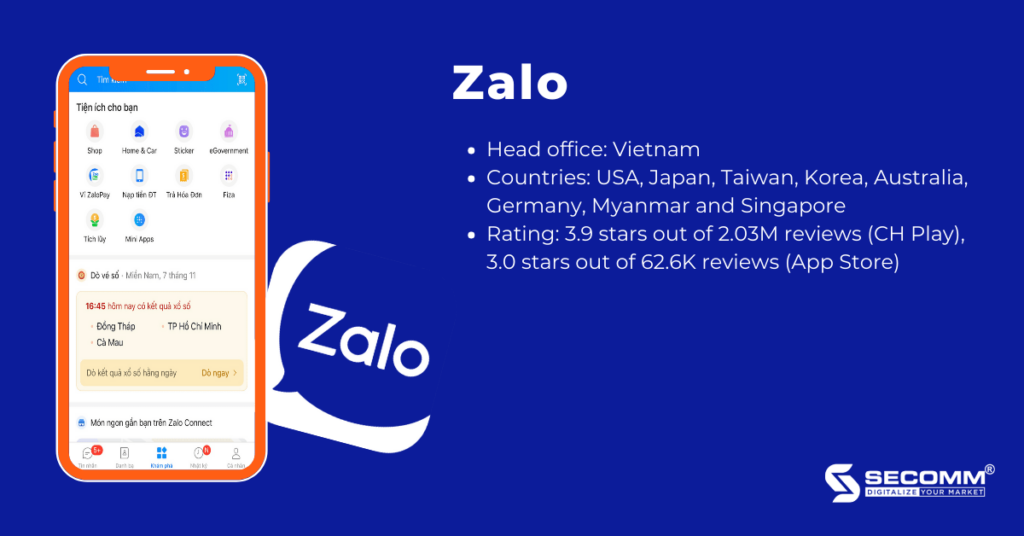
Like MoMo, Zalo created a new brand named Zalo Mini App to help other brands reach 65 million regular users on Zalo, and make diversity for this messaging platform. Since then, Zalo has also supported other services, primarily through partnerships with brands in finance, eCommerce, entertainment, games, restaurants and hotels.
- Head office: Vietnam
- Countries: USA, Japan, Taiwan, Korea, Australia, Germany, Myanmar and Singapore
- Rating: 3.9 stars out of 2.03M reviews (CH Play), 3.0 stars out of 62.6K reviews (App Store)
As can be seen, the future of Vietnam’s eCommerce industry will continue to rely on these “giants,” thus businesses should incorporate eCommerce super apps into their business models as soon as possible to reap the full advantages of these applications. However, companies should not rely on these apps for long periods of time since it will result in a loss of customer data, income from commission per order, and so on.
With more than 8 years of experience in consulting and deploying eCommerce systems, SECOMM understands the challenges businesses face in implementing eCommerce business effectively.
So we provide a free eCommerce consultation to help businesses catch on to this industry!
 2
2

 4,243
4,243

 0
0

 1
1

TOP 10 OUTSTANDING FASHION ECOMMERCE WEBSITE IN VIETNAM
Fashion eCommerce is growing increasingly influential, particularly in markets with a young population, such as Vietnam, where demand for fashion and lifestyle is diversified.
Recognising this, several fashion brands have begun developing their own eCommerce websites to join this lucrative business swiftly.
1. Coolmate
Coolmate is a men’s fashion business started in 2019. With a D2C eCommerce strategy as the centre for business development, after only 2 years of implementation, Coolmate had a successful capital call on Sharktank with Nguyen Hoa Binh for 500,000 USD. By 2021, Coolmate’s sales may reach VND 139 billion, an increase of 3.5 times compared to 2020, setting the 2022 revenue expectation at 440 billion.

- Fashion field: Menswear
- Website: https://www.coolmate.me/
- eCommerce platform: Laravel
- Traffic: 1.5M/month
- Rating: 854 (Vietnam), 55,047 (Global)
- Estimated value: $16,781
2. Hải Triều
Hai Trieu, which was founded in 1991, has over 30 years of expertise in the watch industry. To adapt to the changing industry and consumers, Hai Trieu has incorporated an eCommerce strategy into its business model with the objective of becoming a dominant watch retailer in Vietnam. Hai Trieu’s eCommerce website has received over 1 million monthly visits and is ranked among the top sites in the fashion eCommerce industry in Vietnam. (according to iPrice).
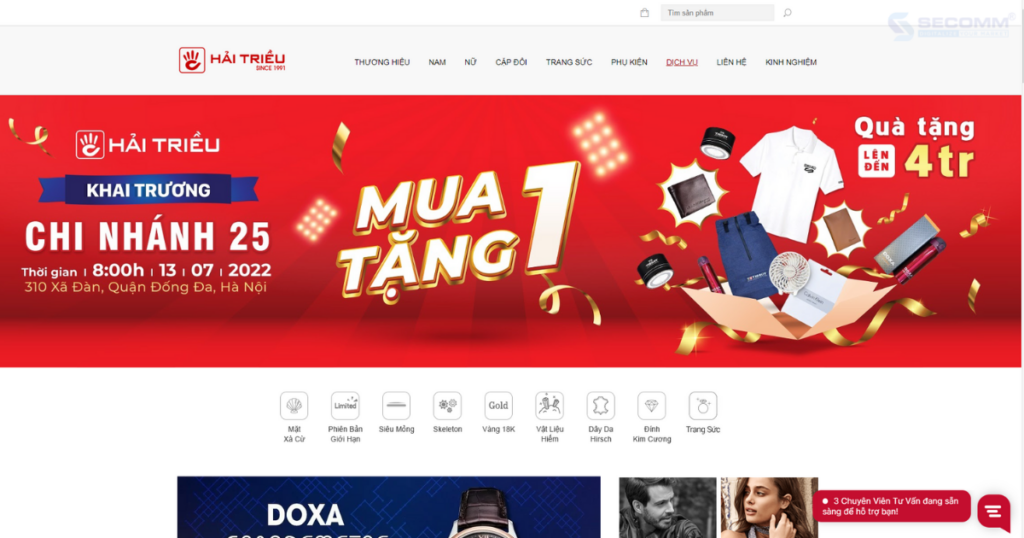
- Fashion field: Watches
- Website: https://donghohaitrieu.com/
- eCommerce platform: WooCommerce
- Traffic: 1.1M/month
- Rating: 807 (Vietnam), 51,641 (Global)
- Estimated value: $19.016
3. PNJ
The official name of PNJ is Phu Nhuan Jewelry Joint Stock Company, which was founded in 1988. PNJ has spent a long time developing a fashion eCommerce website to apply the omnichannel sales strategy. Because of the early adoption of eCommerce, PNJ has surmounted the tumultuous year of 2021 with net sales of over VND 19,547 billion, an increase of 12% over 2020.
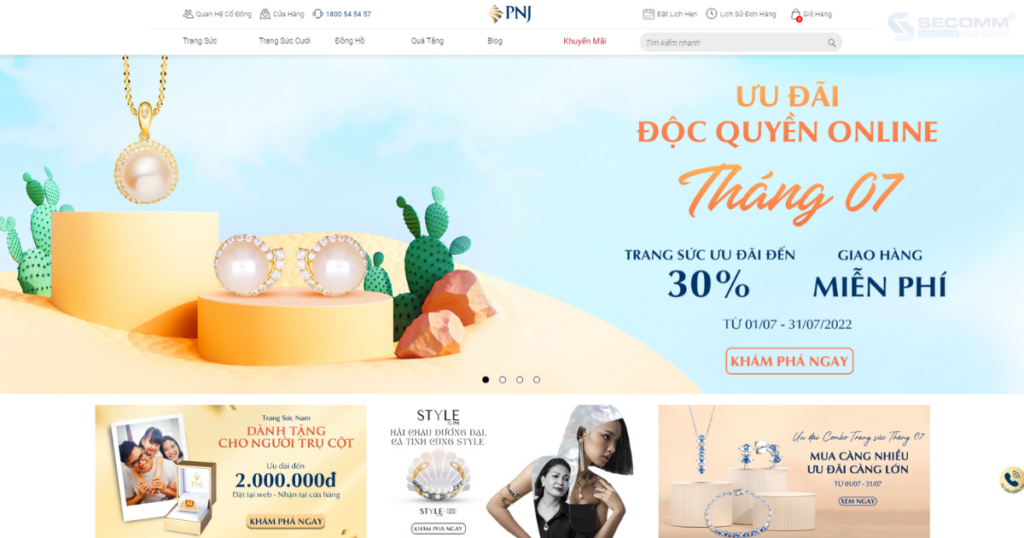
- Fashion field: Jewelry
- Website: https://www.pnj.com.vn/
- eCommerce platform: CS Cart
- Traffic: 926.9K/month
- Rating: 791 (Vietnam), 49,842 (Global)
- Estimated value: $21,007
4. Juno
Founded in 2005, Juno is a brand known for its line of women’s fashion shoes and bags. Juno saw the enormous potential of the e-commerce sector and invested early in technologies to make the online company more efficient. As a result, the eCommerce website of Juno is currently the highest-visited website in the fashion line of shoes and bags in Vietnam.
Juno has usually cultivated the clothes and accessories area to suit its clients’ increasingly broad consumer demands.

- Fashion field: Womenswear
- Website: https://juno.vn/
- eCommerce platform: Haravan
- Traffic: 899.3K/month
- Rating: 1,242 (Vietnam), 80,279 (Global)
- Estimated value: $20,688
5. Canifa
Canifa is a family fashion brand established in 1997, under Hoang Duong Service and Trading Joint Stock Company – a large fashion retailer in Vietnam. Canifa has built an eCommerce business with a reputation achieved in traditional fashion since 2012. Because of its long-term and sustainable eCommerce business strategy, this company opted to invest in establishing its own eCommerce website on the open-source platform – Magento and regularly upgrading this system to provide clients with the better eCommerce experience possible.

- Fashion field: Familyswear
- Website: https://canifa.com/
- eCommerce platform: Magento
- Traffic: 286.2K/month
- Rating: 2,537 (Vietnam), 155,488 (Global)
- Estimated value: $8,383
6. Hoang Phuc International
Hoang Phuc International (Hoang Phuc) was established in 1989 as a luxury fashion retailer of Kappa, Ecko Unltd, Superga, Replay, and Staple. This brand has decided to enter the eCommerce industry after three decades of using traditional strategy. Hoang Phuc has utilised and changed numerous platforms to create the successful eCommerce website that it is now. This business is currently employing the Magento platform – an open-source platform specialised in eCommerce.
This firm utilizes KOL and Livestream strategies to boost market penetration, besides constantly improving its own eCommerce website for selling apparel online.
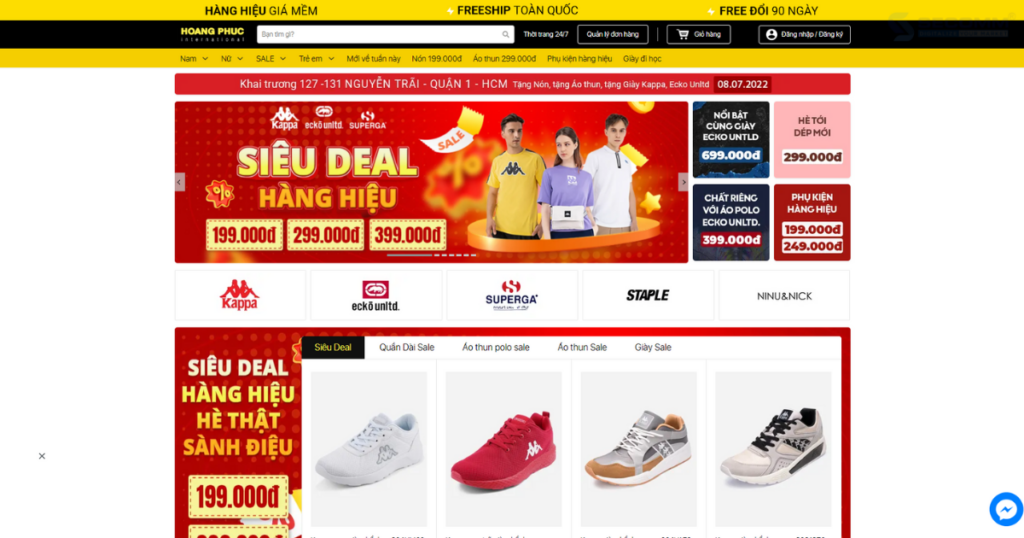
- Fashion field: Retail of luxury products
- Website: https://hoang-phuc.com/
- eCommerce platform: Magento
- Traffic: 258.0K/month
- Rating: 2,338 (Vietnam), 144,530 (Global)
- Estimated value: $19,895
7. Biti’s
Bitis began as a small factory in 1982 and has grown to become the market’s top shoe and footwear brand. However, when user behaviour changes and new “players” enter the market, this business appears to fall behind. After a long period of lagging, Biti’s new CEO, Vuu Le Quyen – the eldest daughter of Mr. Vu Khai Thanh – chose to change strategy, focusing on investing in eCommerce business model to accelerate and catching up with the market.
Bitis’s has made a dramatic recovery due to this new strategy, vying directly with worldwide brands such as Nike, and Adidas in the Vietnamese market after a number of years of losing market share.
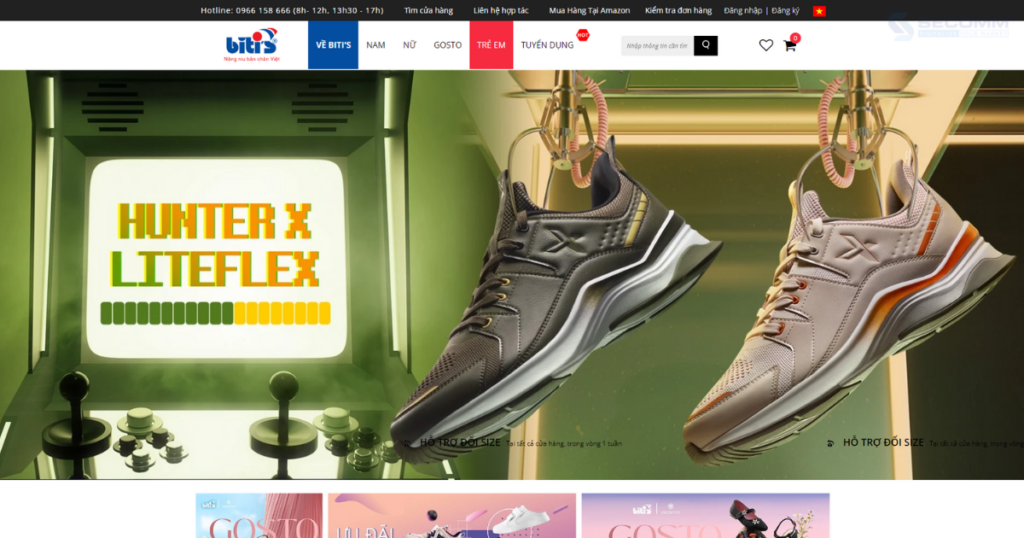
- Fashion field: Footwear
- Website: https://bitis.com.vn/
- eCommerce platform: Haravan
- Traffic: 206.6K/month
- Rating: 2,549 (Vietnam), 149,642 (Global)
- Estimated value: $8,966
8. Orchard
Orchard, which was founded in 2004, is a supplier of more than 200 luxury perfume brands from across the world. Orchard has implemented eCommerce promptly to tap the “gold mine” of this industry and become the No. 1 perfume retail brand in Vietnam. Orchard’s eCommerce website is now the favorite destination for customers who want to buy perfume online.
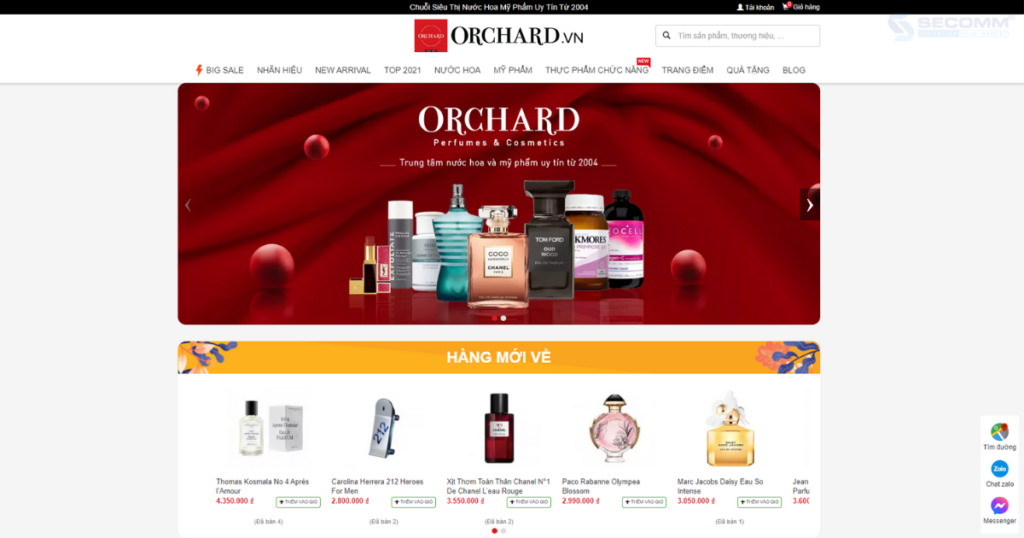
- Fashion field: Perfume
- Website: https://orchard.vn/
- eCommerce platform: WooCoomerce
- Traffic: 134.8K/month
- Rating: 6,800 (Vietnam), 372,708 (Global)
- Estimated value: $4,437
9. ONOFF
ONOFF was established in 2005 with the goal of providing daily comfort to everyone. ONOFF has advocated for adopting an eCommerce strategy by investing in building Magento websites like Canifa in 2016. As a result, the brand is gradually synchronizing on online and offline channels, with a customer loyalty rate of 80% maintained at all times, allowing ONOFF to more firmly believe in its goal of becoming the leading lingerie brand in Vietnam and a chance to conquering the ASEAN market in the next three years.

- Fashion field: Lingerie
- Website: https://onoff.vn/
- eCommerce platform: Magento
- Traffic: 79.5K/month
- Rating: 10,061 (Vietnam), 518,911 (Global)
- Estimated value: $9,289
10. Rabity
Rabity is a children’s fashion brand that was launched in 2000. Currently, Rabity is the sole Disney and Marvel partner with image rights for children’s fashion lines ranging from 0 to 14 years old. Rabity is pleased to have been the pioneer in deploying the first eCommerce for children’s fashion in Vietnam. Rabity is now present on all eCommerce channels and has its own eCommerce website.
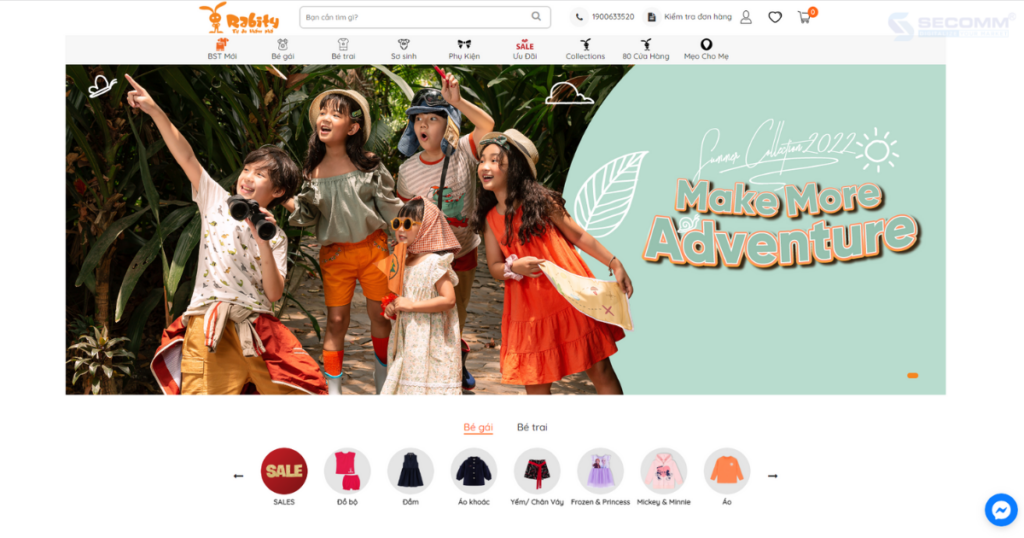
- Fashion field: Childrenswear
- Website: https://rabity.vn/
- eCommerce platform: Haravan
- Traffic: 12.3K/month
- Rating: 43,904 (Vietnam), 1,972,408 (Global)
- Estimated value: $15,335
Overall, fashion businesses are achieving several successes after developing their own eCommerce websites. However, the fashion eCommerce industry needs careful consideration of tactics to take the most successful actions in the short term and in the long run. Of course, to do that challenging task, fashion companies must find a well-known or build skilled IT team.
 2
2

 5,348
5,348

 0
0

 1
1
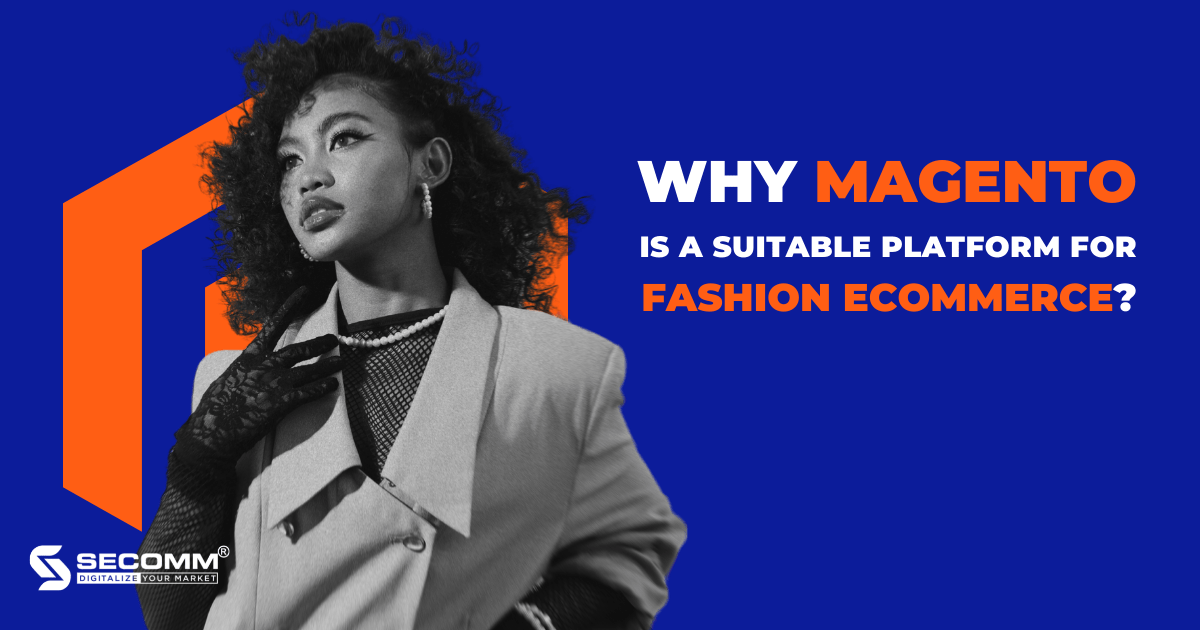
WHY MAGENTO IS A SUITABLE PLATFORM FOR FASHION ECOMMERCE?
Fashion eCommerce has shown excellent development potential in recent years, with a worldwide market worth USD 759.5 billion in 2021 and predicted to reach USD 1 trillion by 2025. Clothing (+12.7%), Footwear (+11.6%), and Bags and accessories (+8.5%) are expected to increase the fastest in 2023.
Furthermore, fashion is one of the “four pillars” of Vietnam’s e-commerce economy, accounting for 43% of all online purchases, trailing only the eGrocery industry. According to the e-Conomy SEA Report 2021, 47% of Vietnamese respondents think that fashion eCommerce has become a consumer purchasing habit.
Despite the numerous prospects, this industry has multiple problems, including numerous rivals, continually changing consumer preferences, pushing firms to diversify models, Omnichannel sales to create more customer touchpoints, and so on.
As a result, to properly deploy fashion eCommerce, company managers must examine various elements, including the fundamental factor of developing a website. Among eCommerce platforms such as Shopify, BigCommerce, and WooCommerce, Magento is renowned as a platform used by many famous brands to establish eCommerce, including Canifa, Hoang Phuc International, OnOff, and others. So, why have these companies selected Magento?
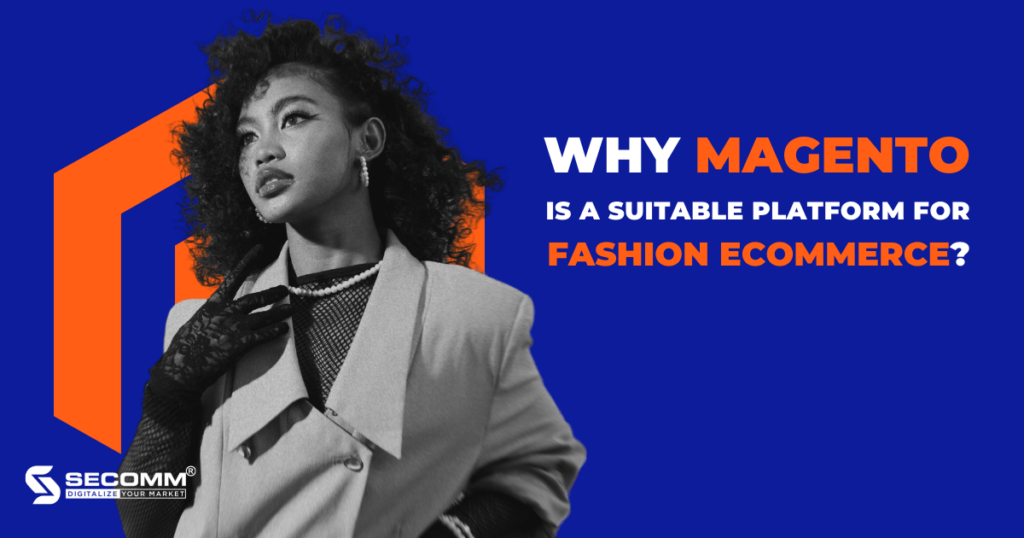
Fashion eCommerce requirements
Website interface
The demanding consumer base with excellent aesthetic sensibility is a common element of the fashion sector. This necessitates that fashion firms concentrate on the design of the eCommerce website interface, particularly the homepage, which must be professional and eye-catching.
The disadvantage of online fashion purchasing is that you cannot “See it with your own eyes, touch it with your own hands.” Therefore, the more detailed and colourful the image/video, the more authentic and trustworthy it will appear to buyers.
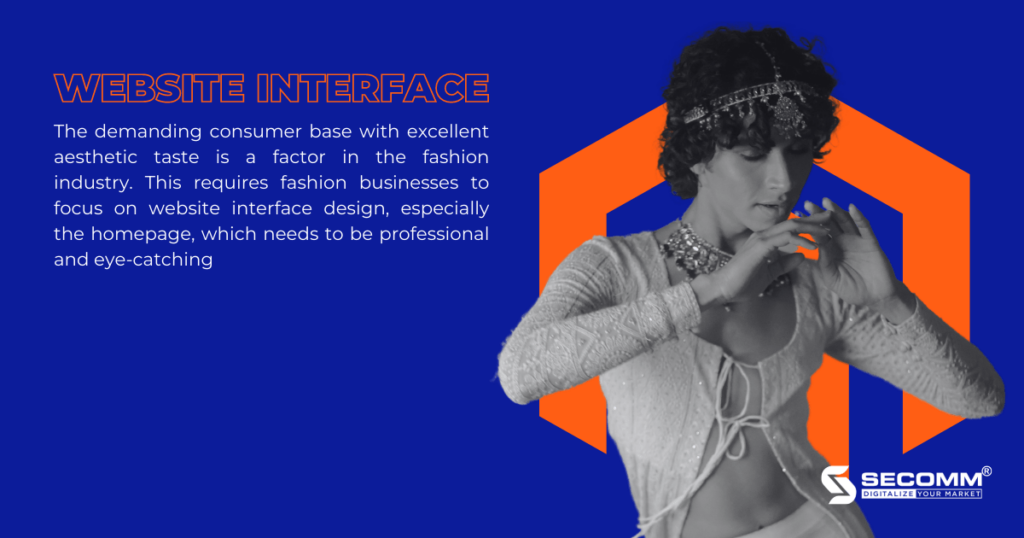
In terms of the UI (User Interface), visualisation affects the capacity of customers to engage with the website, helping to answer the question: “Has the user being able to navigate clearly from one page to another in a convenient way? “
Another website interface design is user experience (UX), from consistency in call to action button (CTA) or illustration locations, everything should be more convenient to create the most consistent experience for all website users.
Functional system
Many functionalities are required for an online fashion business website to satisfy industry requirements.
The fashion sector is distinguished by multichannel sales and numerous client touchpoints. For instance, on e-commerce platforms (Shopee, Lazada, Tiki, Sendo), social networking channels (Facebook, Tiktok, Zalo, Instagram), and e-commerce websites and applications. When implementing eCommerce for fashion companies, administrators must employ an Omnichannel approach.
Usually, the fashion industry will have a lot of product categories and collections, from clothes, and shoes, to bags and accessories, so consumers’ need to search for products on the website and e-commerce app is very high. From there, businesses should build multi-layer menus and advanced product search functions by keywords or filters to serve the needs of searching and navigating customers.
Furthermore, because fashion is a highly competitive market, the more influential the communication strategies, the more orders the brand will obtain. Loyalty Programs, Livestream, Shoppertainment, Affiliate Marketing, and other fashion-related communication strategies on websites and mobile apps.
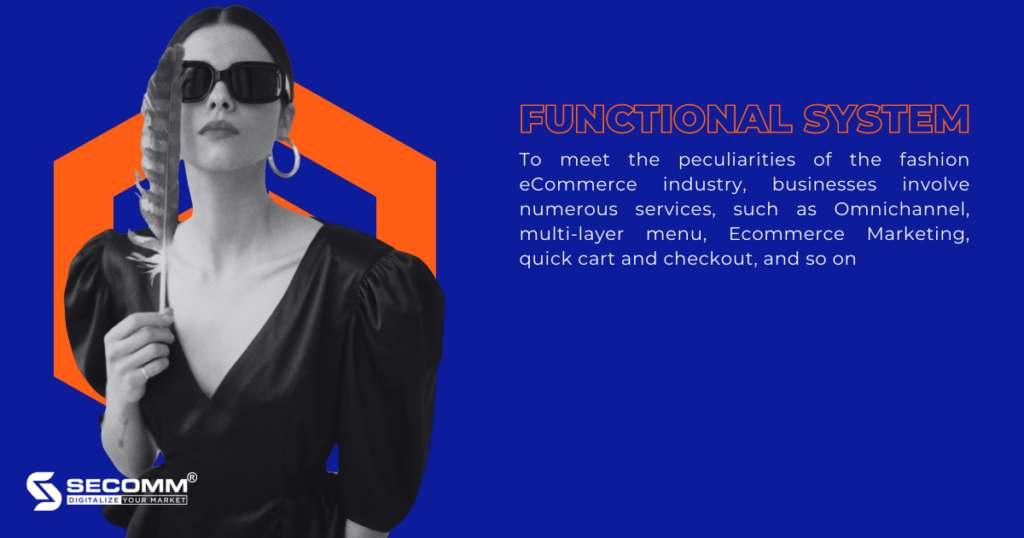
Clothing, bags, shoes, and fashion accessories are frequently low-involvement goods, thus creating a rapid shopping cart function would assist consumers to speed up the purchase process, increasing online sales for businesses.
Businesses should construct a feature to help categorise consumers to take care of and tailor the experience for each type of client in the fashion sector, which frequently has several customer groups, such as new, old, and VIP. From there, organisations will gradually use the understanding of each sort of consumer to develop better business solutions in the future.
After all, fashion eCommerce systems must frequently manage high traffic levels during peak seasons.
Integration
Businesses require a highly integrated website construction platform to properly execute fashion eCommerce, including Omni-channel, management system, payment, shipping, analytics, and reporting.
Because the fashion industry is distinct, it needs considerable coverage across all sales channels to reach many potential customers. Therefore, while implementing eCommerce, businesses have to use an Omnichannel strategy. However, to synchronise all data from front-end to back-end when deploying Omnichannel, companies require a highly linked system across all sales channels.
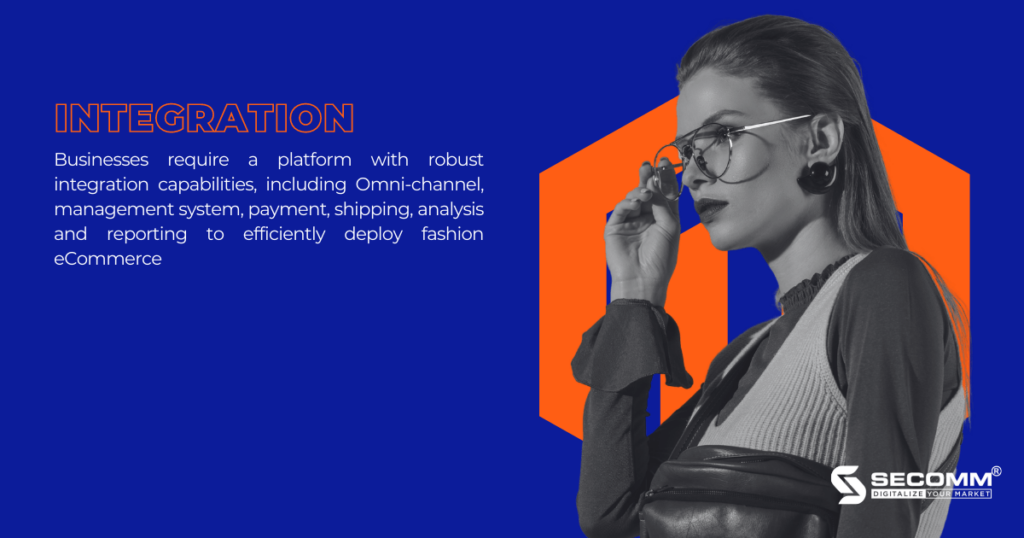
Simultaneously, fashion firms frequently utilise several third-party management systems such as POS, CRM, ERP, and BI, so businesses must find an eCommerce platform that can combine and manage all data information on” a single screen”
Furthermore, companies must vary payment and delivery methods so that clients have more options when buying fashion goods.
Finally, organisations must integrate analytics and reporting tools to provide real-time measurements with the most user-friendly reporting table. From there, firms could provide more practical guidance in the future.
Scalability
Fashion businesses will have many different sizes, from startups, SMEs (small and medium enterprises), and new entrants to large corporations. Moreover, each business will have a different operating model, such as B2C, B2B2C, and so on.
All sizes and operating models will have unique requirements for each stage of brand development, so businesses need a platform to accompany them throughout the journey, preventing the circumstance of switching platforms consumes time and money when firms install eCommerce.

In summary, companies require a comprehensive platform to efficiently implement fashion eCommerce for the long run, including website interface, functional system, integration, and scalability.
How does Magento solve the eCommerce problem for the fashion industry?
Website interface
When designing a fashionable eCommerce website interface on the Magento platform, businesses have many choices, including using existing themes, customising themes, and designing their own interface.
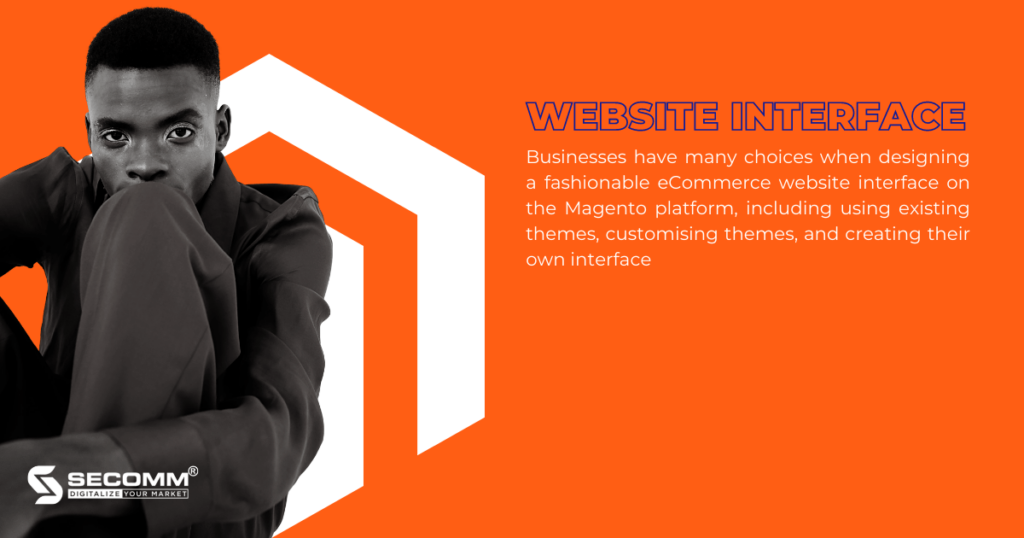
For using existing themes, companies may find these in the marketplace, developer community, or partner for Magento-specific themes in the fashion industry. This helps businesses reduce the expense of interface design, but it limits firms’ brand positioning because the interface is easily imitated by other websites.
For customising themes, businesses can save money and add brand identification aspects like colours, fonts, layout and so on. However, to efficiently set up and customise the website interface, businesses require a team with significant knowledge and experience.
For designing their own interface, businesses will have a “tailored” website for their fashion brand. However, this will necessitate a more significant investment in development expenditures and a more competent workforce.
When using Magento to develop an eCommerce website, most fashion businesses often choose a customised theme or design their own interface to support a centralised eCommerce business.
Functional system
The Magento platform has all the capabilities needed to create a comprehensive eCommerce website, from essential to complex. At the same time, this platform permits the development of custom functions to tackle unique difficulties in the fashion business.
Basic features that assist businesses in running an efficient and seamless fashion eCommerce website, such as:
- Catalog Management: Manage all data, processes, categories, attributes, prices, inventory quantities, and images/videos to operate and optimise the efficiency
- Store Management: Manage product inventory and each branch’s business activities and personnel
- Cart and Checkout: Manage the shopping cart and customers’ information when they check out
- Customer Management: Manage customer information to increase marketing efficiency, purchase experience, and customer satisfaction
- Marketing Management: Optimize SEO and implement marketing strategies with tools to increase business sales
- Sales Management: Create and manage sales, order, payment, and shipping processes
- Content Management: Create and optimise all content elements for CMS pages, image storage, customise themes, and design websites
- System Management: Delegate administrators to review the best methods for website security and maintenance
- Analysis and Report: Support tracking and measuring eCommerce system performance and developing future strategies
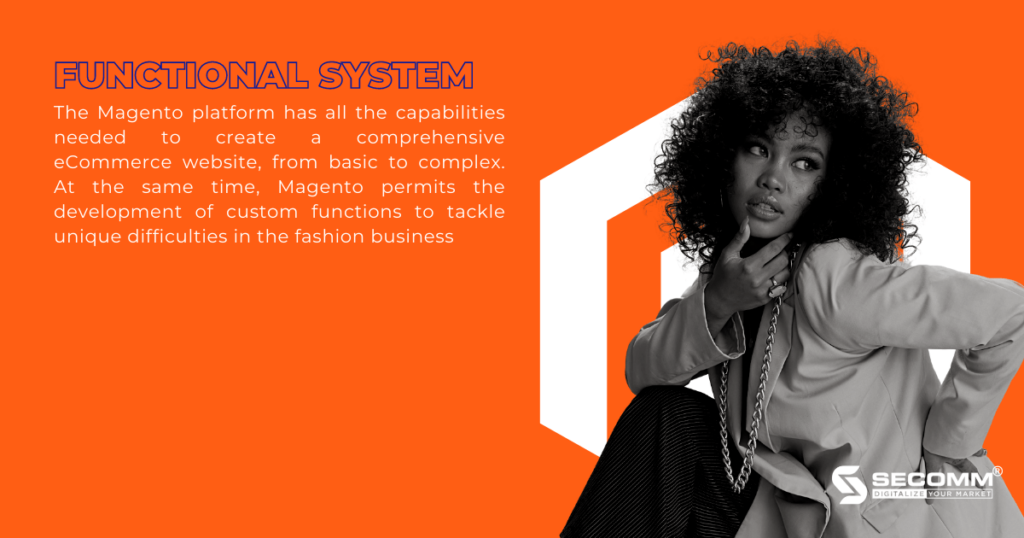
Advanced functionality that enhances the online shopping experience for consumers, such as:
- Advanced features that improve the online buying experience for customers, such as:
- Advanced search (Elasticsearch, live-search) to improve the website’s ability to locate items.
- PWA (Progressive Web Apps) allows the website to have the same mobile functionalities and interactions as a native app.
- Advanced SEO to examine indexed web pages, assess the SEO quality of each page and make recommendations to improve website ranks.
- MSI (Multi Source Inventory) aids in the administration of items across several stores, significantly increasing inventory management.
Specific functions are those that assist businesses in dealing with fashion industry issues, such as:
- The multi-layer menu aids in displaying the range of fashion products
- Advanced search to help consumers find the product they’re looking for
- View 360 to see fashion product details
- AR/VR to replace the real shopping experience
In general, Magento can create any sophisticated functional system, with infrastructural development before and after depending on the demands of each organisation.
Integration
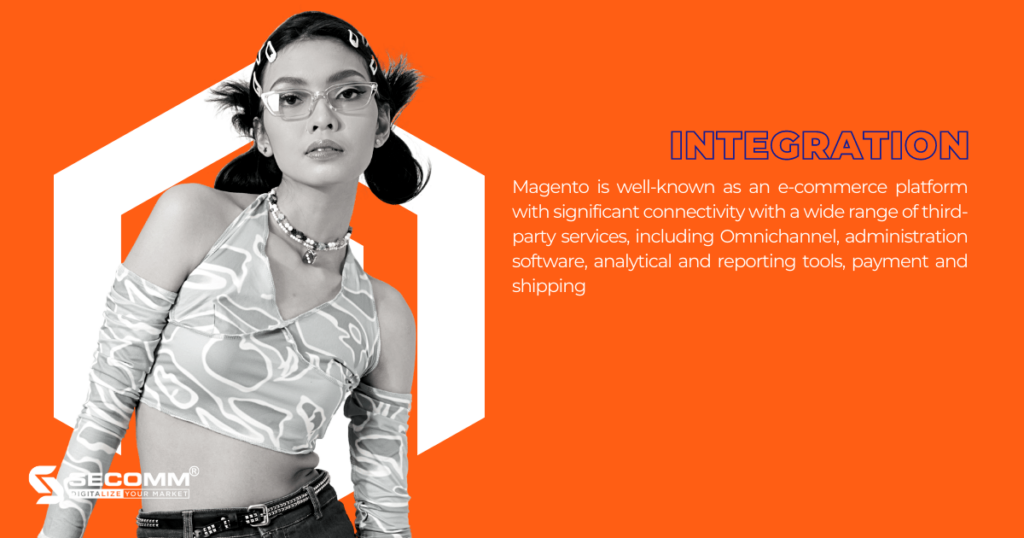
Magento is well-known as an e-commerce platform with significant connectivity with a wide range of third-party services, including Omnichannel, administration software, analytical and reporting tools, payment and shipping.
- Payment: Easily link the Magento system with current popular payment methods such as card payment (VISA, Mastercard), e-wallet (MOMO, Zalopay), payment gateway (OnePay, VNPay, PayPal) or COD to help diversify payment methods
- Shipping: Easily integrate shipping providers like Giao Hang Nhanh, Giao Hang Tiet Kiem, Ninja Van, Viettel Post and shipping tracking applications to optimise delivery processes
- Administration software: Integrating with back-office management and operation software (ERP, CRM, POS) like SAP, Salesforce, Ocracle to help operate all processes and resources in the organisation
- Business Intelligence tools: Link with business analysis tools like Power BI, Tableau, and Looker to offer database-driven analysis and reporting
- Omnichannel: Combine all sales channels on the same system to control data and operations from offline to online business
Scalability
Magento allows organisations to extend from one website to many distinct websites on the same system to satisfy the requirements of company-scale development. This implies that organisations can access and manage data from a single central Magento system.
With Magento’s language-switching functionality, businesses can create an attractive eCommerce website with customer-friendly content and languages. Furthermore, the Magento system enables businesses to effortlessly exchange currencies, allowing them to grow into new markets in a variety of nations.
From then, Magento can help businesses scale and function effectively without switching to another eCommerce platform from the beginning of business through the period of expansion.
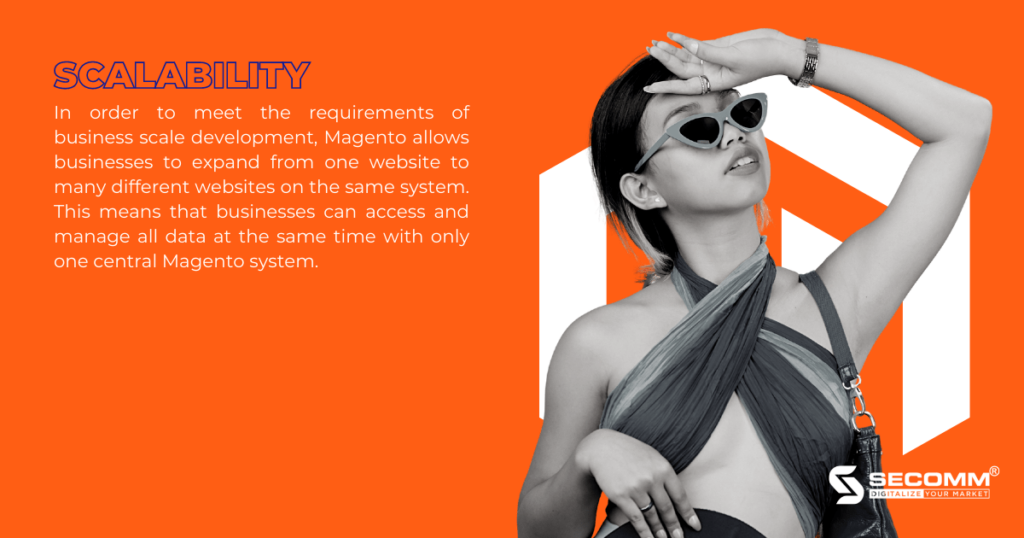
In a nutshell, Magento is an e-commerce platform that caters for the demands of all types and sizes of fashion businesses, from website interface design and functional system development to integration and scalability. However, there are numerous challenges that firms must overcome when implementing fashion eCommerce with Magento, such as high installation costs, long construction times, and the requirement for highly skilled employees.
Recognising the aforementioned business difficulties, SECOMM provides free consultation services on technology and resource solutions for each company.
Contact SECOMM now for more details!
 2
2

 2,041
2,041

 2
2

 1
1

FASHION ECOMMERCE 2022: POTENTIAL, ADVANTAGES & CASE STUDIES
eCommerce has become an essential business model that fashion brands must utilize not only to survive during the COVID-19 pandemic but also to assist companies in adapting to changing customer behavior, providing competitive advantages for future breakthroughs.
As a result, fashion eCommerce has become a crucial business trend for many fashion businesses today, from start-ups to “giant” corporations.

1. The potential of eCommerce in the fashion industry
According to Statista, the compound annual growth rate (CAGR) of the fashion eCommerce market is predicted to be 14.2% from 2017 to 2025. The CAGR is forecast to reach a value of USD 1 trillion by 2025, in which the US market accounts for about 20%, equivalent to 204.9 billion USD.
In the Vietnamese market, fashion eCommerce is the second most important sector, just after eGrocery (The Vietnam eCommerce White Paper in 2021).
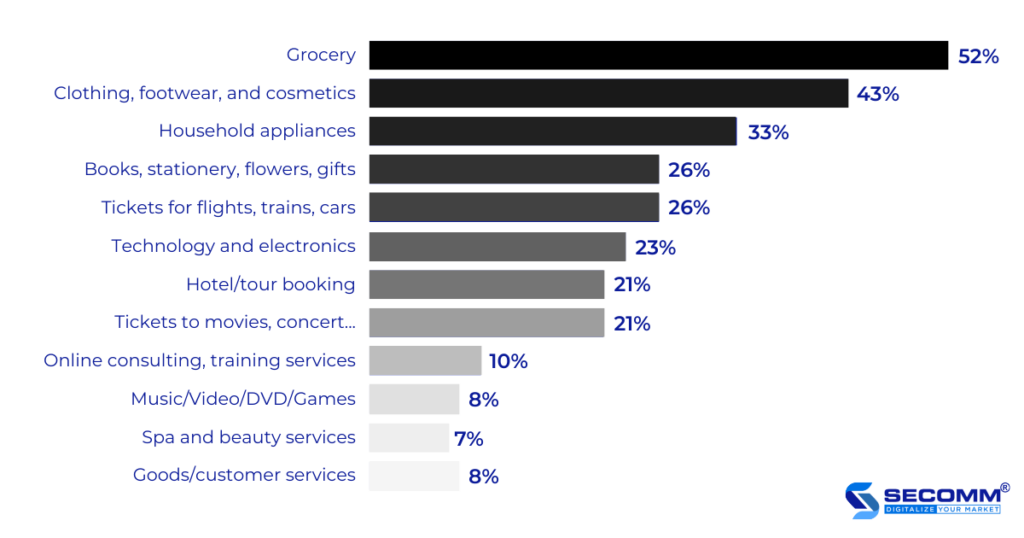
2. The advantages of implementing eCommerce in the fashion industry
2.1. Increase the breadth of your business
The use of eCommerce will provide fashion firms with a new sales channel, along with offline commercial activity in showrooms. For geographical factors, eCommerce transcends place and time to allow customers to purchase whenever and wherever they choose.

Simultaneously, eCommerce is a prominent avenue for reaching customers, particularly in the sphere of fast fashion for women. Marketing activities such as Livestream, Shoppertainment (Shopping with entertainment), Affiliate, and so on are more effectively carried out, leading to the extension of the commercial scope for enterprises.
2.2. Adapting to changing customer behavior
Following the COVID-19 epidemic and the social distancing order, consumer behavior has shifted dramatically, with the transition from physical to online buying rising over time in all categories. In the fashion business alone, the percentage of online customers climbed from 18% to 48% in 2020–2021. As a result, it is critical for fashion businesses to implement eCommerce.
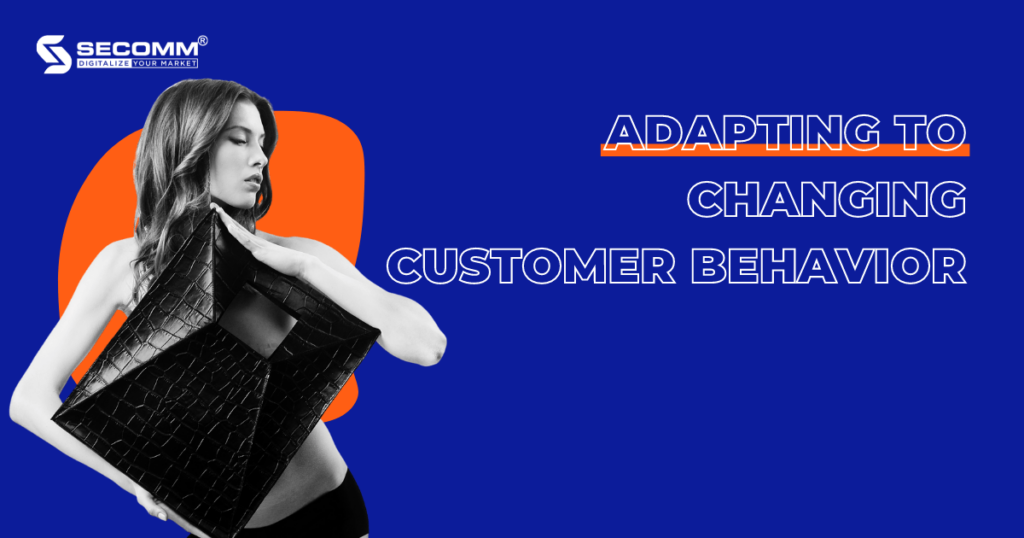
After the epidemic, consumer behavior altered drastically, such as waiting until D-Day to purchase items. Furthermore, by utilizing eCommerce technologies, organizations can follow, analyze, and synthesize the consumption behavior of each target group, something offline purchasing cannot accomplish. This ensures that businesses always have enough aggregated and forecasted data to implement business plans.
2.3. Improve the user experience
When technologies that improve user experience in e-commerce are used, customer purchases will be made faster.
Visual experiences such as photos, movies, virtual reality experiences, and so on provide customers with full product information and expertise, enabling a speedier purchasing process. VR / AR technology enables people to shop for garments, accessories, and shoes online in the same way they would in a store.
For example, the American Apparel company has used AR to show shoppers more product information, like detailed descriptions, availability, colors, and buyer reviews.

eCommerce allows businesses to tailor the experience for consumers by collecting, evaluating easily, and summarizing the consumption habits of each target group, often with the following features: Recommend products, Products seen, and so on.
eCommerce provides a seamless experience for customers across many channels such as social media (Facebook, Instagram, Tiktok, Zalo, etc), eCommerce marketplace (Shopee, Lazada, Tiki, Sendo, etc), eCommerce website, and mobile app.
3. Case study
3.1. Shein – The unicorn of the fashion eCommerce industry
Shein is a Chinese eCommerce site created in 2008 that specializes in apparel and accessories. With the motto “everyone can enjoy the beauty of fashion,” the company pushes to give consumers a diverse selection of product options. Shein is currently regarded as a fashion “empire” with a valuation of $ 100 billion – more than Zara ($ 69 billion) and H&M (23 billion) combined.
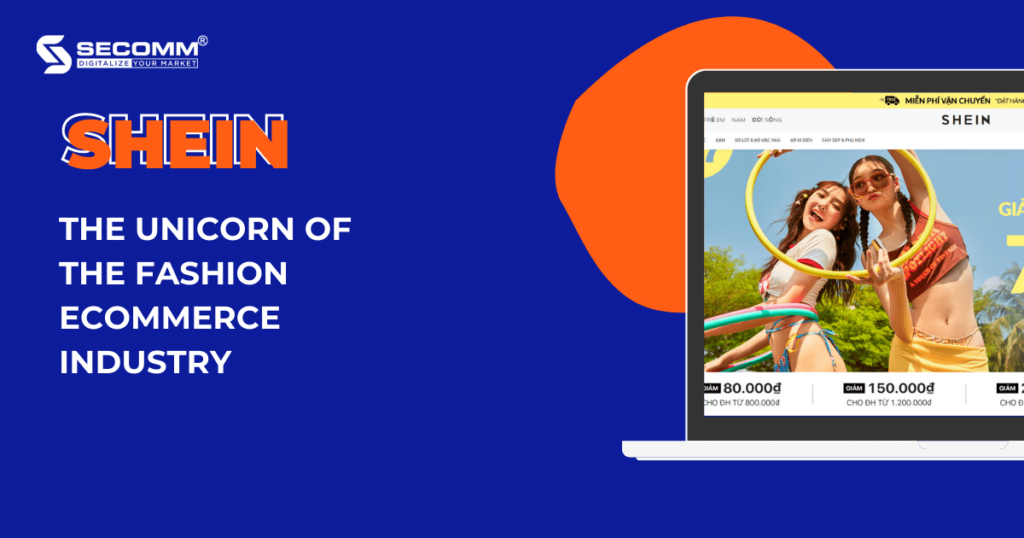
Shein focuses on the youthful client sector of Gen Y and Gen Z, who use the Internet often. As a result, this brand has used technical components to reach more consumers in an appropriate and exact manner.
Shein created an eCommerce system that included a website and a mobile app to target overseas markets such as Europe, America, Australia, and the Middle East. Shein then advocated Social Commerce, Ecommerce Marketing, Affiliate Marketing, KOC, and other tactics to improve brand awareness and engagement.
In 2021, Shein’s mobile app exceeded 7 million monthly active users in the US alone (Airnow Data), and the hashtag #Shein garnered more than 10 billion views on TikTok (Jing Daily). Revenue reached $15.7 billion in 2021, up 60% from 2020 ($9.8 billion). It can be seen that Shein is a clear example of the effective application of eCommerce to capture market share in the fashion industry.
3.2. Coolmate – The missiles in the realm of fashion eCommerce in Vietnam
Coolmate is a menswear startup that was established in 2019. Coolmate is a mix of the words “cool” and “mate,” which means that the brand’s major purpose is to be a fashion buddy for customers. After barely two years of operation, this company received a $500,000 funding call from Sharktank Vietnam.
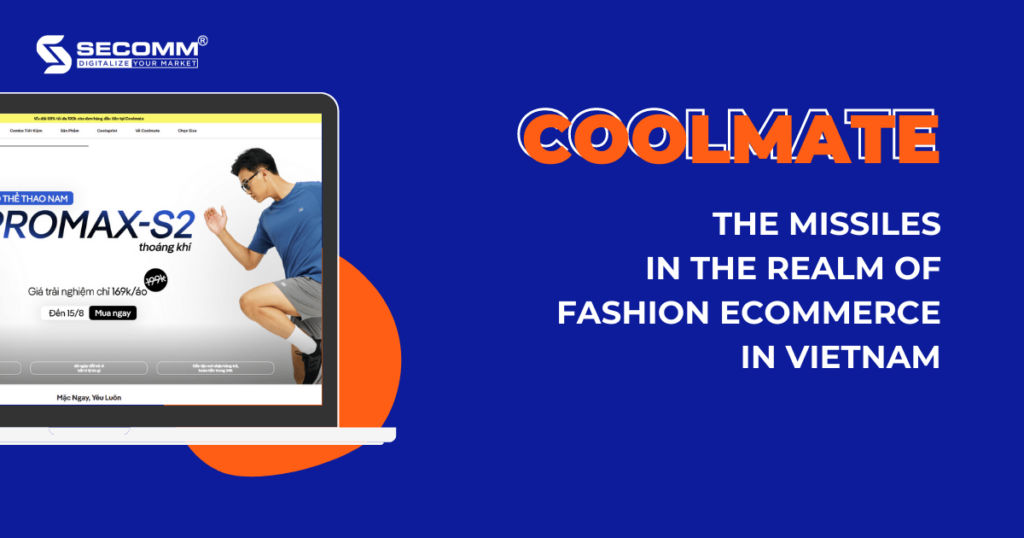
Coolmate utilizes the Direct to Customer Ecommerce (D2C eCommerce) model and concentrates on developing its own fashion website to provide a quick and cost-effective buying experience. At the same time, this brand prioritizes product quality, which is 100% made in Vietnam and meets export standards at low costs. Furthermore, to implement e-commerce faster, Coolmate advocates thoroughly apply the strategy of Ecommerce Marketing, Affiliate Marketing, Email Marketing, etc.
Aside from the $500,000 agreement for a 12.5% interest, 2.5% of the consultancy shares pledged, this fledgling business has other noteworthy statistics. Coolmate’s sales will reach VND 139 billion in 2021, up 3.5 times from 2020, with revenue expected to reach VND 440 billion in 2022 and an IPO (Initial Public Offering) by 2025. In general, eCommerce has considerably contributed to Coolmate’s development, as well as providing the groundwork for fashion businesses to follow to grow by market trends.
3.3. Yody – The behemoth chose to compete in the fashion eCommerce race
Yody (previously Hi5) is a family apparel label that was founded in 2014. To provide Vietnamese fashion goods made of high-quality materials to customers in various regions of Vietnam and throughout the world. Yody now employs over 700 people and has 90 outlets around Vietnam.
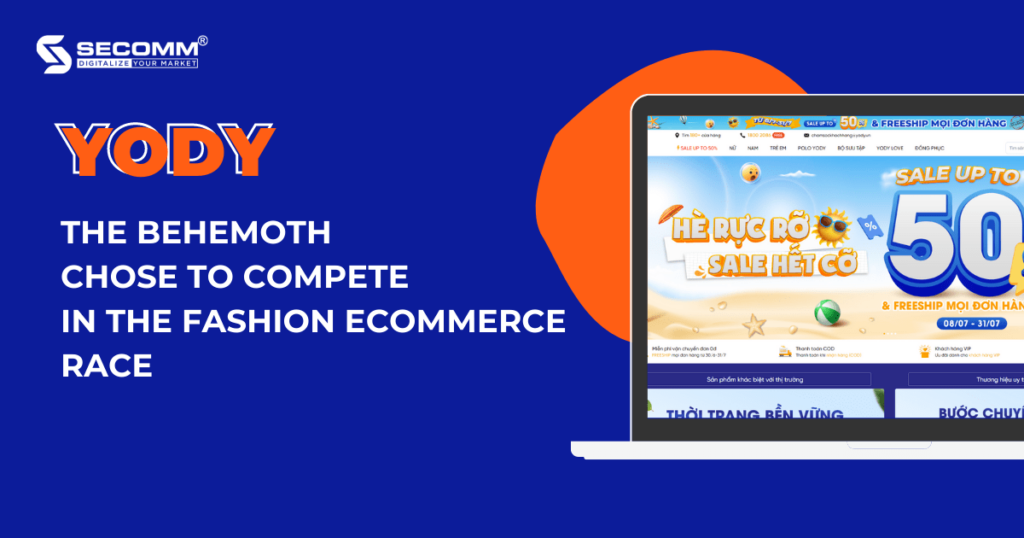
This fashion brand prioritizes the “tripod” of human resource development, product quality, and technology investment. Yody focuses on talent recruiting and culture training to engage employees in human resource development. In terms of products, Yody designs for comfort and convenience, and can be utilized in various situations, such as going to work, going out, attending meetings, and so on.
Regarding technology, Yody focuses on implementing an online sales strategy across Omni-channel such as eCommerce marketplaces, an eCommerce website, Facebook, Livestream, and so on to compete in the eCommerce race, as well as adapting to changing consumer behavior.
In 2016, Yody was selected as one of the ten outstanding young start-ups in Vietnam. By 2021, Yody’s physical sales will have dropped by 65%, but the internet segment has increased by more than 10%. Therefore, the company continues to aim to increase online revenue by 20% in the next year.
In a nutshell, how to apply fashion e-commerce will depend on the size and strategy of each company, but eCommerce is a prerequisite for successful business in this industry.
 2
2

 4,046
4,046

 1
1

 1
1

CLUTCH ACKNOWLEDGES SECOMM AS A TOP 2022 ECOMMERCE DEVELOPERS IN VIETNAM
SECOMM is a trusted provider of full-service ecommerce solutions. Founded in 2014, we’ve been helping growing brands, and renowned companies get a steady foothold in the ecommerce space.
We enable our partners to overcome any challenges brought by the evolving digital age through expertise and innovation.
Today, we’re honored to announce that we’re among the top B2B companies on Clutch in Vietnam. The ratings and reviews platform’s 2022 research states that we’re one of the leading ecommerce development companies in Vietnam this year.

Clutch Acknowledges SECOMM as a Top 2022 Ecommerce Developer in Vietnam
For context, Clutch is a B2B ratings and reviews platform committed to helping small, mid-market, and enterprise businesses connect with capable service providers. Clutch serves as a valuable resource to businesses when it comes to market research. The platform guarantees unbiased information by interviewing clients of registered vendors directly.
Take a look at some of the 5-star ratings we’ve recently acquired:
“The professionalism of the company is second to none! They are extremely responsive, and their communication is concise and informative.”
— Rick Thurlow, Senior Business Manager, Jasnor (Australia)
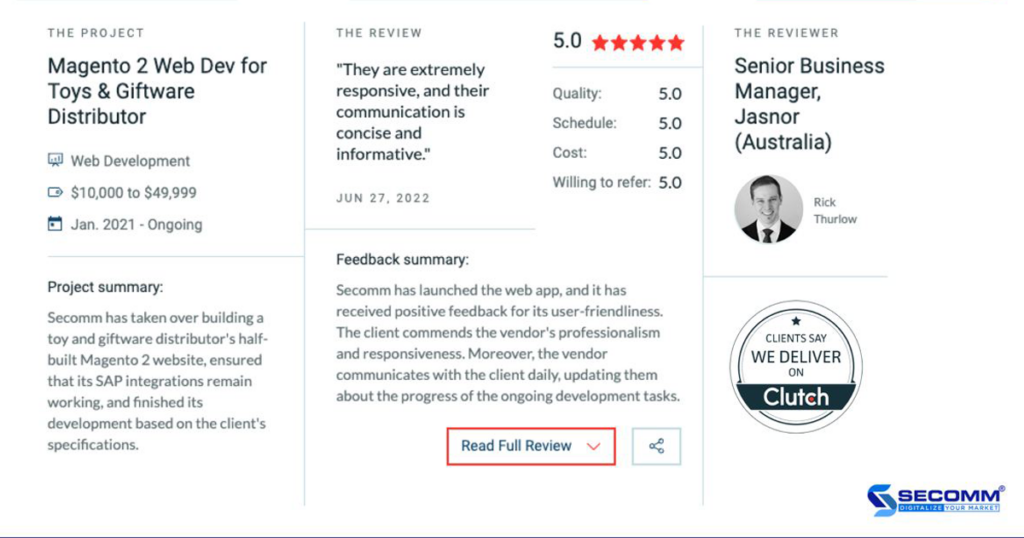
“I think the best thing about working with SECOMM is how quickly they can respond to a change you would like them to implement or to fix an error that you identify.
Even when it came to us changing things on this project that weren’t in the original scope, they would talk that change through with us to identify the best way of handling it, and then implement that change in a timely manner.”
— Stuart Duff, Founder & CEO, Laybyland Pty Ltd
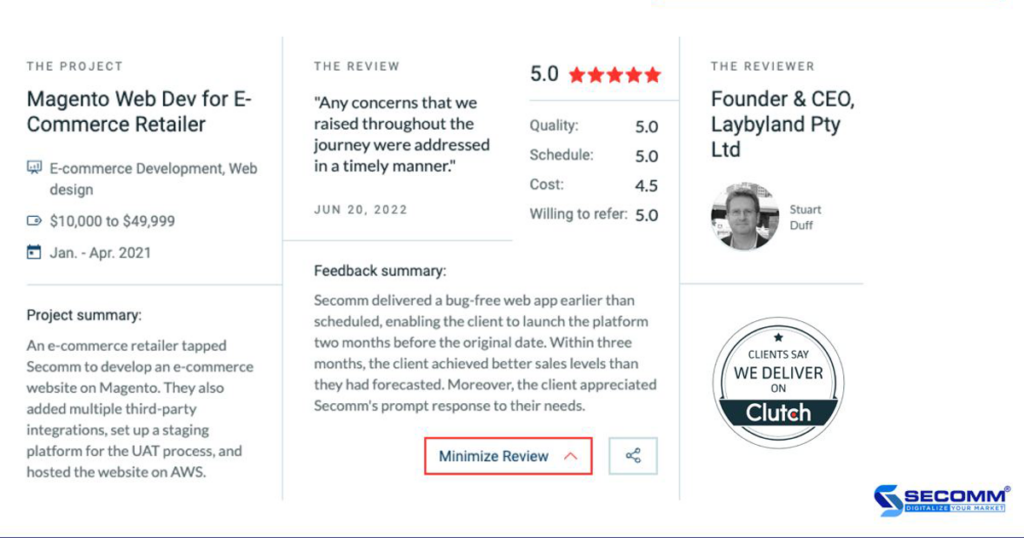
We would like to thank our partners who took the time and effort to write their descriptive, helpful feedback about our work. Don’t forget to check out the full case studies on our Clutch profile.
For inquiries about our full-service ecommerce development, please get in touch with us today!
 2
2

 4,430
4,430

 12
12

 1
1
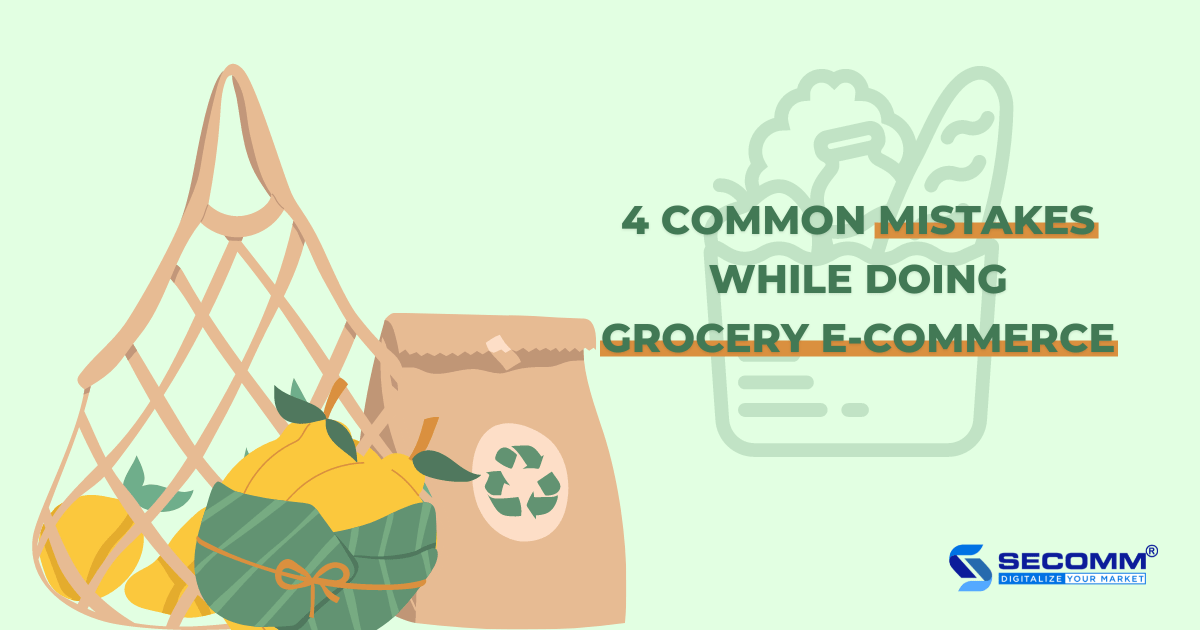
4 COMMON MISTAKES WHILE DOING GROCERY E-COMMERCE
Grocery e-commerce is an inevitable business trend in the current Vietnamese e-commerce market. Some grocery stores have implemented e-commerce very early and have achieved great success, such as An Nam Gourmet, Bach Hoa Xanh, WinMart, and Co.op Online.
However, not all businesses are fortunate to deploy effective e-commerce because risks and wrong decisions when doing business can happen in any market, not only in the eGrocery market.
Some mistakes are fixable, but there are mistakes no matter how much budget and time it takes to make up. Here are some online grocery store mistakes that eGrocery business leaders need to know.
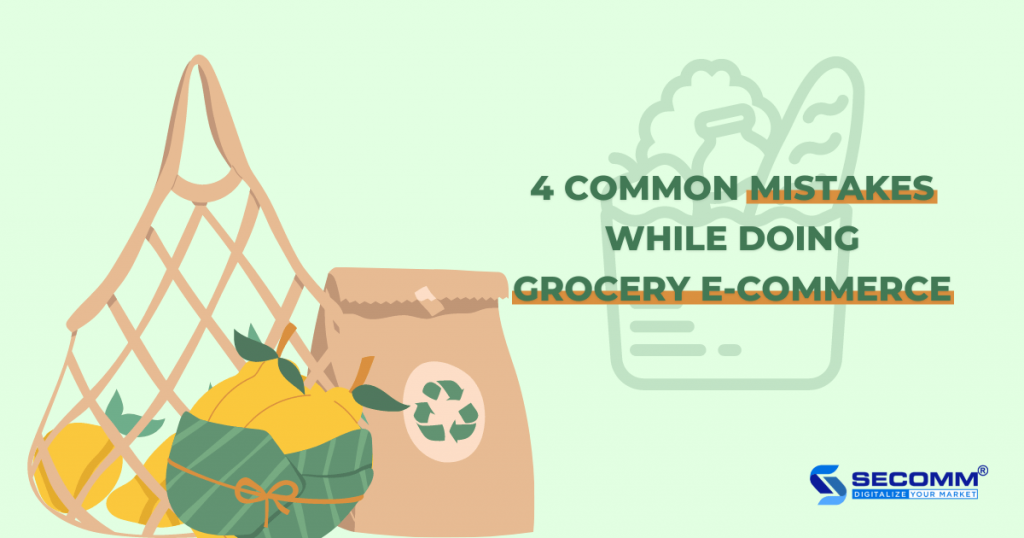
Building operating procedures for complex e-commerce systems
The grocery store business process in chain stores and e-commerce websites is entirely different. However, when implementing e-commerce, many businesses put the entire existing process on the website system without any customization or modification to conform to general operating procedures.
To shift business from offline to online, businesses must face difficulties such as synchronizing data from POS (Point of sale), e-commerce platforms, and e-commerce websites for other systems like CRM, ERP, BI, etc.
Grocery e-commerce is an extraordinary industry, with many complex features such as products with many units, selling methods, weight differences, constantly changing prices (day/week/month/year), expired products that need to be canceled, or imported new must have specific data, complicated payment processes, cumbersome warehousing operations, etc.
In particular, most products in the grocery store are fresh and fast food, so the damage rate is high, and the delivery time needs to be faster than in other fields. In addition, for these items, “housewives” also need to choose the correct delivery time.
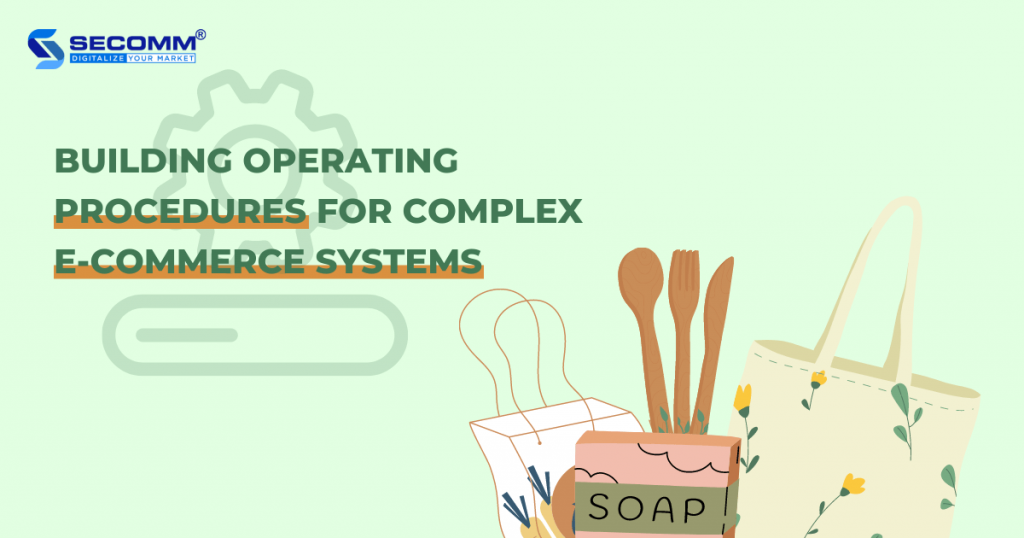
Because of the complexity of the operation process, the requirements for the e-commerce system are also more unique compared to other industries, making it difficult for managers to grasp the business situation and not be able to manage the number of products in stock in each branch.
Enterprises should build their in-house team or look for experienced grocery e-commerce developers to design the system operation process for specific industry and business problems that SaaS platforms cannot provide.
Wrong choice of an e-commerce platform for egrocery
An e-commerce platform is software that businesses use to build an e-commerce website. Choosing a platform is always the first step in the e-commerce business process, so choosing the wrong one will lead to the entire online grocery store strategy going down.
After a period of using the unsuitable platform, businesses are required to “change blood” with another platform. This mistake wastes time and budget to build an e-commerce website for businesses without bringing about the expected results. It takes time to recruit and train employees to get used to the new platform.
To avoid this unnecessary mistake, businesses need to clearly define short-term and long-term goals for the brand, thereby building the criteria for choosing the most suitable e-commerce platform. To do that, businesses can do their research or seek professional advice before making a final decision. Of course, this takes time, but it will save time in the long run for the business.
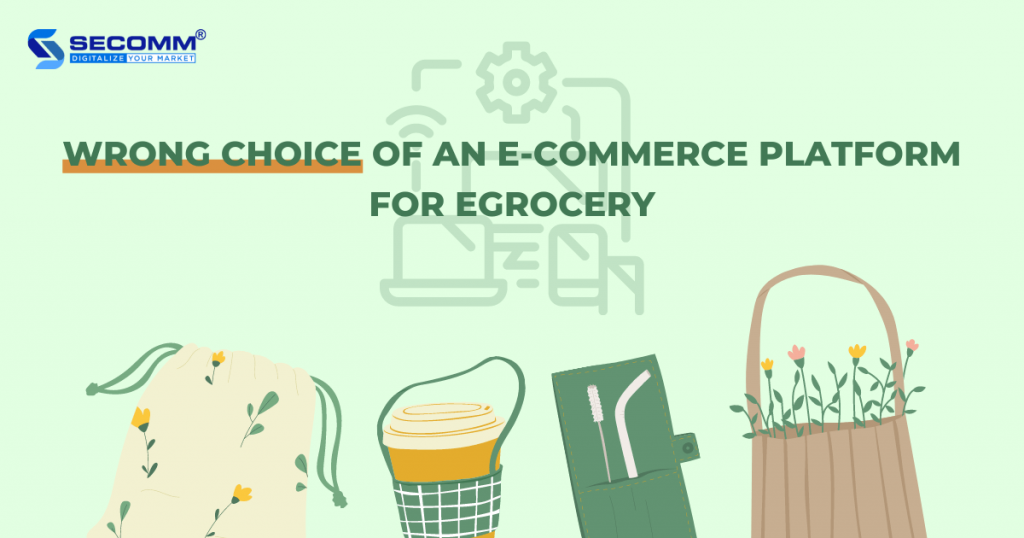
Currently, businesses that want to implement e-commerce step by step often choose Saas (Software as a service) platforms such as Shopify, BigCommerce, and Haravan in the early stages. This helps businesses save budget and time in the short term, market exploration, etc. Then, switch to open source platforms (Open Source) such as WooCommerce, OpenCart, and Magento to upgrade and expand the website system with convenient features for users and businesses.
Businesses with a long-term e-commerce business orientation often choose open source platforms right from the start to long-term companionship with businesses. Starting and developing continuously on an open source platform helps businesses save money and time to switch platforms, and own and fully control the system from source code to customer data, efficiently and proactively develop new features suitable for users and markets.
However, similar to building an operating process, choosing an e-commerce platform does not have a typical “recipe” for all businesses. Hence, each business needs to understand its business strategy, operating model carefully, and so on. in each stage of development.
Not investing in website interface design
The interface is essential in the grocery business, and it is necessary to meet UI (User Interface) and UX (User Experience – User Experience) standards. These are two crucial factors in any e-commerce website. However, many businesses forget these two factors when designing websites, leading to consequences such as an unattractive interface, not showing the characteristics of the business and the grocery, poor website performance, and page loading—slow, poor navigation, and few specialized functions for e-commerce, etc.
The UI / UX standard design has not been emphasized. However, the user experience on the enterprise’s website becomes worse, unable to retain users, affecting the revenue and brand positioning of the business.
So when choosing an e-commerce platform, businesses should also choose platforms that can help businesses customize the interface and functionality of the source code.
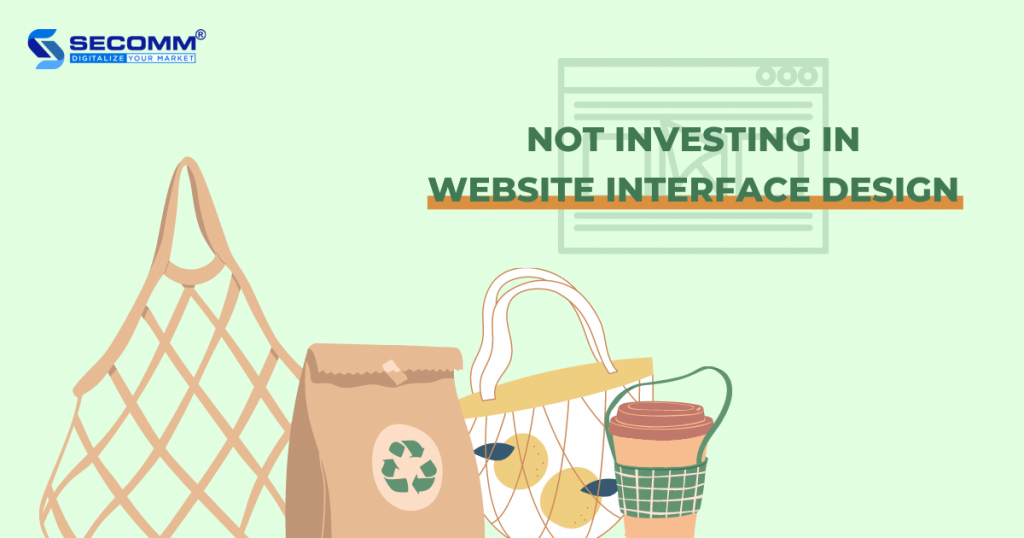
Currently, there are 3 ways to design the interface for a website:
- First, use existing themes (interfaces): Businesses can choose from themes available in the market, development community, or cooperation units. This will help businesses save costs, but brand awareness is low because it is easy to duplicate with other websites.
- Customize the interface based on the existing theme: Similar to the above, businesses can customize their characteristics by affecting the code in the front end. From there, businesses both save costs and express their characteristics.
- Design your interface: This is often more expensive than using a theme, but it meets the business’s most specific and specific needs.
Inappropriate feature build roadmap
At the right time, the functional system is not what “needs not to have” and “what has is not needed.” For example, in the early stages of entering the e-commerce market, businesses often do not have a certain number of users, so the functions of the Loyalty Program (loyalty program) are not necessary. Instead, businesses should focus on building functions that help exploit potential customers. Then, after having a stable number of users, businesses can gradually build more specialized functions, solving industry-specific problems.
Building a functional system that is not suitable for users’ needs at each time will waste time and cost to build a website without providing a satisfactory shopping experience, affecting revenue efficiency and can be left behind competitors in the industry.
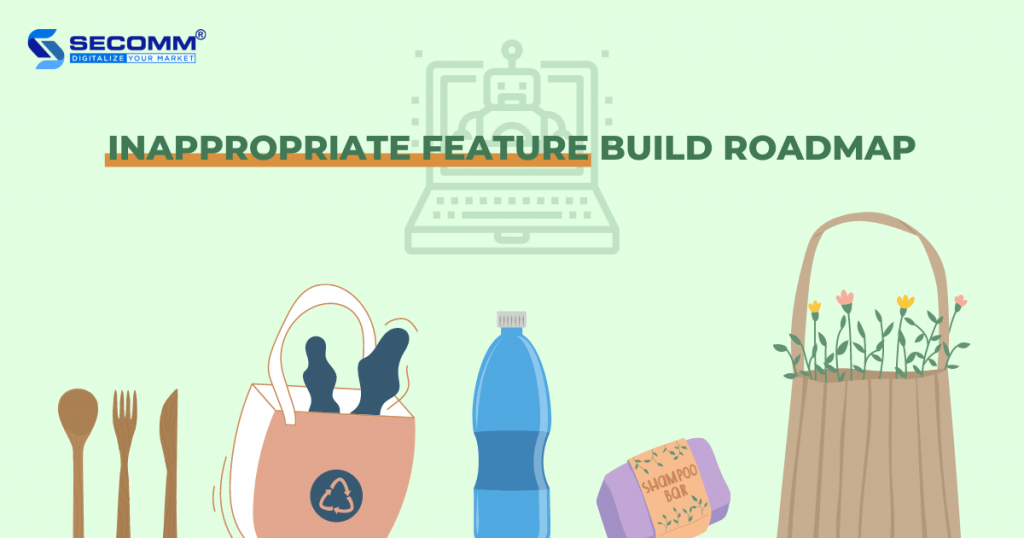
In general, egrocery is the “golden opportunity” for businesses to implement e-commerce. However, to capture opportunities and market share, businesses need to pay attention to many factors, especially the mistakes to avoid mentioned in this article.
With experience in successfully implementing complex grocery e-commerce systems like An Nam Gourmet, SECOMM understands grocery businesses’ obstacles. Contact SECOMM now for a free consultation on detailed e-commerce system development solutions!
 2
2

 2,139
2,139

 2
2

 1
1
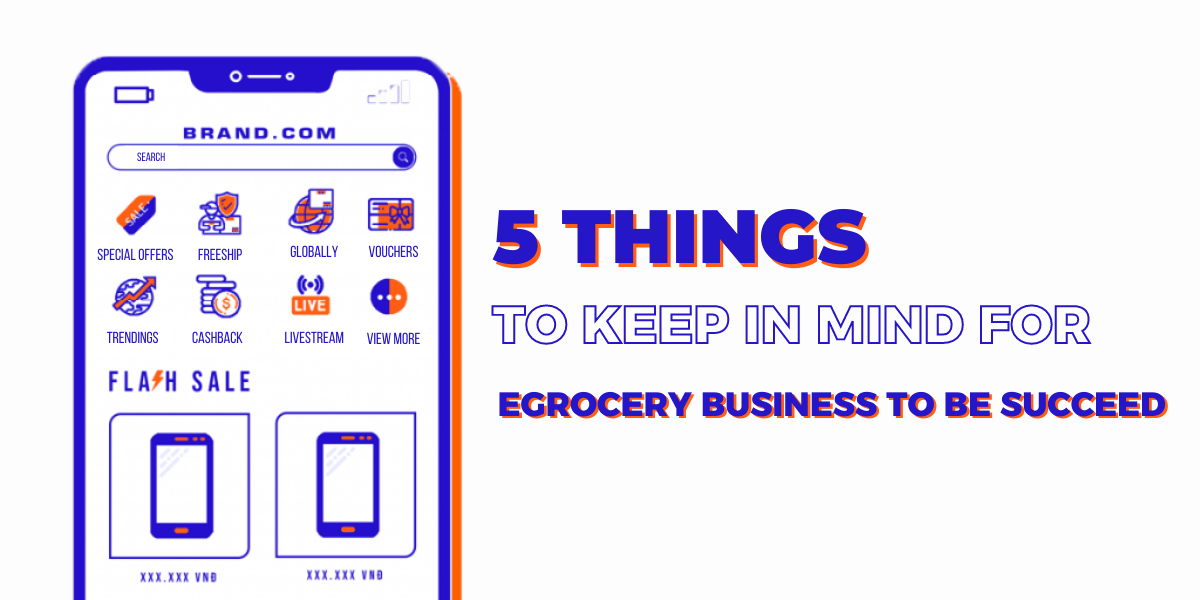
5 THINGS TO KEEP IN MIND FOR SUCCESSFUL EGROCERY BUSINESS
When grocery business activities face many obstacles such as strict lockdown measures by Covid-19, shortage of necessities, and geographical distance, the demand for egrocery increases daily.
Ecommerce marketplaces such as Tiki (Tiki Ngon), Lazada (Lazada Supermarket), Shopee (Shopee Fresh), and super apps like Momo (Online shopping), Grab (Grab Mart), etc. all, in turn, deploy egrocery to respond to consumer needs promptly. In particular, grocery stores’ eCommerce websites such as Bach Hoa Xanh, WinMart, and Co.opmart quickly seized the opportunity and grew impressively!
The egrocery market continued to thrive after the lockdown period was removed, indicating the expanding potential of the grocery eCommerce business.
Not only was grocery eCommerce appearing in the Vietnamese market but also globalization. For example, in the United States market, egrocery has an annual growth rate of 200% (according to Statista).
Businesses must swiftly develop an eCommerce system fit for industry and customers to capture changes in the market. However, administrators must consider several concerns while implementing grocery eCommerce to efficiently engage in the market.
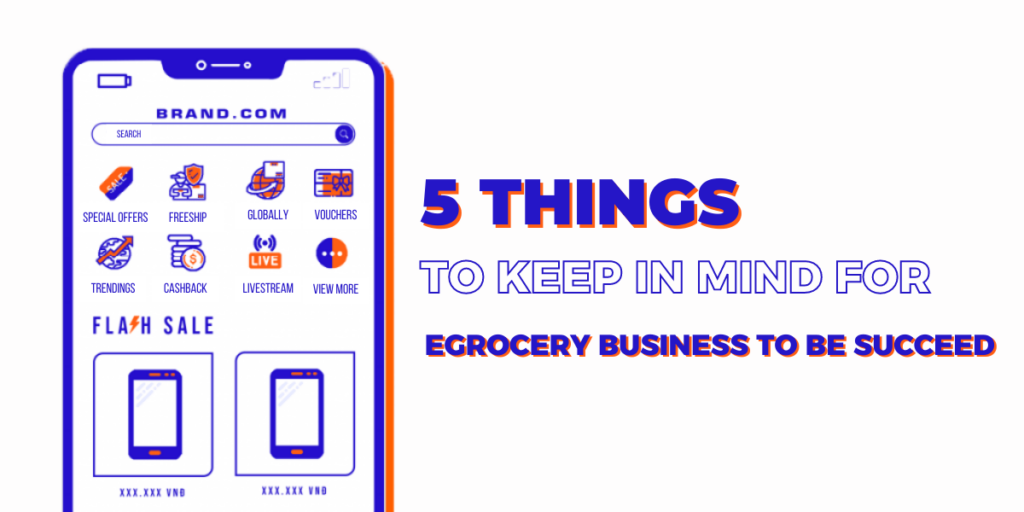
Choose the right eCommerce platform
Choosing the right eCommerce platform is essential for any business, not just the grocery industry. An eCommerce platform compatible with business strategies will help companies save time, accelerate the digital transformation process, and save money on deploying eCommerce websites in both the short and long term. In addition, businesses do not need to switch platforms many times, saving time and budget for recruiting and training personnel to familiarize themselves with the system.
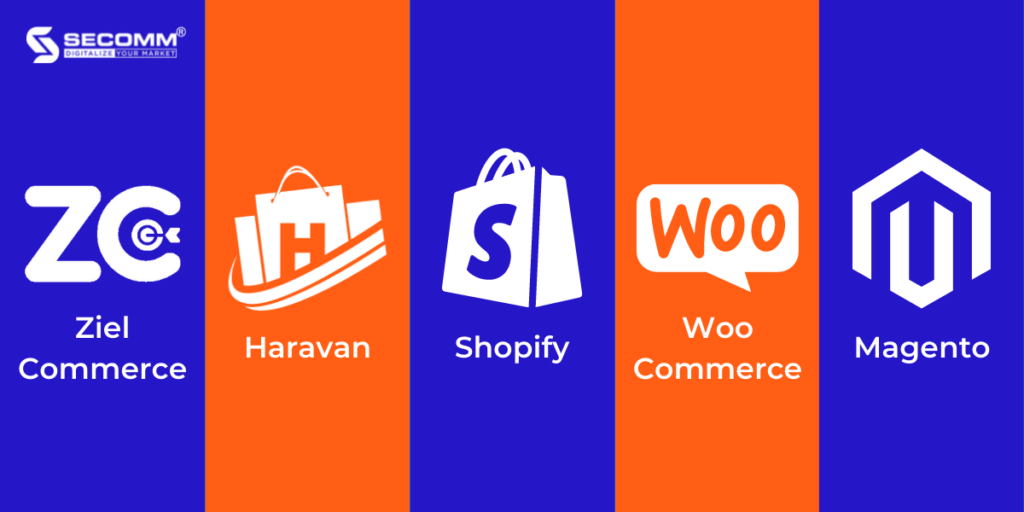
Some grocery business eCommerce platforms include Ziel Commerce, Haravan, Shopify, WooCommerce, and Magento. In particular, Ziel Commerce is a platform designed explicitly for eGrocery businesses.
SaaS platforms like Haravan and Shopify are suitable for SMEs (small and medium enterprises), startups, or new entrants to eCommerce. WooCommerce is ideal for businesses that need to own the source code and customize the website at an affordable cost. The Magento platform is suitable for many different business models (B2C, B2B, B2B2C, etc) and many different business sizes (SME, startup, large corporation, etc).
This platform meets the needs of building an industry-specific eCommerce website under its characteristics, with full ownership of the source code and the ability to customize the website. However, due to the prolonged deployment time and high prices, many businesses are hesitant to use Magento, while many enterprises trust it.
Building a system of industry-specific features
A big problem that egrocery businesses need to pay attention to is that the grocery industry has a relatively complicated operation.
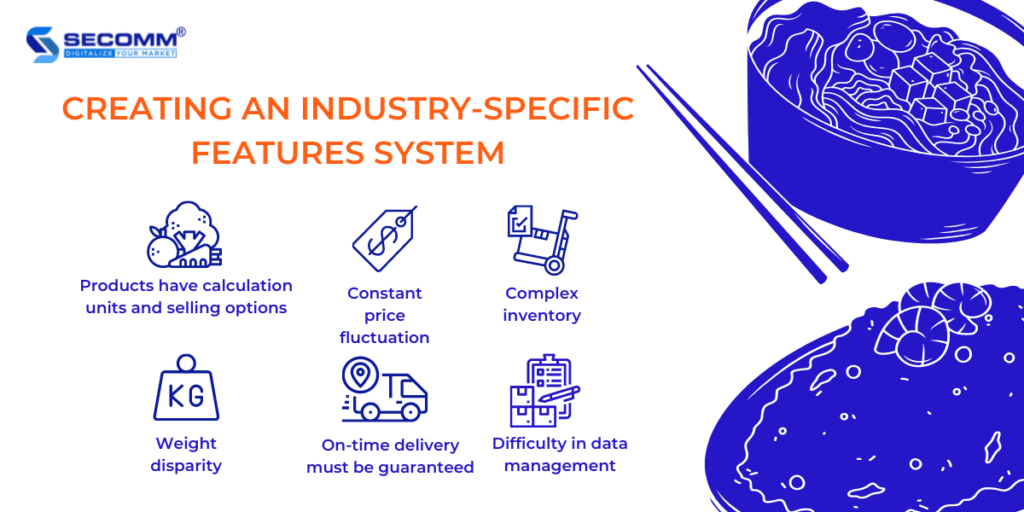
Grocery products have many units of measure, weight differences, and different ways of selling; prices constantly fluctuate and update continuously by day/week/month/year.
The import and export of warehouses are complicated (general warehouse, store warehouse, warehouse for each area in the store), so when deploying an online grocery store, businesses need to synchronize the price and quantity of products so that when restocking, the data will not be lost. Weight and cost data on branches are changed under control, avoiding the lack of synchronization between frontend and backend, causing data processing to be interrupted.
At the same time, grocery products are mainly fresh foods such as meat, fish, eggs, milk, etc, so they need to be refrigerated, delivered quickly, or selected with the correct delivery time.
Handling all the problems in the complex operating process of the grocery industry requires a team of highly qualified IT and eCommerce personnel to design an eCommerce system that is suitable for the specific process and requirements of the business – something current SaaS platforms are not enough to meet.
Enhance customer experience
When running an online grocery store, the user experience requirements are very high; from navigating shopping behavior to the checkout process, order delivery needs to be optimized. Because user experience increases the likelihood of customers placing their first order, it also gives customers more reasons to buy again, contributing to a competitive advantage over competitors in the same industry.
There are many ways for businesses to enhance the user experience, such as layering product categories to navigate customers more intuitively and building specialized functions such as quick add products to cart, fast checkout, search enhancements, and product recommendations based on collected data, etc.
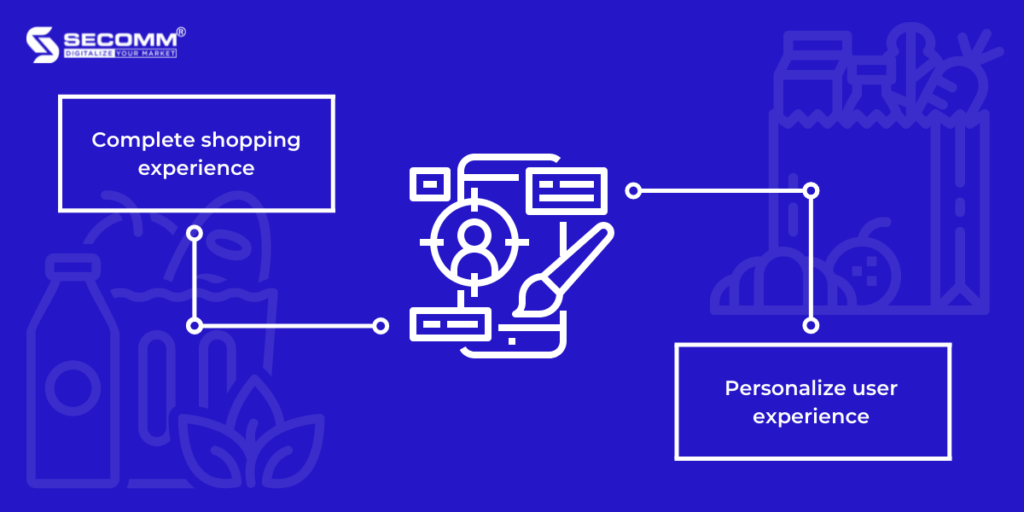
At the same time, personalizing the user experience is an essential factor in the customer’s shopping journey. Businesses exploit, analyze, and leverage data to build the right customer journey, match consumer behavior, and increase the user experience level of personalization.
Personalize from CMS content and display products to navigate the shopping journey for businesses to increase loyalty and customer lifetime value (CLV).
Implement attractive promotions
The secret of doing an online grocery business is building incentive programs suitable for customer segments.
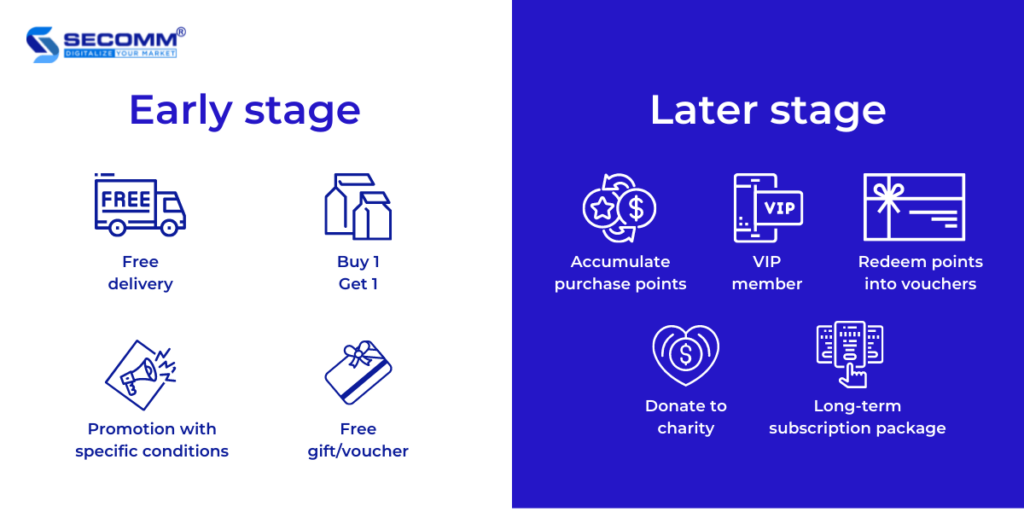
Some popular promotions that businesses can apply in the early stages include free shipping, buy one get one free, gifts/vouchers, or promotions with specific conditions (certain items reach a particular value).
After that, businesses can deploy loyalty programs such as accumulating points for purchases, VIP membership, converting reward points into discount codes, donating bonus points to charities associated with the brand, subscription plans, etc.
Applying omni-channel
Omni-channel is one of the inevitable eCommerce trends in 2022; the application of Omni-channel will help businesses do online grocery business more conveniently.
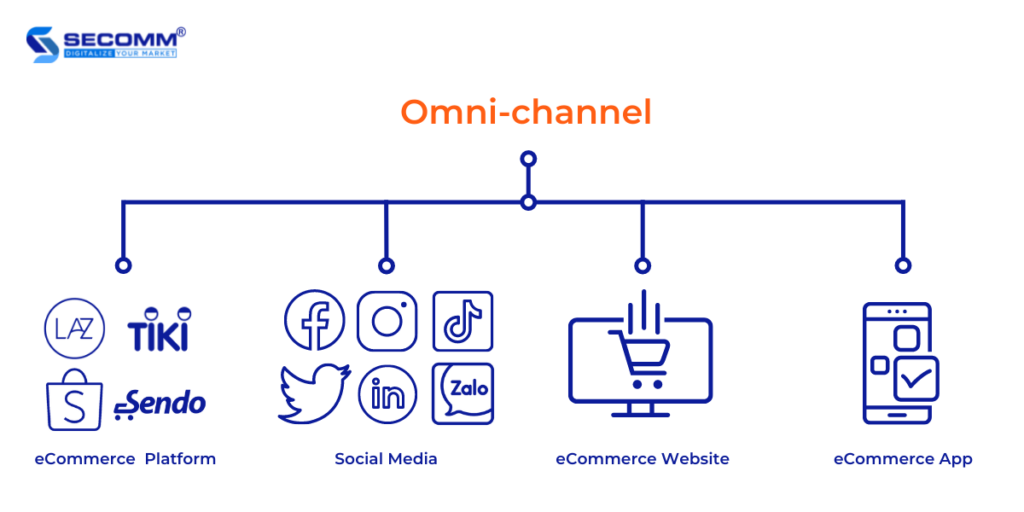
Omni-channel will help customers’ shopping experience be seamless from the physical store to the website, helping businesses follow customers from eCommerce platforms, social networks, websites, etc.
In addition, by collecting and analyzing information from Omni-channel, businesses can efficiently study customer behavior, preferences, and psychology and know whether they are satisfied with the product, service quality, or not to take reasonable measures to change.
It can be said that the grocery eCommerce business has both opportunities and challenges, requiring business managers to think carefully about tactics to make the most effective steps. But, of course, that work is not easy, finding a companion is also tricky, building an in-house team is not easy, and businesses have to pay a lot of opportunity costs and time to reach the “finish line” themselves.
With experience in successfully implementing complex grocery eCommerce systems like An Nam Gourmet, SECOMM understands grocery businesses’ obstacles. Contact SECOMM now for a free consultation on detailed eCommerce system development solutions!
 2
2

 2,782
2,782

 0
0

 1
1
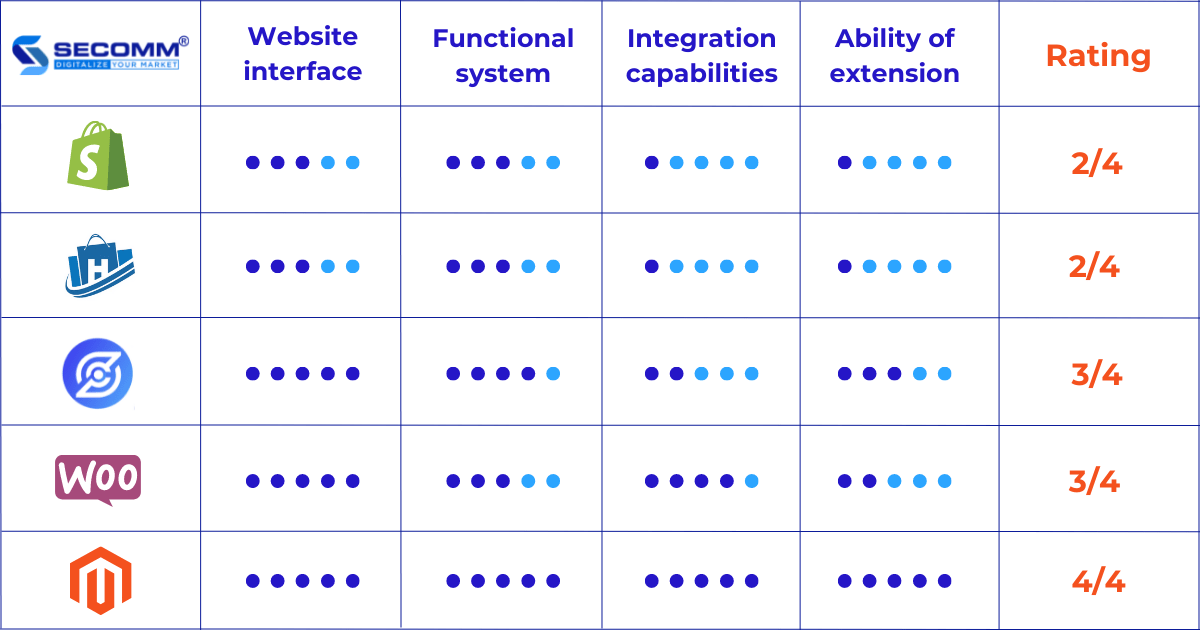
TOP 5 ECOMMERCE PLATFORMS FOR EGROCERY
With the boom in recent years, ecommerce is a potential business form pursued by many businesses, especially egrocery stores. According to Statista, the grocery ecommerce market in the United States is likely to exceed $24 billion by 2023.
Realizing the potential of the egrocery market, several businesses have deployed grocery ecommerce websites early and experienced breakthrough growth, such as Grofers (Blinkit) and BigBasket in India, Bach Hoa Xanh, An Nam Gourmet, Farmer’s Market, WinMart, and Organica in Vietnam.
The common thing that makes the success of the above brands lies in the ecommerce platform. Therefore, to develop and operate an effective ecommerce website, the role of platforms is enormous.
So which ecommerce platforms are suitable for the grocery industry?
Platform selection criteria
User interface and administration interface
For the website interface, in addition to meeting basic needs such as UI/UX standards and showing the brand’s characteristics and the eGrocery industry, businesses also need to focus on the presented product images. Therefore, on the website, everything needs to be synchronized and precise.
The administrator interface (admin) must be easy to use, navigate, control, and manage all data in the system.
Functional system
With eGrocery, the system of ecommerce features needs to be diverse from basic to advanced, solving complex characteristics of the grocery industry such as products with multiple units, weight difference, and price volatility, export-import complex warehouse, and synchronized data throughout the system.
Some functions required in a grocery ecommerce website system such as:
- Primary functions: Meet the most basic needs when operating an ecommerce system, such as order management, checkout, payment, shipping, etc
- Advanced Functions: Functions that enhance the consumer experience and accelerate the shopping process such as order tracking, abandoned cart recovery, similar product recommendations, product search fast products, multi-layered product portfolio, etc
- Specific functions: Functions that help to thoroughly solve the difficulties of implementing specialized grocery ecommerce, meeting the needs of customer segments and businesses such as fast delivery, choice of time delivery point, etc
Integration capabilities
To have a seamless online volatility store system with multiple sales channels, businesses must integrate their ecommerce website with other payment services, shipping services, management software, analysis, report, and distribution systems:
- Payment: Integrate various payment methods from domestic cards to international cards, such as payment gateways (Paypal, Stripe, OnePay), e-wallets (Momo, ZaloPay), etc.
- Shipping: Integrate with international shipping providers like DHL Express, Fedex, Ups, USPS, and popular shipping providers in Vietnam like Fast Delivery, Economy Delivery, Ninja Van, etc. With order tracking applications to help process and operate the delivery processes
- Management software: Easily integrate CRM, ERP, and POS software to get a seamless connection on all supply channels from offline to online
- Analysis and reporting: Integrate analysis and reporting software such as Business Intelligent, Google Analytics, Facebook Pixel, etc.
This integration helps businesses overcome the limitations of the “rice-powered” process, increase the automation of the system, limit business mistakes, and ensure high accuracy and performance.
Ability to extension
To accompany businesses to develop over time, from startups, and SMEs (small and medium enterprises), to large corporations, from B2B, B2C, and D2C business models to B2B2C, commerce electronics platforms must be highly scalable. High scalability helps meet all future business growth needs, such as multi-site, multi-country, and multi-currency, all manageable on “one screen.” Not only that, but highly scalable platforms also support businesses to operate the system stably regardless of the traffic in promotion campaigns.
Evaluate 5 ecommerce platforms for egrocery business based on each criterion
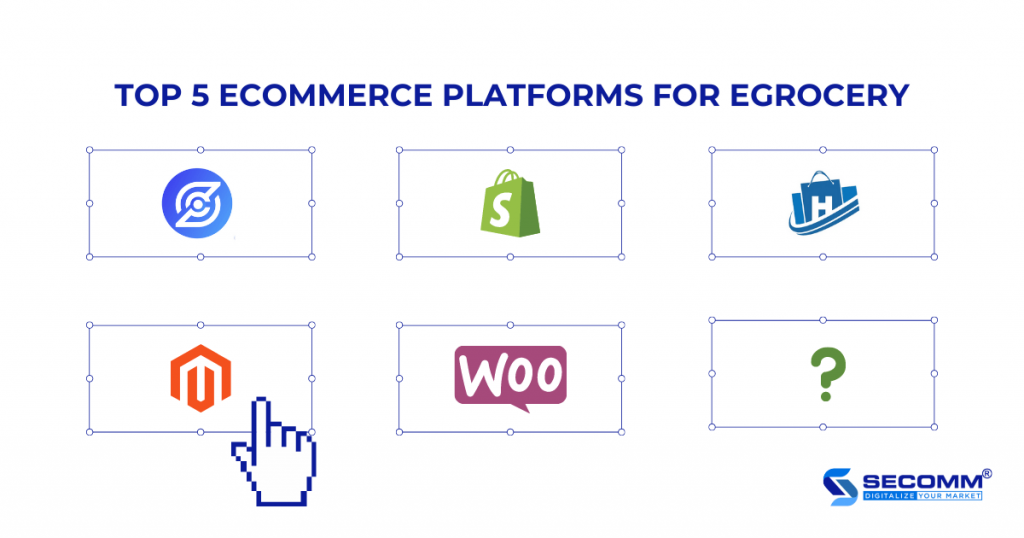
Ziel Commerce
Ziel Commerce is a readymade grocery ecommerce platform with all the features designed to support an online grocery store business.

Website interface
Ziel Commerce provides a repository of themes specifically for the grocery industry, allowing businesses to customize according to their needs, helping to both reflect the characteristics of the industry and position the brand image.
Remarkably, the interface for administrators is also invested by the founders to make it most accessible for businesses to use. But currently, Ziel Commerce is not popular in the Vietnamese market, so there is no Vietnamese version for businesses.
Functional system
As a platform designed specifically for the eGrocery industry, Ziel Commerce can meet all the most specialized needs of businesses, including fundamental to advanced functionality systems and existing industry-specific solutions.
Integration capabilities
Ziel Commerce has a significant drawback in integrating the website system. In addition, this platform only supports add-ons available in its ecosystem, so businesses will not be able to link with the ERP, POS, CRM, BI, etc., systems in use. Therefore, when using Ziel Commerce, companies need to transfer all existing data to the server of this platform.
Ability of extension
Although it does not own the source code, Ziel Commerce is still a highly appreciated platform for its scalability compared to SaaS platforms. Ziel Commerce supports businesses to expand their ecommerce website system from one to many stores/websites, multi-language, multi-currency without many obstacles. However, in the long run, Ziel Commerce cannot support businesses to expand or develop new functions because firms cannot affect the source code; if it affects it, it will cause instability for the commercial website system.
→ Rating: 3/4
Ziel Commerce provides an almost comprehensive online grocery store website building solution for businesses, from website interface and functional system to scalability. However, the implementation cost is relatively high, about $50,000/project in 6 months. Therefore, Ziel Commerce is only popular with retail chains, has high functional demand, and operates mainly abroad. However, when using Ziel Commerce, businesses should consider adding the platform’s integration, limiting instability in the operation when 3rd party systems are not compatible with the platform.
Shopify
Shopify is a SaaS ecommerce platform favored by the international ecommerce business community because of its fast implementation time and reasonable starting cost.
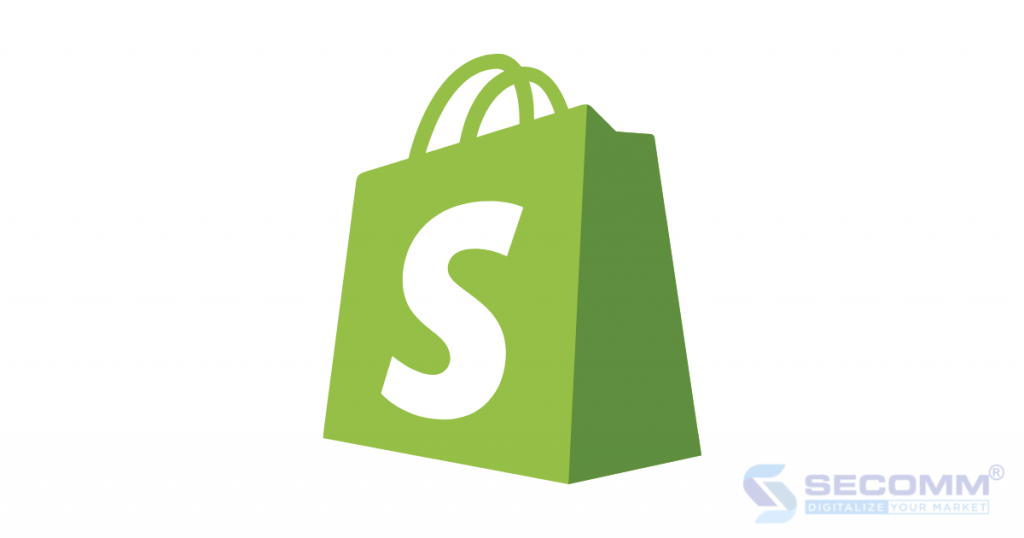
Website interface
Shopify provides a variety of interfaces, including grocery industry and UI/UX standards, but cannot be edited according to the characteristics of the business.
Functional system
Shopify’s functional system is relatively complete, meeting the basic needs of businesses. But to use advanced functions, companies have to pay a certain amount of money every month, leading to an increased cost of using the functional system. In addition, even Shopify can barely provide eGrocery industry-specific resolution functions.
Integration capabilities
Because it is a SaaS platform, businesses cannot affect the source code, and it is not easy to integrate with many 3rd parties. Companies can only integrate utilities provided by Shopify or a platform partner.
Some utilities that companies can integrate with Shopify include:
- Payment: Paypal, Stripe, SagePay, AliPay Global, etc
- Shipping: DHL Express, USPS, UPS, etc
- Administration: Microsoft Dynamic 365 (ERP), Oracle NetSuite (ERP), Acumatica (ERP), etc
- Marketing: Google Tools, MailChimp, Facebook Pixel, etc
Ability of extension
Similar to the ability to integrate, the scalability on Shopify is not high because businesses cannot influence the source code to edit and upgrade the website. Therefore, online grocery businesses can only use Shopify for the first time.
→ Rating: 2/4
Shopify is only suitable for businesses new to the ecommerce market, startups, or SMEs (small and medium enterprises) because of the reasonable development cost and time to deploy an online grocery store business website.
Haravan
Founded in 2014, Haravan is an ecommerce platform based on Shopify. Currently, Haravan is a popular platform in the Vietnamese market with more than 50,000 business people and trusted brands.
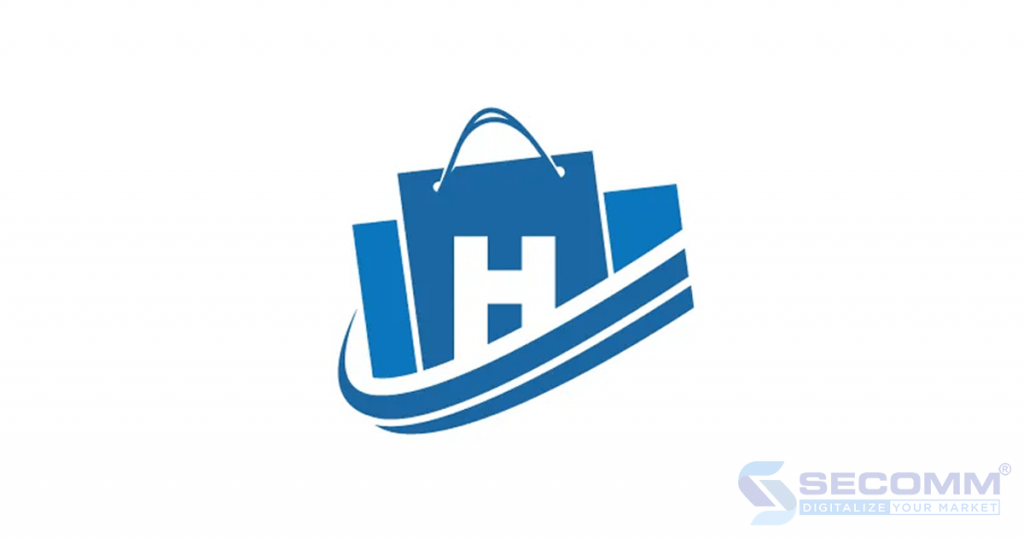
Website interface
Haravan has many standard UI/UX interfaces suitable for the grocery industry, including free and paid. At the same time, the interface for administrators supports Vietnamese and is easy to use, so businesses do not face many difficulties when using it.
Functional system
Haravan provides many utilities – functions for online grocery stores in Vietnam.
In addition, similar to Shopify, to use more advanced functions, businesses have to pay a monthly application fee of about 100,000 VND/month/app.
However, businesses can’t find parts that deal with the grocery’s specifics in Haravan’s app store and can’t develop in terms of specific functions. Enterprises can only use the functions included in the package and app store.
Integration capabilities
For integration capabilities, Haravan can integrate with Haravan’s partners such as transportation (Economic Delivery, Fast Delivery, Ahamove, GrabExpress, etc.), payment (Ngan Luong, VNPAY, Napas, PayPal, etc.), etc.).
It is difficult for businesses to integrate for 3rd party utilities outside Haravan’s ecosystem on their ecommerce website.
Ability of extension
As for the extension of the ecommerce website system, Haravan can only support the multi-language – currency but cannot expand from one to many websites/stores. It is challenging to manage all the data on a foundation.
As the business gradually grows and expands, Haravan will no longer be functional enough to maintain an online grocery store business. As a result, companies are forced to switch to more specialized platforms such as Magento, WooCommerce, and OpenCart. But, of course, switching platforms will create many other problems such as costs, time, personnel, etc.
→ Rating: 2/4
Similar to Shopify, Haravan is only suitable for businesses new to the ecommerce market, startups, and SMEs. But Shopify can support online grocery business globally, and Haravan only stops at the Vietnamese market.
Woocommerce
WooCommerce is an open-source platform in the form of a WordPress plugin, allowing businesses to use it completely free.
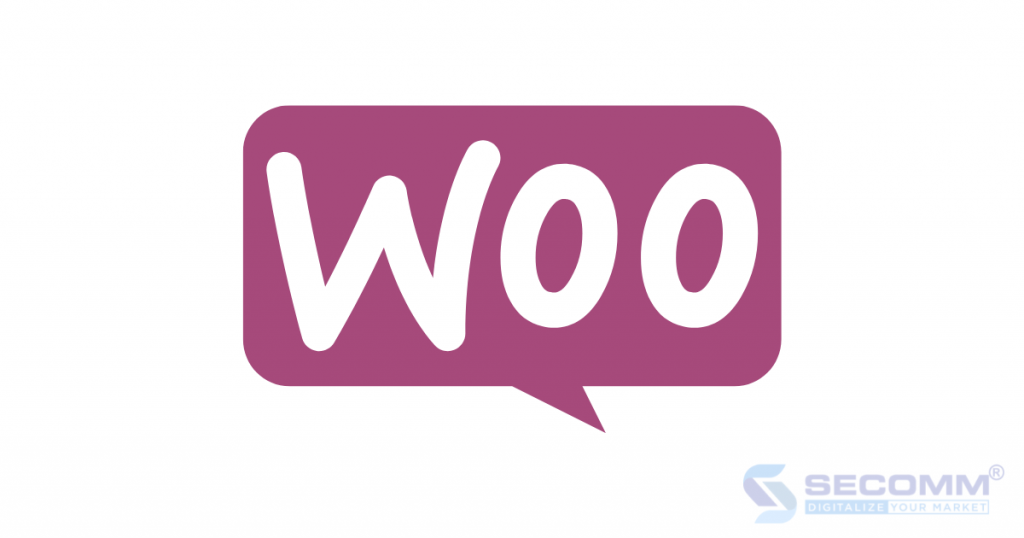
Website interface
WooCommerce and the community provide businesses with various themes designed for the grocery industry. At the same time, this platform also allows influencing the source code to customize according to needs, helping businesses quickly convey brand messages and images.
Since WooCommerce is a WordPress plugin, the admin will continue to manage the website on the WordPress interface itself. This makes it easy for businesses using WordPress to adapt, use, and navigate on the WooCommerce dashboard.
Functional system
WooCommerce supports a variety of features, from basic to advanced. However, this platform has some limitations on features specific to the grocery industry because interfering with developing these functions will easily cause instability for the website system.
Integration capabilities
Thanks to the advantages of the open source platform, WooCommerce has flexible customization capabilities and supports integration with many 3rd party utilities.
In payment, businesses can use amount plugins such as Stripe, PayPal, Apple Pay, and Square to their ecommerce website system with high security and safety. In addition, companies can integrate with many shipping providers such as Fedex, Ups, USPS, and DHL Express. The WooCommerce platform also allows businesses to integrate with management software such as Odoo, Square POS, WP ERP, and Marketing software such as Google Listings, Google Ads, and Facebook Pixel to support businesses in effective business management. More fruitful.
Ability of extension
Contrary to the integration capabilities, the extensibility of WooCommerce is not appreciated. Because the system is easily overloaded with plugin themes, and the number of products does not exceed 2000 SKUs (Stock Keeping Unit). Therefore, businesses wishing to expand their website system need to consider when using this platform in the long run.
→ Rating: 3/4
WooCommerce is the right platform for grocery businesses that use WordPress and are looking to develop an ecommerce system. But when using WooCommerce, companies should consider the limitations of integration, extensibility, and customizability of specific features.
Magento
Magento is a popular open source commerce platform in ecommerce, with nearly 200,000 websites in use. Currently, Magento has 2 versions: Magento Open Source (free) and Magento Commerce (paid).
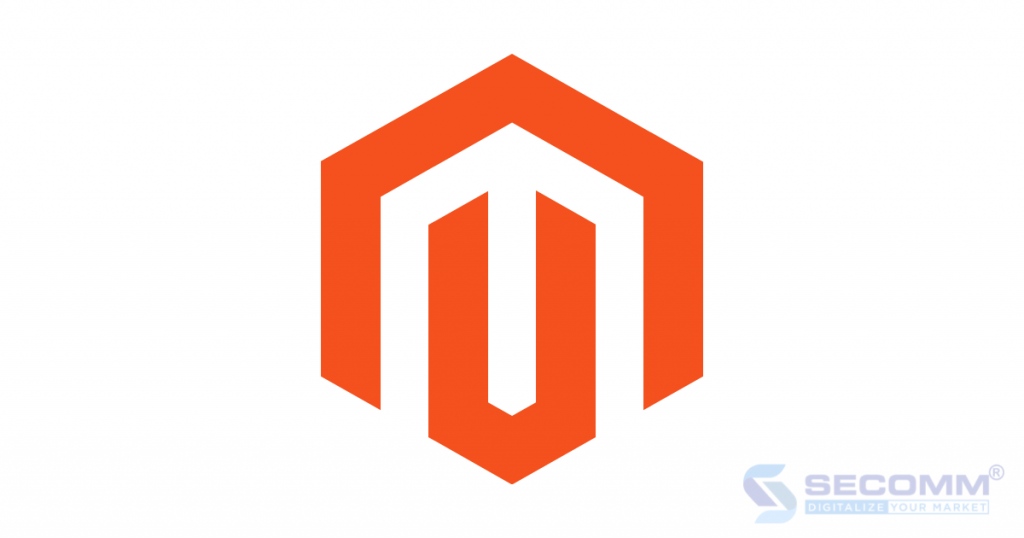
Website interface
Although Magento does not own a rich theme store like other ecommerce platforms, businesses can look to the developer community, market (Envato), or design their own. Having many options when designing the interface helps Magento websites to have their uniqueness, avoid overlapping the interface with many different websites and bring a higher shopping experience.
Previously, the admin interface on Magento 1 was often considered difficult to use and took a long time to adapt. As a result, Magento publishers developed Magento 2 with a more intuitive and easy-to-navigate dashboard to overcome this problem.
Functional system
The Magento platform has a highly diverse system of features from basic and advanced to industry-specific to help grocery businesses quickly build and develop a sustainable system.
A basic functional system, including catalog management, product management, customer management, report analysis, etc., helps meet the basic needs of a convenient online grocery store business.
In particular, Magento also has many advanced functions for ecommerce, such as multi-language support, multi-currency, multi-store, PWA, MSI, ElasticSearch, etc. Shopping happens faster.
Magento does not have built-in features only for the grocery industry regarding specific features. Still, businesses can quickly build a system of particular features such as category classification, quick search, and delivery time selection thanks to flexible customization on open source code.
Integration capabilities
Thanks to the advantages of the open source platform, the Magento website can be easily integrated with any 3rd party utilities, from payment, shipping, and business administration.
Regarding payment, Magento easily connects with today’s popular payment methods such as card payments (domestic cards, VISA, Mastercard), e-wallets (MOMO, Zalopay), and payment gateways (OnePay, VNPay, etc.) PayPal) or COD, which helps to diversify payment methods.
Magento can integrate with shipping providers such as Fast Delivery, Economy Delivery, Viettel Post, and order tracking applications.
Magento can be integrated into back-office management software (ERP, CRM, POS) such as SAP, Salesforce, and Oracle to help operate all resources and processes seamlessly in the enterprise.
In addition, Magento also supports integration with business analysis tools such as Power BI, Tableau, and Looker and analysis and reporting utilities such as Google Analytics, Google Tag Manager, and Facebook Pixels to exploit all data from the system. As a result, Magento plans to improve its business strategy.
Ability of extension
Magento allows businesses to expand from one website to many different websites on the same system to meet the needs of business development. In addition, with the available support for language and currency conversion from Magento, businesses can build a grocery ecommerce system with content suitable for a diverse audience of customers around the globe.
In addition, open source customization enables Magento developers to build functional solutions specific to the grocery industry. This advantage makes Magento expand the system of capabilities according to each business size, from small businesses to large-scale corporations.
→ Rating: 4/4
Because Magento possesses many outstanding advantages, from website interface and functional system to the ability to integrate and expand, Magento is suitable for a variety of grocery business models from B2B, B2C to B2B2C, a multiform of enterprise-scale such as startup, SME, enterprise (large corporation). However, the time to deploy ecommerce on Magento is usually long – from 6 months to 1 year, with high construction costs of about 50,000 – 100,000 USD/project. At the same time, businesses also need to have a professional team or cooperate with experienced units to develop an effective grocery ecommerce system. Therefore, Magento is popularly used in the community of large-scale businesses that need many functions to increase user experience.
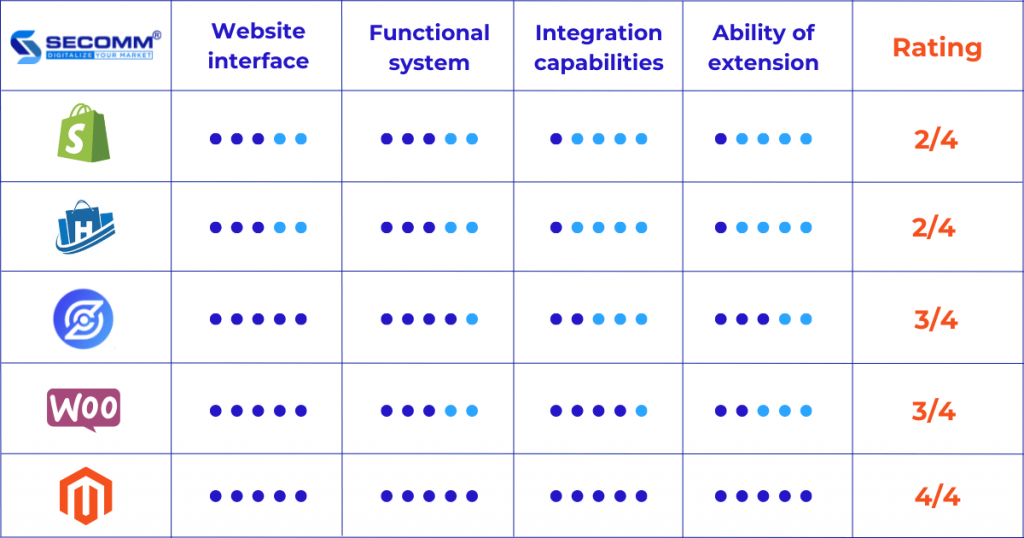
Choosing the right platform is the first and most significant step when building a grocery ecommerce website. Selecting the right ecommerce platform will help businesses save budget and time in building a website while increasing competitive advantage and sustainable growth. On the contrary, choosing the wrong forum will cost businesses a lot of time and budget to deploy and switch platforms. Therefore, companies need to consider the goals and problems in the current model to choose the most suitable platform.
With experience in successfully implementing complex grocery ecommerce systems like An Nam Gourmet, SECOMM understands grocery businesses’ obstacles.
Contact SECOMM now for a free consultation on detailed ecommerce system development solutions!
 2
2

 1,957
1,957

 1
1

 1
1





